- Subject List
- Take a Tour
- For Authors
- Subscriber Services
- Publications
- African American Studies
- African Studies
- American Literature
- Anthropology
- Architecture Planning and Preservation
- Art History
- Atlantic History
- Biblical Studies
- British and Irish Literature
- Childhood Studies
- Chinese Studies
- Cinema and Media Studies
- Communication
- Criminology
- Environmental Science
- Evolutionary Biology
- International Law
- International Relations
- Islamic Studies
- Jewish Studies
- Latin American Studies
- Latino Studies
- Linguistics
- Literary and Critical Theory
- Medieval Studies
- Military History
- Political Science
- Public Health
- Renaissance and Reformation
- Social Work
- Urban Studies

Victorian Literature
- Browse All Subjects
How to Subscribe
- Free Trials
In This Article Expand or collapse the "in this article" section Travel Writing
Introduction, general overviews.
- Reference Works
- Women Travelers
- Bibliographies
- Travel and General
- Special Issues
- Research Societies
- Victorian Travel Writing and Postcolonial Theory
- Biographical and Literary-Biographical Accounts
- Central Critical Debates
- Recent Scholarship
- Women and Space
- Space and Motion
- Colonial Anthropology
- North America
- Latin America
- Australasia and the Pacific
- The Caribbean and West Indies
- The Middle East and Arabia
- Polar Exploration
Related Articles Expand or collapse the "related articles" section about
About related articles close popup.
Lorem Ipsum Sit Dolor Amet
Vestibulum ante ipsum primis in faucibus orci luctus et ultrices posuere cubilia Curae; Aliquam ligula odio, euismod ut aliquam et, vestibulum nec risus. Nulla viverra, arcu et iaculis consequat, justo diam ornare tellus, semper ultrices tellus nunc eu tellus.
- David Livingstone
- Emigration and Nineteenth-Century British Colonial Settler Narratives
- Life Writing
- Mary Seacole
- National Identity
- The Christian Church
- Whiteness in Victorian Literature
Other Subject Areas
Forthcoming articles expand or collapse the "forthcoming articles" section.
- Caribbean/West Indies
- Missions and the British and Irish Churches: 1701–c.1900
- Photography
- Find more forthcoming articles...
- Export Citations
- Share This Facebook LinkedIn Twitter
Travel Writing by Muireann O’Cinneide LAST REVIEWED: 24 July 2018 LAST MODIFIED: 21 November 2012 DOI: 10.1093/obo/9780199799558-0099
Fueled by transport improvements and expanding British global influence, Victorian travel writing emerged in the period as a commercially popular and successful genre, which became a predominantly middle-class preserve. Journeys of missionaries and merchants fostered colonial expansion, while as the British Empire grew in scope, so too did the travels of its administrators and soldiers. Increasing popular interest in scientific, geographical, and anthropological research meant that travelogues could serve as accounts of individual experience, instructions for future travelers, advice on imperial administration, religious admonition, reports on scientific discoveries, or a combination of all these possibilities. Many prominent Victorian novelists also wrote travel accounts (as well as incorporating elements of their travels in their fiction): the best-known of these include Charles Dickens (b. 1812–d. 1870), Anthony Trollope (b. 1815–d. 1882), and William Thackeray (b. 1811–d. 1863). The late Victorian period of imperial expansion saw a particularly close relationship between travel writing and the successful colonial adventure stories of writers such as Henry Rider Haggard (b. 1856–d. 1925), Rudyard Kipling (b. 1865–d. 1936), and Robert Louis Stevenson (b. 1850–d. 1894). Individual travelers such as the adventurer and scholar Richard Burton (b. 1821–d. 1890), the missionary David Livingstone (b. 1813–d. 1873), and the explorer Henry Morton Stanley (b. 1841–d. 1904), became near-legendary figures. Widening opportunities for travel extended also to women such as Isabella Bird (b. 1831–d. 1904) and Mary Kingsley (b. 1862–d. 1900). Until recent decades, Victorian travel writing received relatively little critical attention, possibly due to the ambiguity of its generic status. Increased interest from the 1970s onward in literature’s involvement in cultural and political constructions enabled more attention to be paid to travel writing as a genre. This was particularly the case for postcolonial studies: ironically, enhanced critical awareness of the implication of travel and travel writing in colonial power structures gave it new life as a serious object of academic study. Initially positive “recoveries” of travelers who were comparatively marginalized figures in Victorian society, such as women, gave way to more wary considerations of the rhetorical work performed by their texts. Whereas earlier criticism considered travel writing in the context of the politics of representation, particularly in relation to the depiction of intercultural contact, more recent work has emphasized the fluidity of its genre positioning and the implications of the act of travel for individual, national, and spatial concepts of identity. There has also been greater critical concern with countering the metropolis-periphery model of British Victorian travel writing by investigating the works of travelers from different locations within the empire, and their accounts of journeys to other colonies and to England itself.
This section is intended to offer a selection of texts that would make good starting points for undergraduate students approaching the scholarly analysis of travel writing as a genre, although the texts listed are also valuable sources for academics engaged in ongoing research. Hulme and Youngs 2002 opens up a wide-ranging understanding of travel writing’s history and its critical contexts. Blanton 2002 is a useful introduction, although students are directed if possible toward the more up-to-date Thompson 2011 , which gives an assured foundation for critical analysis of the genre. The introduction and essays in Clark 1999 provide a readable and accessible consideration of the ideological relationships between travel writing and empire. The essays in Hooper and Youngs 2004 coalesce the formal features that characterize the genre while highlighting the ongoing debates about such categorization, or whether travel writing even exists as a genre (see also Genre ). Leask 2005 is a concise overview of travel writing’s changing critical fortunes that would benefit an undergraduate commencing study in the field.
Blanton, Casey. Travel Writing: The Self and the World. 1995 . London: Routledge, 2002.
Introductory overview from classical times to the 20th century. Offers a useful critical survey (pp. 1–29), considering historical development, influence on other genres, and cultural studies, together with detailed chapters on individual travel writers, including Mary Kingsley (pp. 44–58). Also offers an annotated bibliography and detailed suggestions for further primary and secondary reading.
Clark, Steve, ed. Travel Writing and Empire: Postcolonial Theory in Transit . London: Zed, 1999.
A good introduction for students and scholars wishing to understand the relationship between travel writing and empire. The essays place travel writing from the early modern period up to the late 20th century in relation to modern models of analysis, emphasizing the genre’s complicity with violent acts of incursion.
Hooper, Glenn, and Tim Youngs, ed. Perspectives on Travel Writing : Studies in European Cultural Transition . Aldershot, UK: Ashgate, 2004.
Essay collection engaging with the fluidity of travel writing as a formal genre, as well as its varying contexts, from the early modern period to the late 20th century. The editors’ introduction (pp. 1–12), and the chapters by Borm (pp. 13–26) and Youngs (pp. 167–180) provide useful commentaries on the state of the field.
Hulme, Peter, and Tim Youngs, eds. The Cambridge Companion to Travel Writing . Cambridge, UK: Cambridge University Press, 2002.
DOI: 10.1017/CCOL052178140X
Crucial introductory text divided into “Surveys” (pp. 17–104), historical contexts 1500 to 2000; “Sites” (pp. 103–222), geographical locations; and “Topics” (pp. 225–278), gender, ethnography and theories. Hulme and Youngs’s “Introduction” (pp. 1–16) establishes critical contexts; for Victorian writing see Roy Bridges on “Exploration and Travel Outside Europe, 1720–1914” (pp. 53–69) and Helen Carr on “Modernism and Travel” (pp. 70–86).
Leask, Nigel. Introduction. “ Journeys of Discovery .” eSharp 4 (Spring 2005): 1–4.
Short piece encapsulating the development of scholarship on travel writing.
Thompson, Carl. Travel Writing . The New Critical Idiom. London: Routledge, 2011.
Introductory guide that both new students of the genre and scholars doing ongoing research are recommended to consult, particularly with regard to questions of definition and formal qualities. Outlines key definitions and debates, gives a broad historical overview, and considers canonical and marginal texts.
back to top
Users without a subscription are not able to see the full content on this page. Please subscribe or login .
Oxford Bibliographies Online is available by subscription and perpetual access to institutions. For more information or to contact an Oxford Sales Representative click here .
- About Victorian Literature »
- Meet the Editorial Board »
- Adventure Literature
- Aestheticism
- Allen, Grant
- Arnold, Matthew
- Arts and Crafts Movement
- Atheism and Secularization
- Autobiography
- Barnes, William
- Barrett Browning, Elizabeth
- Blind, Mathilde
- Boucicault, Dion
- Braddon, Mary Elizabeth
- Britain in Latin America
- Brontë, Anne
- Brontë, Charlotte
- Brontë, Emily
- Broughton, Rhoda
- Browning, Robert
- Burton, Richard Francis
- Butler, Samuel
- Caird, Mona
- Carlyle, Thomas
- Catholicism and Anti-Catholicism
- Childhood in Victorian Literature
- Children's Literature
- Christian Church, The
- Clough, Arthur Hugh
- Cobbe, Frances Power
- Collins, Wilkie
- Conan Doyle, Sir Arthur
- Conrad, Joseph
- Corelli, Marie
- Crime and Punishment
- Culture, Visual
- Dickens, Charles
- Disraeli, Benjamin
- Domesticity
- Dowson, Ernest
- Du Maurier, George
- Ecology in Victorian Literature
- Eliot, George
- Emigration and Nineteenth-Century British Colonial Settler...
- Epic Tradition, The
- Eugene Lee-Hamilton
- Evangelicalism
- Fairy Tales and Folklore
- Fiction, Detective
- Fiction, Sensation
- Field, Michael
- Fin de Siècle
- FitzGerald, Edward
- Flora Annie Steel
- Food and Drink
- Gaskell, Elizabeth
- Gosse, Edmund
- Haggard, H. Rider
- Hardy, Thomas
- Historical Novel, The
- Homosexuality
- Hopkins, Gerard Manley
- Illustration
- James, Henry
- Keble, John
- Kingsley, Charles
- Kipling, Rudyard
- Lang, Andrew
- Le Fanu, Joseph Sheridan
- Lear, Edward
- Lee, Vernon
- Livingstone, David
- Macaulay, Thomas Babington
- Marryat, Florence
- Martineau, Harriet
- Masculinity
- Material Culture
- Mayhew, Henry and the Mayhew Brothers
- Meredith, George
- Mill, John Stuart
- Monologue, Dramatic
- Morris, William
- Myth and Victorian Literature
- Neo-Victorianism
- New Woman, The
- Newgate Novel, The
- Newman, John Henry
- Oliphant, Margaret
- Orientalism
- Owen, Richard (Victorian Naturalist)
- Oxford Movement, The
- Pater, Walter Horatio
- Periodical Press, The
- Raphaelitism, Pre-
- Reade, Charles
- Reading Practices
- Reynolds, G. W. M.
- Robins, Elizabeth
- Rossetti, Christina
- Rossetti, Dante Gabriel
- Ruskin, John
- Rymer, James Malcolm
- Schreiner, Olive
- Science Fiction
- Seacole, Mary
- Sentimentality
- Serialization
- Sexual Violence
- Silver Fork Novel (Fashionable Novel)
- Slavery and Antislavery
- Slum Fiction
- Socialism and Labor
- Social-Problem Novel
- Stevenson, Robert Louis
- Stoker, Bram
- Supernatural, The
- Swinburne, A.C.
- Symonds, John Addington
- Tennyson, Alfred
- Thackeray, William Makepeace
- The Ghost Story
- Thomson, James (B.V.)
- Tonna, Charlotte Elizabeth
- Travel Writing
- Trollope, Anthony
- Trollope, Frances
- Tyndall, John
- Unitarianism
- Verse, Devotional
- Webster, Julia Augusta
- Wells, H. G.
- Wilde, Oscar
- Women's Education
- Wood, Ellen (Mrs. Henry Wood)
- Work, The Gospel of
- Yonge, Charlotte
- Zangwill, Israel
- Privacy Policy
- Cookie Policy
- Legal Notice
- Accessibility
Powered by:
- [66.249.64.20|81.177.180.204]
- 81.177.180.204
A Visitor's Guide to Victorian England
Michelle higgs' guide to the weird and wonderful world of victorian england.

VICTORIAN TRAIN TRAVEL
A few weeks ago, I visited the amazing National Railway Museum in York for the first time. If you’ve never been, it’s definitely worth the trip – you don’t have to be mad about trains! There are some fascinating exhibits relating to the Victorian era, the expansion of the railways in Britain and how the passenger experience changed.
Victorian railways reinforced the Victorian social structure with a choice of first and second class carriages; third class was not offered until late 1838. At the National Railway Museum, it was wonderful to see some early surviving carriages from this era for the Bodmin & Wadebridge Railway. There is a composite first and second-class carriage that would originally have been exclusively first-class. The first-class passengers had upholstered seats while in second-class, they had to make do with wooden seating. You can sit in the second-class section of the composite carriage which gives an amazing feel for the past and how little legroom there would have been, even without the added problem of voluminous petticoats and crinolines!
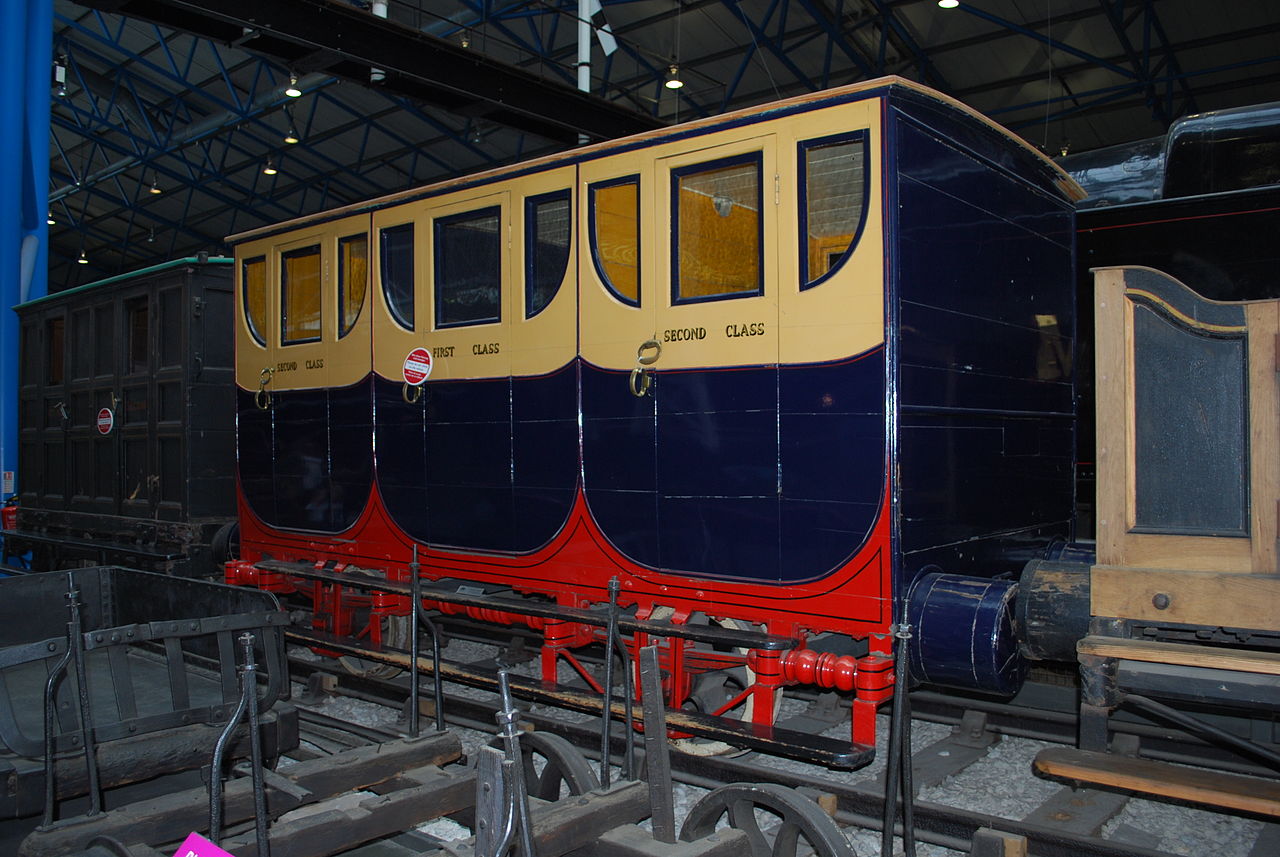
This is what an ordinary second-class carriage would have looked like with a window in the door only:
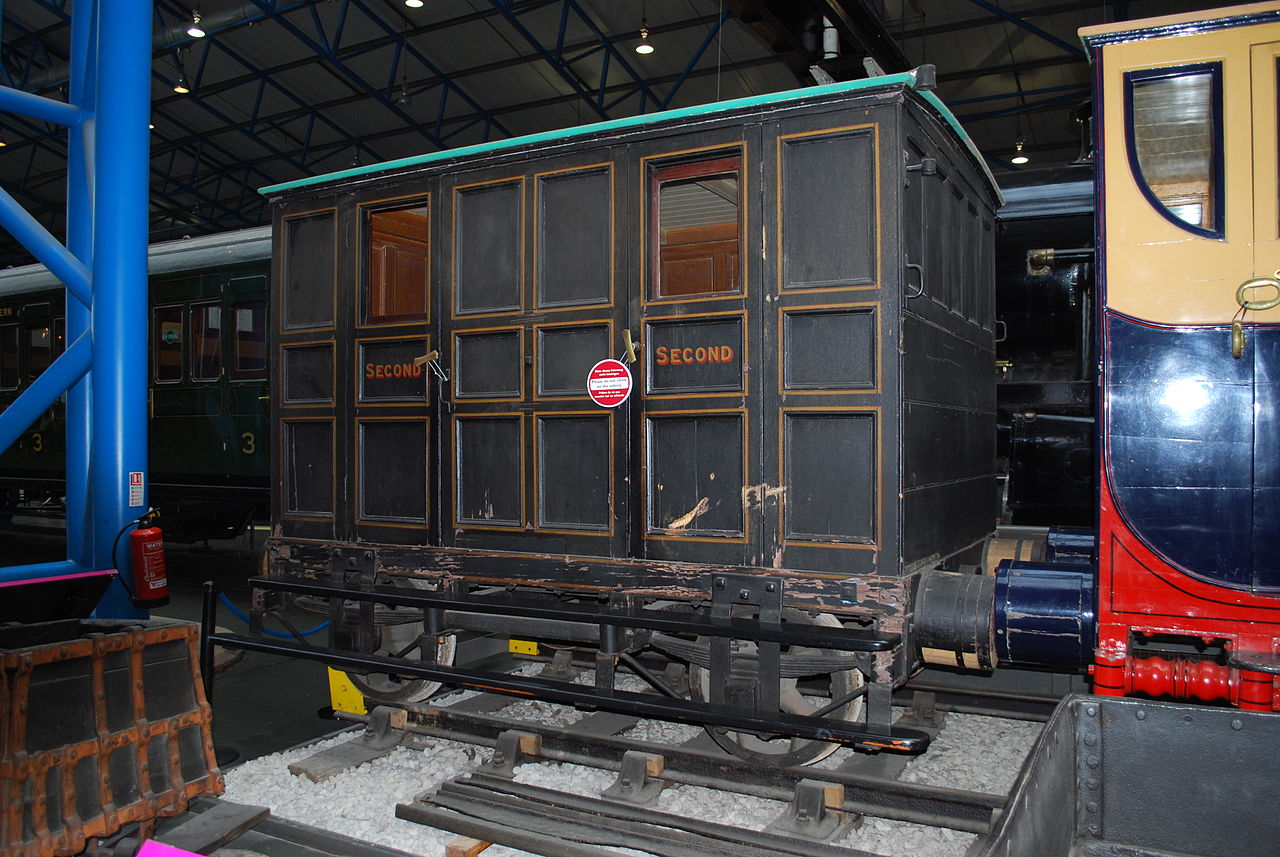
Coupled next to the composite carriage is the third-class accommodation, more reminiscent of a cattle truck than a carriage.
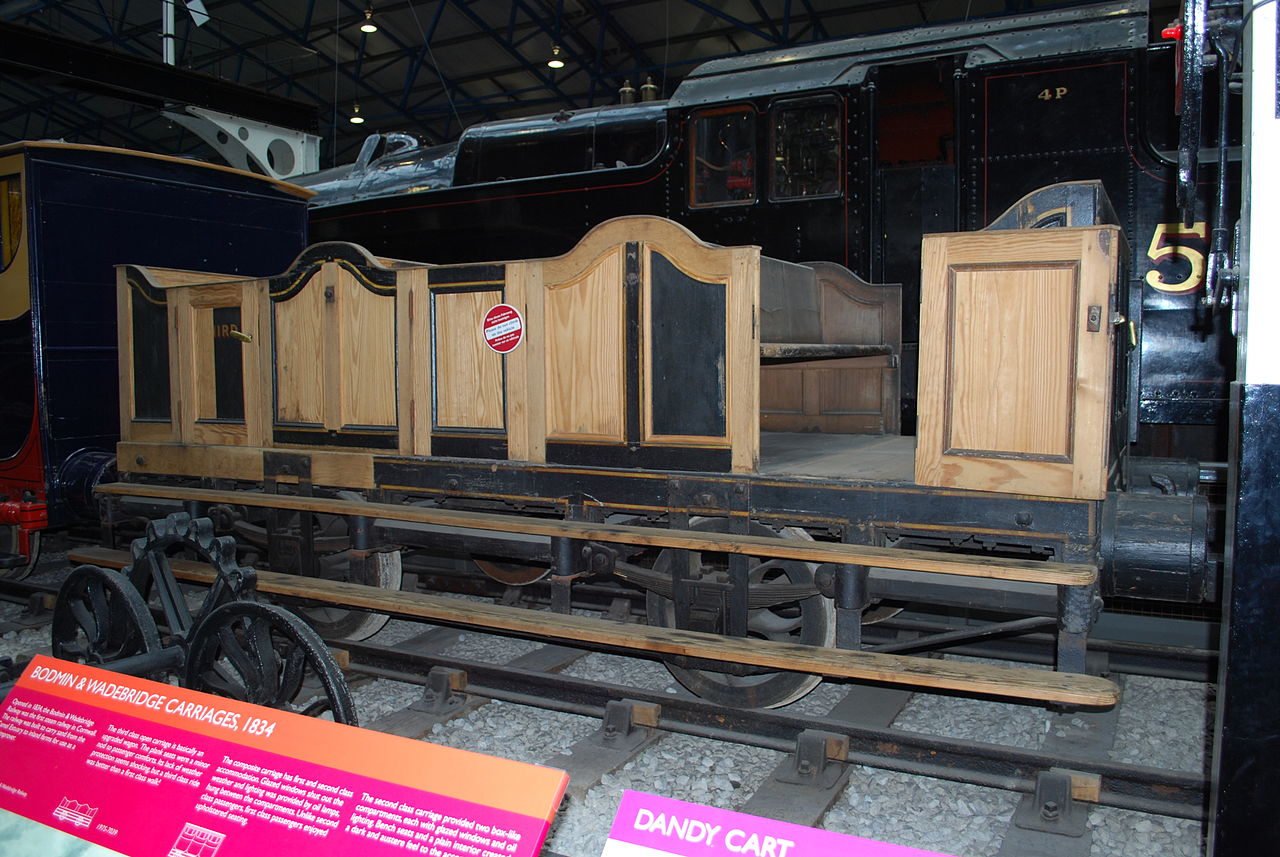
Dating from 1896, this image captioned ‘the oldest rolling stock in England from the Bodmin & Wadebridge Branch, London & South Western Railway, in use for fifty years ‘ may show the same or similar carriages to those in the National Railway Museum:
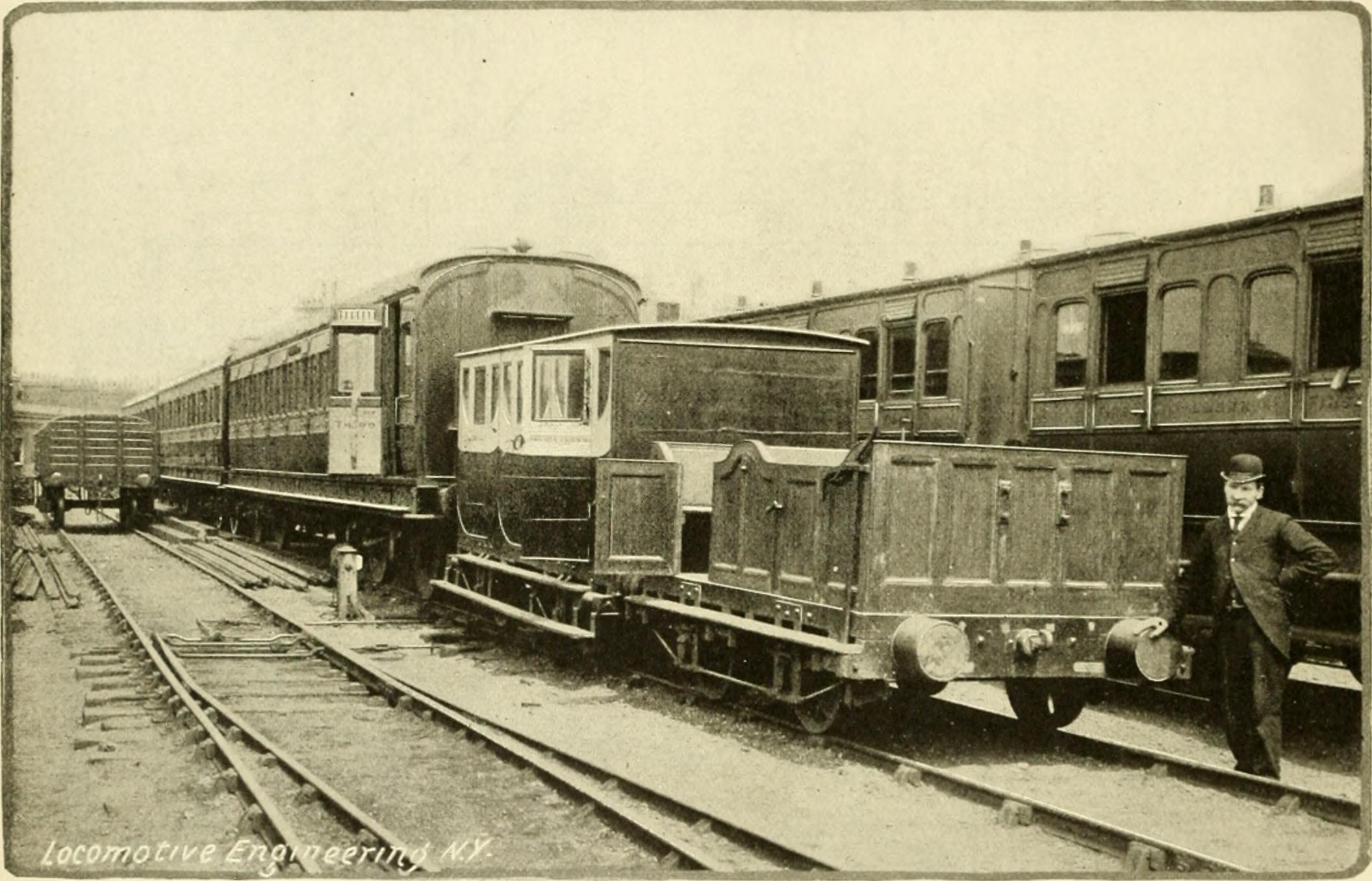
Passengers travelling by train in the 1830s and 1840s had to be a hardy lot. Compartments were unheated, even in first class, although there was a foot warmer for these better-off passengers. In The Early Victorians at Home , Elizabeth Burton describes how noxious these carriages were at night, as they were illuminated ‘by an evil-smelling and dripping oil lamp fixed in the roof’. The cushions in first-class carriages were also inclined to catch the dust from the steam engine.
Second-class carriages had a roof but were open at the sides. Wrapping up warm with a rug, cap and cloak was essential, as was an umbrella. ‘A Constant Traveller’ wrote to the Leicester Chronicle in 1843 about the ‘miserably cold and wretchedly devised carriages’. He commented: ‘The day was windy and wet, the rain poured in so heavily that a pool of water above an inch deep deluged the floor, and…most of the passengers…were wet through, not being provided with any protective clothing.’
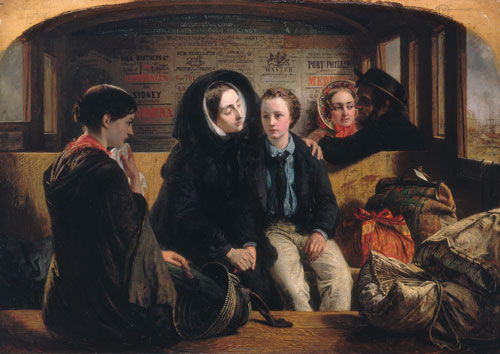
The early third-class carriages were little more than cattle trucks with no roof and hard wooden seats. This mirrored the experience of third-class passengers on the top of a stagecoach, but railway travellers also had to contend with the hazards of smoke, soot and cinders.
A passenger travelling from London to Liverpool via Birmingham on the Grand Junction line wrote to the Leeds Mercury in 1841, complaining of the third-class accommodation: ‘I witnessed several instances in and near the carriage in which I was placed, of clothing, umbrellas &c being burnt and utterly spoiled by the ashes from the engine, some pieces the size of a walnut being precipitated, red-hot, into the midst of us. In fact, on arriving at Birmingham, if the seat and floor of that part of the carriage in which I rode had been swept, not less than half a pint of cinders might have been gathered.’
Despite the sub-standard accommodation, railway travel was hugely popular. According to the Railway Times , in the first six months of 1839, the London to Birmingham railway carried 267,527 people. In eight months, the line between Sheffield and Rotherham attracted 330,000 passengers. The Morning Chronicle (1844) reported: ‘Last week, some of the Yorkshire railways offered the public of the West Riding a trip down to Liverpool and back for a few shillings a place, and though the accommodation in the carriages was no better than that given to cattle on the Liverpool and Manchester line, yet no less than five thousand persons availed themselves of this opportunity of visiting Liverpool and the sea!’
After 1844, railway companies were forced to provide roofs on all third-class carriages under new legislation. At least one train every weekday had to run for third-class passengers, stopping at every station along the line. From this time, lighting was also provided in third-class carriages although there was only a single oil lamp per carriage, compared with several in each first-class carriage.
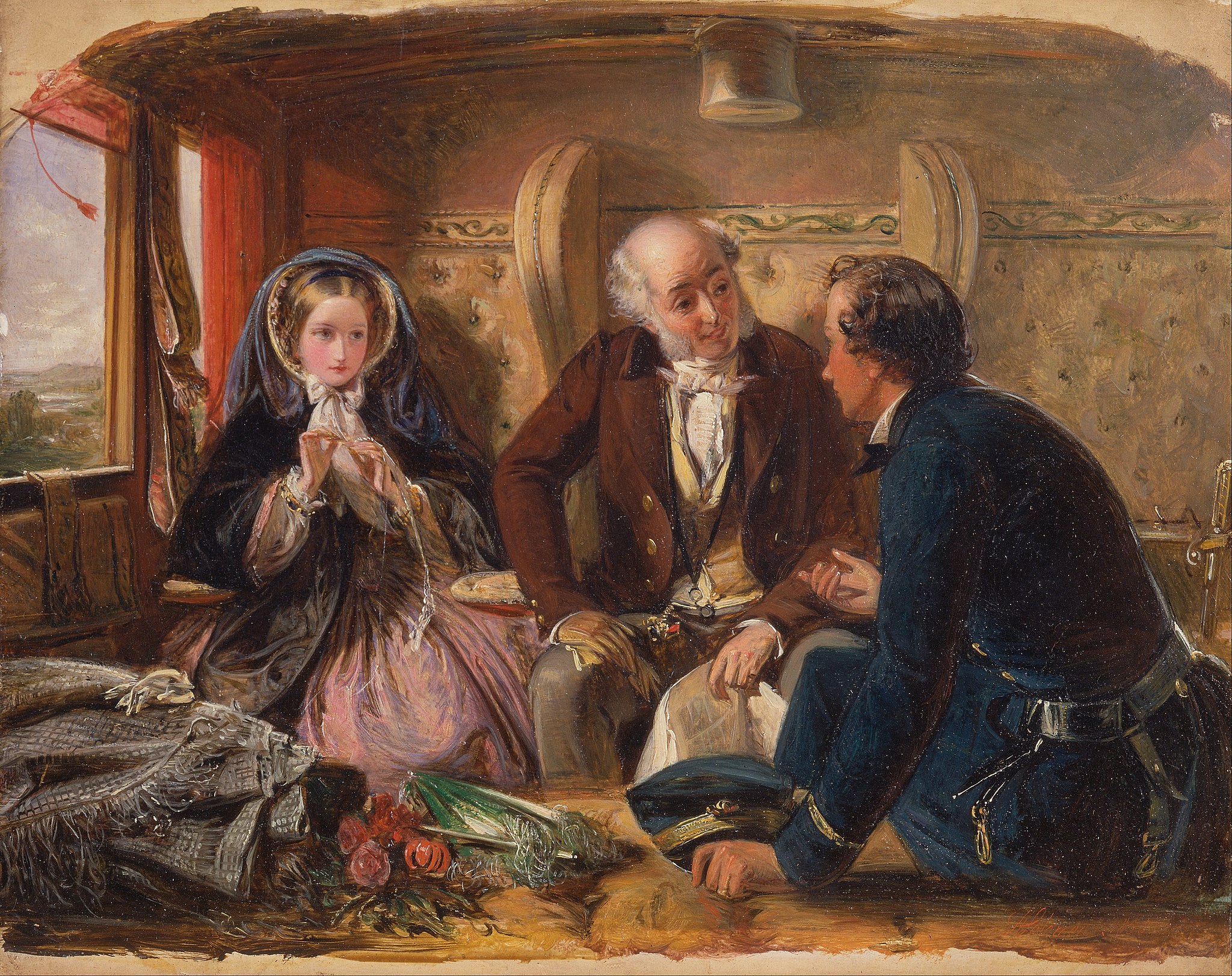
Before 1868, it was not possible for passengers to communicate with the guard if they had a problem, and it was not until the 1890s that they could walk from one compartment to another along a corridor. The corridor walkway became more common after the early 1900s when lavatories started to be introduced on trains. In 1875, the Midland Railway abolished second-class travel altogether and upgraded third-class passengers to second-class standards; it also reduced the fares in first class. Other railways followed suit to keep up with the competition. Around the same time, dining cars were introduced for wealthy passengers. Later in the nineteenth century, long distance trains started to offer refreshment baskets for the less well-off.
Please note: this post contains affiliate links for the British Newspaper Archive .
Share this:
Leave a comment cancel reply.

- Already have a WordPress.com account? Log in now.
- Subscribe Subscribed
- Copy shortlink
- Report this content
- View post in Reader
- Manage subscriptions
- Collapse this bar

Although advances in steam packets would explode international travel in the mid to late 1800s, the Regency and early Victorian/late Georgian eras still saw some international travel. Wars abroad, including the Napoleanic Wars saw modified travel routes around areas of conflict (Suntikul, 2013). Although the Grand Tour went through a slow down during war time, its resurgence after the wars into the early Victorian era also ushered in “a more formalized tourist industry” (Towner, 1985, p.297).
The Grand Tour is typically talked about as an exclusively male activity, but frequently women and children would accompany gentlemen on their travels (https://www.york.ac.uk/media/eighteenth-century/cecsatthekingsmanor/Conference%20Abstracts.pdf). For an inspirational article about trailblazing women travelers: https://www.theguardian.com/travel/2016/mar/08/top-10-inspiring-female-travel-adventurer or there is this post about women travelers: https://www.rbkc.gov.uk/leightonarabhall/travel2.html . We also did a post several years ago on Lady Hester Stanhope .
Limited travel abroad saw more activity in the U.K., with visitors flocking to not only Spa Towns but also far flung locations (at least by a carriage) like Scotland and Wales. Limited travels also took place the U.S.A., Canada, Central and South America, Ireland, and the West Indies. For women traveling during the 19th century outside of the UK, I recommend the book Women, Travel, and Science in Nineteenth Century Americas (citation below) which focuses on the travel writer Frances Calderon de la Barca (nee Erskine Inglis) who was well known for her 1843 book Life in Mexico and Elizabeth Cabot Agassiz, an American naturalist and writer who traveled to Brazil.
Travelling generally around the world boomed during the early to late Victorian era. According to Stowe (1994), “many nineteenth-century Americans traveled, and many more participated vicariously in the experience of travel by reading travel letters, sketches, and narratives in newspapers, magazines, and published volumes” (p. 3). Similarly, the appetite for travel in the U.K. was also voracious and included print media when travel was not possible. Railroads made local, regional, and UK travel more accessible and affordable, with quicker speeds.
Take the Grand Tour Online: http://www.umich.edu/~ece/student_projects/grandtour_tourism/grandtour.html
Read about the Grand Tour:
https://www.regencyhistory.net/2013/04/the-grand-tour.html
https://janeaustensworld.wordpress.com/2008/04/14/the-grand-tour-in-the-18th-19th-century/
https://www.bl.uk/picturing-places/articles/a-royal-armchair-traveller-the-grand-tour-and-the-kings-topographical-collection
Gerassi-Navarro, N. (2018). Women, Travel, and Science in Nineteenth-Century Americas: The Politics of Observation. (n.p.): Springer International Publishing.
MELISH, J. (1818). Travels through the United States of America, etc. United Kingdom: J. Smyth.
Stowe, W. (1994). Going Abroad: European Travel in Nineteenth-Century American Culture . PRINCETON, NEW JERSEY: Princeton University Press. doi:10.2307/j.ctt1m3nzrr
Suntikul, W. (2013). Tourism and War. United Kingdom: Taylor & Francis.
Towner, J. (1985). The Grand Tour: A key phase in the history of tourism. Annals of Tourism Research, Voume 12, Issue 3, pp. 297-333.
Share this:
- Click to email a link to a friend (Opens in new window)
- Click to share on Facebook (Opens in new window)
- Click to share on LinkedIn (Opens in new window)
- Click to share on Reddit (Opens in new window)
- Click to share on Twitter (Opens in new window)
- Click to share on Tumblr (Opens in new window)
- Click to share on Pinterest (Opens in new window)
Comments are closed.
- Search for: Search OK
Recent Reviews

Authors, Books by Heat, and More Content
Regency history categories.
- Regency Advertisements
- Regency Crime and Punishment
- Regency Culture and Society
- Regency Customs
- Regency Destinations
- Regency Dish
- Regency Economy
- Regency Estates
- Regency Events
- Regency Fashion
- Regency Film and TV
- Regency Folklore
- Regency Health and Medicine
- Regency Hot Spots
- Regency Household
- Regency Literature
- Regency Men
- Regency Mystery
- Regency Non-Fiction
- Regency Pastimes
- Regency Reader Questions
- Regency Science and Invention
- Regency Travel
- Regency Villains
- Regency Women of Character
- Regency Words
- Representing Regency
Slang and Phrases of the Regency

The early reviews are in: "The Dictionary/Thesaurus is amazing! It’s perfect and easy to search and sort. Wonderful job!" - Julie B
Love, Most Ardently

For Love or Money, Who will have the Last Word?
Enjoy our content? Buy us a coffee!

If you love our content, consider buying us a cup of coffee. Thank you for being a Regency Reader!
Download for Free!

Wondered what the weather temps were like in Regency England? Or curious about significant weather events? Download our free database, created at Regency Reader request!
Follow Regency Reader
Get every new post delivered to your Inbox
Join other followers:
Victorian Era
From Georgian to Edwardian
Victorian Era Transportation: Brougham, Barouche, Wagons, Drays, Landau carriage,Trains,Buses
During the initial years of the Victorian period, majority of the people travelled by road either on foot or by using horse-drawn vehicles. In fact, the horse-drawn vehicles were one of the crucial sources of commuting.
Table of Contents
Victorian Brougham
Brougham was another mode of transportation which was used for daily travelling. The vehicle obtained its name after the man who designed it, Lord Brougham. It was either a two-wheel or a four-wheel vehicle. It was a light weighted vehicle and was drawn by a horse.
Victorian era Barouche
The aristocratic families or the upper class families generally used barouche which was a four-wheel carriage having a fold-up hood. The seats in the carriage faced each other. Open vehicles like Wagons and drays were a mode of transport used by country people.
These vehicles were large and heavy as compared to the carriages and their weight made them slow. Wagons and drays were used for carrying goods. But even people and animals could travel in it.
Victorian era Bicycles
By the late 1800s, bicycles were popular and widely used for commuting. As it was a personal transport, women could wear clothing suited the cycling activity. Phaeton was an open carriage drawn by horses. It was light and had four-wheels. It was liked by the ladies who drove it through the parks.
Victorian Phaeton
Phaeton got its name from the son of Greek sun-god Helios who was known for his driving the sun-chariot badly. Another vehicle known as Landau carriage was used for travelling. It was originally named in Germany and named after the town which made it. It was regarded as a status symbol and thus was expensive.
These carriages were either open or had folding top. During the last few years of the Victorian reign, cars were manufactured and run on the roads. These became the mode of transport. The first car or horseless carriage was seen in 1865. These cars were a rarity until 1880s and 1890s. These cars being manufactured in less quantity were expensive and thus only the rich could afford it.
The Victorian period is known for the industrial developments that brought about changes in the Victorian society- socially and economically. Steam engines were being used to run trains, ships, and buses. Railways were an easy mode of commuting. People used railways for going to out-station trips for holidays or even for normal trips.
The trains were thus a popular source of transportation. The first steam railway that was made was the Liverpool and Manchester Railway in 1830. It had different compartments like first class and second class. Sometime around 1854, every town, big or small was connected by trains. In 1863, first underground railway was started in England which enabled people to travel between London and other places.
Vintage Home
- Edwardian Houses
- Edwardian Interior
- Costume Rental
- Georgian Lighting
- Victorian Furniture
- Fabric Colours
- Floral Arrangement
- Victorian Tables
- Bedroom Designs
- Victorian Lamps
How the Victorians invented the ‘staycation’
Lecturer in Victorian literature and culture, University of Bristol
Disclosure statement
Joan Passey does not work for, consult, own shares in or receive funding from any company or organisation that would benefit from this article, and has disclosed no relevant affiliations beyond their academic appointment.
University of Bristol provides funding as a founding partner of The Conversation UK.
View all partners
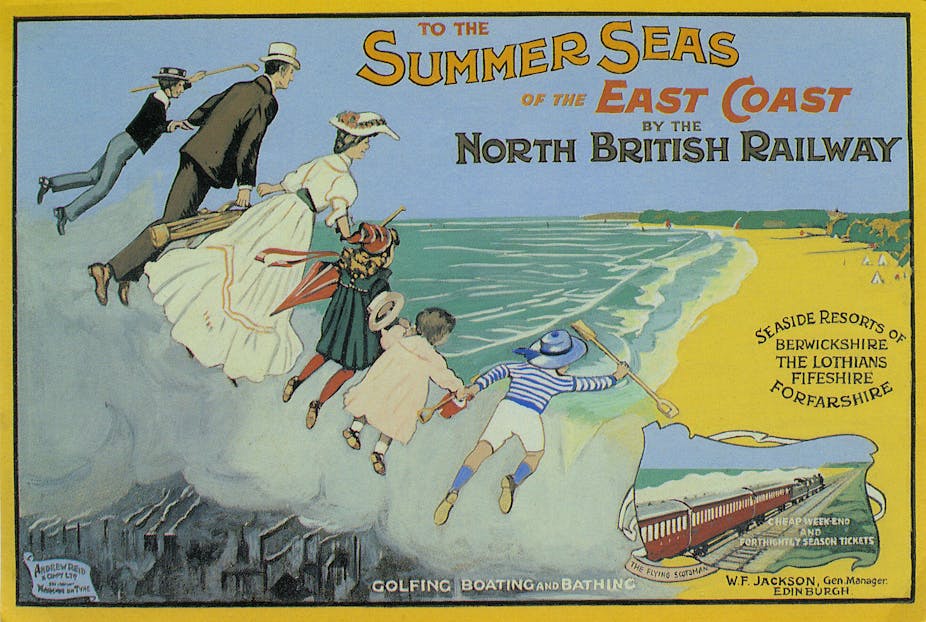
Holidays feel like an important tonic after such a tough year. While international travel is possible, it’s not exactly easy, so many are choosing to stay closer to home, opting for a “staycation”. This year holidaymakers are discovering the treasures of the UK’s coast and the rugged beauty of its landscapes.
Domestic tourism as we know it began in the 19th century when the idea of the holiday was just becoming popularised. Expanding railways and changing work practices meant people had more leisure time to dedicate to travelling. International travel was becoming easier but wasn’t accessible to all, so the Victorians chose to spend this newfound “free” time in the UK.
This gave way to the creation of hot new holiday destinations, mostly on the UK’s coast. Great British seaside towns, from Bournemouth to Brighton, enticed people with promises of fun, sea and clean air – many of the things that continue to lure people today.
The great summer holiday as we know it was conceived by the Victorians . The 19th century saw the industrial revolution and the rise of industrial capitalism, where factories were thriving and work structures were more clearly and rigorously defined and delineated. This led to the emergence of administrative professions, like clerks, and an emerging middle class .
There was more structured working time , including shift work in factories and time off on Sundays. As a result, working-class people had leisure time to use, and by the 1890s some skilled workers had half days on Saturdays, leading to the birth of the “ weekend ” – though this was not formalised until much later in the 20th century.
In 1871 the Bank Holidays Act was passed. This designated certain days as holidays on which banks closed, though, over the years, more businesses began observing these days off work. Before 1830, banks closed only on the 40 saints’ days of the year, though by 1834 this was just four days, including Christmas day. From 1871, any day could be declared a bank holiday, not just saints’ days.
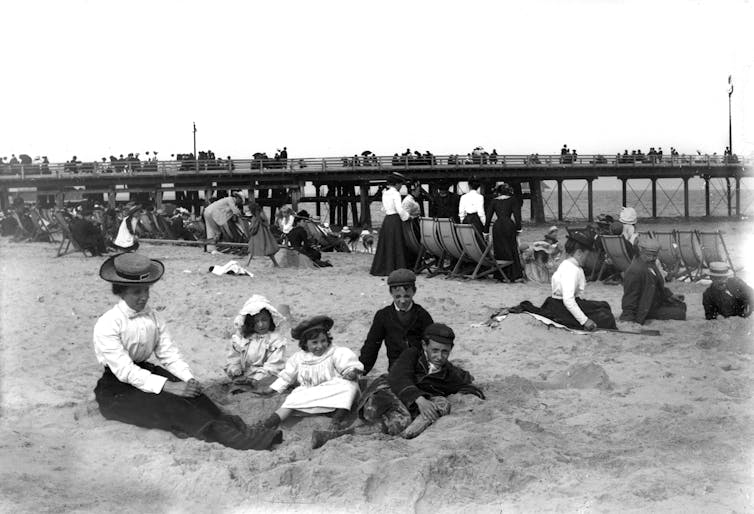
These new leisure hours were used to explore the surrounding countryside and seaside as cities expanded at exponential rates . The working class took day trips and the wealthy stayed in hotels along the coast, many of which still stand today.
Travel was previously only accessible to the wealthy, but an expanding rail network meant that travel across Britain was easier, faster, cheaper and more accessible than ever before. The railway boom began in the 1840s , and by 1850, 6,000 miles of track had been laid and 18,000 by 1880. This meant that smaller towns were connected, as well as big cities.
The rise of mass print literature went hand in hand with the rise of the railway – British train station stalwart WH Smith was established to sell cheap books to train passengers, a brand new audience, as it was previously too bumpy to read on a carriage or cart.
That a greater variety of people could access the margins of the country than ever before caused a lot of anxiety among the upper classes. Poet William Wordsworth famously protested the expansion of the rail into the Lake District, the site that inspired some of his most famous poems, as he thought its beauty would be tainted and that the poor did not have the capacity to appreciate its sublimity.
There was also anxiety that the railway and encroaching tourists would spoil seemingly untouched regions. Protesters in Cornwall thought tourism would dilute the country’s particular identity, language, history and culture. This is not dissimilar to anxieties about tourists buying holiday homes in Wales and Cornwall today.
Tourism is born
An emerging tourist industry meant emerging tourist boards eager to promote UK travel over increasingly accessible foreign travel. By 1870, the Great Eastern Railway was publishing advertisements for “A Day at the Seaside”.
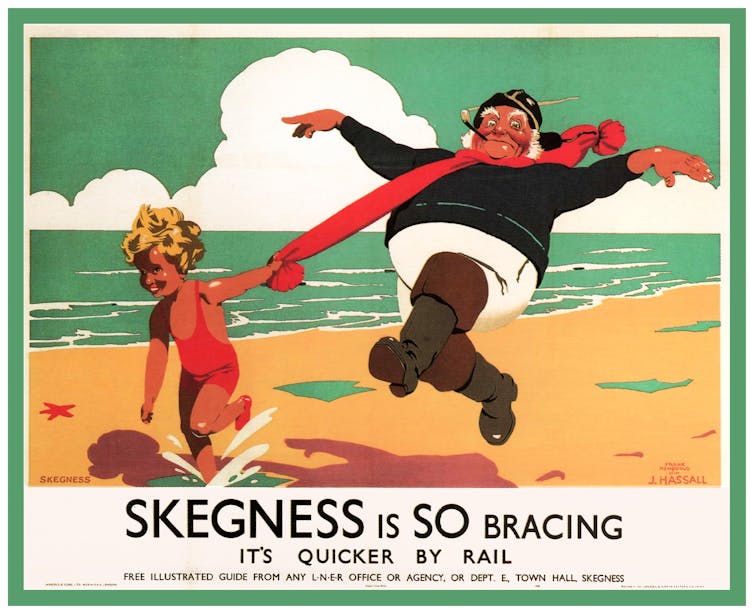
Places in the UK were sold as being somewhat exotic or foreign – Cornwall was called “the Cornish riviera” and maps of Cornwall were flipped upside down and displayed next to maps of Italy to show their similarities.
As a result, sunny seaside resorts were developed by investors – Bournemouth, Brighton, Weston-super-Mare and Blackpool, to name a few. Their influence can still be seen in finely wrought piers, promenades and pavilions of these seaside towns, which have gained renewed popularity during the COVID pandemic.
As seaside getaways became popular, many of the things we associate with the British summer holiday came to be, including deckchairs, ice-cream, donkey rides, Punch and Judy shows (violent puppet shows primarily aimed at children), rock (a hard sugar candy), and games arcades.
Ice-cream became very popular in the 19th century and was a welcome cool treat on summer beaches, as the Victorians developed icehouses (essentially deep wells) to store ice and keep it cool. Queen Victoria had her preferred clear ice imported from Massachussets, USA . Many popular ice-cream flavours might feel unfamiliar to us today, such as cucumber ice-cream.
The tourism that emerged, however, wasn’t always sunshine and deckchairs – one of the first Thomas Cook holiday packages in the 19th century was a railway journey to Bodmin Jail where passengers could look out of the window to witness hangings from the comfort of their own carriage.
While a day out to see hangings or a scoop of cucumber ice-cream may not be quite up modern holiday seekers’ street, many of the things that the Victorians popularised remain a huge part of a British holiday today. So, while enjoying a stick of rock or a game on the pier, spare a thought for the pioneering Victorians who made some of the best bits of your much-needed holiday possible.

Project Officer, Student Volunteer Program

Audience Development Coordinator (fixed-term maternity cover)

Lecturer (Hindi-Urdu)

Director, Defence and Security

Opportunities with the new CIEHF
- International edition
- Australia edition
- Europe edition
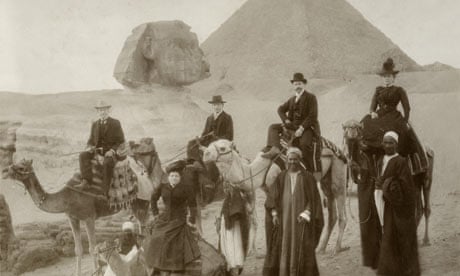
The original top 10 holiday destinations
B y 1825, the opening up of the European and American continents to steam rail meant that travel was no longer the preserve of the extremely wealthy. The romantic ideal of the Grand Tour had permeated the public consciousness, and now for the first time, such travel was a possibility for the middle classes as well.
While British beach resorts such as Blackpool began to develop to cater for holidaymakers of all social strata - at Scarborough spa, the wealthy rubbed shoulders with the working classes - former cabinet-maker Thomas Cook was masterminding what would become the world's first package tour.
First, he led groups from his native Leicester around the British Isles, arranging their accommodation and travel, and charging them a single rate. In 1855 he took a group to Paris for the Great Exhibition, and following the success of that tour, he led groups around Europe, to the Middle East, and to America, opening each route as a set itinerary for people to follow.
A new version of the Grand Tour, a kind of proto-gap year, was becoming a necessary part of education for the well-off middle classes, and chaperoned group tours for unmarried young women, unheard-of just decades earlier, were becoming available. The first holidays snaps were starting to appear, too: as cameras became more portable, travels could be more easily documented, and memories preserved.
In 1869 the Suez Canal was completed, opening up the Far East to cheaper and safer shipping. By that time, the middle classes had followed the royal families of Britain, France and Spain to the seaside resorts on the French and Italian Riviera. A long stay in the Alps was a recognised recuperative aid for the infirm or ill, and mountain sports such as skiing were becoming popular as well.
Tourism as we know it today had been born.
10 popular 19th-century destinations
1. nile river cruise.
For the first half of the century, Nile cruising was limited to wooden sailing vessels known as Dahabiyyas, which were slow. As the era of archaeological discovery in Egypt began to gather momentum, tourists wanting to follow in the footsteps of the Egyptologists – and the looters – were able to charter local steam-vessels. By the late 1880s, as more and more archaeological finds were being made, Thomas Cook introduced larger, more opulent steam-ships. Described by a journalist as "the most luxurious vessels to sail the Nile since Cleopatra's barge", they ploughed the Nile from Cairo all the way to Aswan.
2. Paris via Brussels and the Rhine
Thomas Cook began operating his European tours in the middle of the century, opening the continent up to a whole new market: the middle classes. His first European tour was a wide circle ending with four days in Paris for the 1855 exhibition. After that, the route was open permanently: starting in Brussels, tourists could cruise down the Rhine from Cologne to Mainz then head to Paris by rail via Frankfurt, the casinos at Baden-Baden, Weisbaden castle and Strasbourg. This tour was consistently one of Cook's most popular: by the end of the century, thousands of tourists were making the journey each year.
3. Davos, Switzerland
Davos became famous as a health resort after Alexander Spengler, a German country doctor and political refugee, popularised the notion that the mountain air in the valley carried significant medical benefits, and opened a clinic. As the resort grew in the latter part of the century, it began to see the rise of a new trend: skiing. One of the pioneers of the fledgeling sport was Sir Arthur Conan Doyle, who on 20 March 1894 became the first Englishman to cross the 2,440m Maienfelder Furka pass above the resort and ski down the other side.
4. Camping in the Holy Land
The Holy Land, which lacked hotels and infrastructure, was accessible to Thomas Cook by way of a camping tour. Luxury, fully furnished and carpeted tents housed the tourists, who were looked after by a large entourage of servants, guides and porters. The whole operation was transported by a train of 130 pack-horses and mules, and took in sites of biblical and geographical importance including Jerusalem, Jaffa, the Dead Sea, Damascus and Galilee, before continuing on to Constantinople, a journey that cost each tourist nearly£100 - about £10,000 today.
5. Niagara Falls
In 1827 the enterprising hotelier William Forsyth, having just built the luxurious Pavilion Hotel overlooking the Horseshoe Falls, arranged the first of many spectacles at the falls. The condemned schooner Michigan, decorated to look like a pirate ship and filled with "fearsome animals", was sent to its destruction over the Falls. The stunt, which saw two bears escape the boat and swim to safety and a single goose survive the plunge, was witnessed by nearly 10,000 people. The publicity attracted many British travellers touring the US, and the town grew as daredevils attempted more dramatic stunts.
6. The French seaside: Nice, Biarritz and Deauville
In 1854 the Empress Eugenie, wife of Napoleon III, built a palace on the beach at Biarritz. A half-brother of the reigning French monarch Napoleon III, Auguste de Morny, commissioned an architect to create a "kingdom of elegance" near Paris, and Deauville's first villas and grand seafront hippodrome took shape between 1860 and 1864. At the same time, Nice was ceded back to French sovereignty and began constructing grand hotels and a promenade which would be named Anglaise for the English tourists who thronged there. The British, French and Spanish royal families holidayed regularly in these new resorts, and the British upper- and middle-classes followed them in droves.
7. Italy post-Grand Tour
The era of the Grand Tour may have been more or less over, but the middle-class travellers on Thomas Cook's package tours were entranced by the romantic ideal of it. This meant that tours of Renaissance Italy remained consistently popular, with Rome, Florence and especially Venice emerging as favourite destinations. The reputation of the Grand Tour as an experience of cultural and sexual awakening was intrinsically linked with Italy, and most young men of privilege in the 19th century still made the pilgrimage to Venice to complete their education.
8. Fjord cruise
Legend has it that boat trips to Scandinavia started in 1870 as a route to collect blue glacial ice for drinks in top London clubs. Whether this is true or not, sightseers were soon chartering cabins on cargo routes to Norway as word of the beauty of the landscape got around. Thomas Cook started a tourist cruise to the fjords in 1875 called The Midnight Sun, which ran weekly out of Hull and proved to be one of their longest-running itineraries.
For those holidaying closer to home, the spa town of Bath was a consistently popular destination. The Hot Bath and Cross Bath had been rebuilt at the end of the 18th century, and the Great Pump Room built. The Royal Hotel opened in 1846, and the Empire Hotel was complete by the end of the century. The iconic Royal Crescent served mainly as short-stay, vacation residences for most of the 1800s. A six-week stay to take the waters was common medical advice, and the health benefits of the spa were well-publicised.
10. Shanghai
When the First Opium War ended in 1842, Shanghai became a boomtown. Situated at the mouth of the Yangtze, it was perfectly placed as the gateway for the West, and especially imperial Britain, to enter China. It also became a major destination for more adventurous British tourists. When it opened in 1846, the Astor House was not only Shanghai's first hotel, but also the first Western hotel on Chinese soil. At the same time, an international settlement was founded when the British and American districts outside the city merged, while the French maintained their own independent concession district.
- Cultural trips
- Europe holidays
- United Kingdom holidays
Most viewed
Victorian Women Travelers in the 19th Century
Why women began to travel.
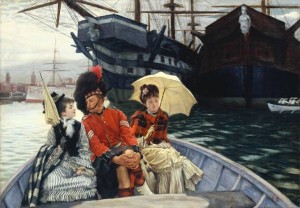
Women began to travel in the nineteenth century for many personal and political reasons. Some women sought to further a cause, like missionary work, while others traveled to satisfy personal curiosities of “exotic” lands. Most women, however, traveled to escape gender oppression in Europe (Stevenson 2). One form of gender oppression had manifested in scholarly and scientific writing, in which women scholars were not taken seriously. This was especially clear in attitudes towards women who researched and collected data, so women traveled to create a space for their research. In India, this proved to be a successful method of advancement in anthropology. White women were admitted into harems and zenanas, the homes of hundreds of eastern women, for the purpose of study. Men, however, were not allowed into these female dwellings. This allowed women that had come abroad to study and have expertise in an area where men had no access (Ghose 10). Race provided women with immediate empowerment (Ghose 9). (See Gender and Nation )
White women travelers were hailed for their advancement of feminism. Many of the women were surprised at this honor for their intent was not political. Yet whether women traveled for a political purpose or not, the power they gained in foreign lands as opposed to at home caused them to re-examine their position in Europe (Blunt 124). This realization of oppression and domination by men, however, did little for the liberation of people in the East. Rather, the East was seen as a place for women to regain power through race, which was lost at home because of gender (Stevenson 125).
Uses of Personal and Scientific Research
Many of the observations made by women traveling to the East concerned the indigenous people (Stevenson 10). Women viewed the people of the “Orient” from many different personal positions (See Orientalism ). Some female travelers identified with the people of the land as objects of study. They related to the native people because as women they were also objectified in Europe. This relation of marginalization allowed feminist travelers to advance the status of European women by showing gender hierarchy in another context. Anti-feminists, however, identified with the native women to support the idea that European women were losing their femininity (Ghose 53). Although few of the women travelers were known to be sympathetic to the cause of the indigenous peoples, Mary Kingsley advocated for anticolonial causes (Stevenson 11).
Objectification rather than identification was the more common approach on the study of native people . By studying the indigenous peoples, women were able to rise to the status of the white male in scholarly writing and in literature. These women behaved paternalistically towards the natives, as white men acted towards them. Female European researchers who objectified native women were very critical of the people and the land that they saw around them. The travel writings of the 19th century are known to be full of exaggeration, specifically about the violent tendencies of the native peoples. Victorian women often painted a picture in which African peoples were savages waiting to be tamed and trained to live better lives (Stevenson 10).
Marie Postans, an English traveler, represents many of the superior attitudes of Europeans. In the following example, she writes of Hindu holidays and their interference with daily life: “Hindu holidays interfere sadly with the labors of the working classes” (Ghose 35). Postans’ words re-emphasize the idea that the Indian way of living is lazy and fun-loving thus being unsuitable for the development of their own people. Postans’ documentation of Indian behavior supported an existing belief in the Puritan work ethic during the nineteenth century. By describing the Indian population as lazy, the European population, in contrast, became sober and hard working. According to colonial belief, it was only through better European schooling and exposure to English enlightenment that would lead to an advancement of the Indian people (35).
Another example is illustrated within the context of the remarks made by white women about women’s behavior in the harem or zenana in India. Many conservative white women viewed Indian women in harems as over-sexed and demented. White women contrasted their own behavior to the behavior of Indian women. As Isabella Bird claims:
I have lived in Zenanas, and have seen the daily life of the secluded woman, and I can speak from bitter experience of what their lives are–the intellect dwarfed, so that a woman of twenty or thirty years of age is more like a child of eight, intellectually; while all the worst passions of human nature are stimulated and developed to a Fearful degree: jealousy, envy, murderous hate, intrigue, running to such an extent that in some countries I have hardly ever been to a woman’s house without being asked for drugs with which to disfigure the favorite wife, or to take away the life of the favorite wife’s infant son. (qtd. in Ghose 63)
Bird’s description of the native population makes Europeans seem superior in intelligence and morality. She views the “child-like” Indian woman and believes that Indians need to be saved from their own demise. As with many English, Bird felt that Indian people left alone without the enlightenment of the Europeans were doomed to destroy themselves.
Bird and Postans were two of many imperialist women who contributed to the discourses of Orientalism . Their personal opinions of natives represent the attitudes of the majority of Victorian women who wrote and studied the women of the East and Africa. Below are quotes from various women whose travel journals also helped to shape Victorian attitudes towards the non-Western peoples.
Significant Quotations
Lady Mary Whortley Montague, Turkey:
I have seen all that has been called lovely either in England or Germany, and must own that I never saw anything so gloriously beautiful … I confess, though the Greek lady had before given me a great opinion of her beauty I was so struck with admiration that I could not for some time speak with her, being wholly struck taken up with gazing. (qtd. in Ghose 58)
Mary Billington, India:
According to modern “emancipated” lights, the answer of a poor Mohammedan woman in Calcutta to my question as to what she regarded as the chief happiness she would desire for herself might seem a contracted one. “To see my husband happy, and to know that what I have cooked and done for him has helped to make him so; to see my sons grow up as men, honest and strong, and to know that my daughters are well married” — is in my view a praiseworthy domestic ideal, enough even when set beside the possibilities of a bank holiday on Hampstead Heath. (qtd. in Ghose 65)
Mary Carpenter, India:
In England, such girls would be generally intended for domestic service, and prepared for its duties while at school. I was informed, however, that such can rarely be the case in India, owing to the universal employment of men in the household occupations with us exclusively appropriate to women; it would not, therefore, be safe for a young girl to be placed as a servant in the family. The girls are usually married when about fifteen or sixteen to native converts, and it is of importance that they should be prepared to be good wives and mothers of families … The singing is sweet, and in other respect this school gave me satisfactory proof that, under good female instruction, Hindoo girls are quite equal to their English sisters. (qtd. in Ghose 117)
H.H. Princess Marie Louise, Gold Coast, Africa:
The cloth is draped over the left shoulder, leaving the right arm and shoulder bare, and hangs down in heavy folds resembling a Roman toga. When an African, be he chief or otherwise, speaks to one of high or royal rank, he bares his left shoulder, removes his crown or fillet from his head and takes off his sandals. A chief’s ornaments, anklets, rings and bracelets, are very beautiful and of pure Ashanti gold, strange and rare in design and of the best native workmanship. (qtd. in Romero 163) Hitherto the young African desirous and keen for higher education has had to seek his training overseas, in surroundings alien to those amongst which he must ultimately live and work, thus exposing himself to the danger of growing out of touch with his own race during the most important period of his intellectual development. (qtd. in Romero 165)
Anne Louise Dundas, Tanganyika, Africa:
As the entertainment at this stage is growing rather thin, and our host appears somewhat anxious and weary, the European ladies adjourn by invitation to view their Hindu sisters, hidden from vulgar male curiosity … Everywhere about the floor of the inner sanctum lie wee brown babies, sleeping peacefully in their stiff, gold-lace caps, looking not unlike luscious chocolate drops decorated by a French confectioner. (qtd. in Romero 115)
Joan Rosita Forbes, East Africa:
As soon as a married couple arrive at a suitable age they are entitled to a portion of the family land, sufficiently large for its products to support them. This is chosen by arbiters appointed by the district, within whose bounds the husband has the right to cut sufficient wood for the construction of his house. Friends and relations carry this material to the appointed site. (Forbes qtd. in Romero 144)
Miss John Gray, Canton:
The courtesy of the Chinese is very great. You feel on entering one of their houses that their great desire is to please you and that their whole attention is given to you as a guest. Henry says when he has called a house of mourning, in which, according to Chinese custom, the seats of the chairs are covered with blue, a servant has been called to bring a red covering to place on the chair intended for him, as a Chinese gentleman consider it is not kind to make his friends mourn for his particular loss. (qtd. in Robinson 300)
Lady Sheil, Persia:
Here then we are fairly launched on the monotonous current of life in Persia. To a man the existence is tiresome enough, but to a woman it is still more dreary. The former has the resource of his occupation, the sports of the field, the gossip and the scandal of the town, in which he must join whether he likes to or not; and finally, Persian visiting cannot be altogether neglected, and if freely entered into, is alone a lavish consumer of time. With a woman it is otherwise. She cannot move abroad without being thickly veiled; she cannot amuse herself by shopping in the bazaars, owing to the attention she would attract unless attired in Persian garments. This is precluded by the inconvenience of the little shoes hardly covering half the foot, with a small heel three inches high in the middle of the sole. (qtd. in Robinson 174-175)
Works Cited
- Blunt, Alison. Travel, Gender, and Imperialism: Mary Kingsley and West Africa . New York: The Guilford Press, 1994.
- Ghose, Indira. Women Travelers In Colonial India: The Power of the Female Gaze . Calcutta: Oxford University Press, 1998.
- Romero, Patricia. Women’s Voices on West Africa . Princeton: Princeton University Press, 1992.
- Robinson, Jane. Unsuitable For Ladies: An Anthology of Women Travelers . New York: Oxford University Press, 1994.
- Stevenson, Catherine Barnes. Victorian Women Travel Writers in Africa . Boston: Twayne Publishers, 1982.
Related Sites
Victorian Women Writers http://www.indiana.edu/~letrs/vwwp/
Author: Aziza Ahmed, Fall 1998
Last edited: October 2017
Related Posts
Introduction to postcolonial / queer studies, biocolonialism.
excellent collections it will be useful for the scholars and philosophers
My mother was the librarian in our little tiny townin the ’50’s and ’60’s. She was always telling me about books she read. Two I remember were ‘Africa’ and ‘China’. These books tell about how the people lived and their customs..the nitting gritty. I’ve been looking for older anthrology books written in the early period when most women who traveled to Africa and China could have been writting. the only names that come to mind that I remember mentioning where Margaret Mead and Ruth Benedict. Still have not found these books. I do not remember the names. Only the thick books and their titles: “Africa” and “China”. Would like some help with the authors who were anthropologists.
Hi Margaret, As for travel narratives by women in the early period, here are some books: A Woman in China by Mary Gaunt. The Face of China; The Face of Manchuria; Chinese Mettles; Wanderings in Chinese Turkestan by Emily Georgiana Kemp An Irish Woman in China by Emily French Daly Wanderings in China by Constance Gordon-Cumming Intimate China; Round about My Peking Garden; My Diary in a Chinese Farm by Mrs Archibald Little The Yangtze Valley and Beyond by Isabella Bird A Passport to China by Lucy Soothill Brave New China by Lady Dorothea Hosie
Pingback: A Women’s Gaze – ENROUTE INDIAN HISTORY
Write A Comment Cancel Reply
Save my name, email, and website in this browser for the next time I comment.
- About Postcolonial Studies
- About This Site
- How to Cite Our Pages
- Calls for Papers
- Authors & Artists
- Critics & Theorists
- Terms & Issues
- Digital Bookshelf
- Book Reviews
- You can contribute
- About the Program
- Emory GPS Events

Sign Up Today
Start your 14 day free trial today
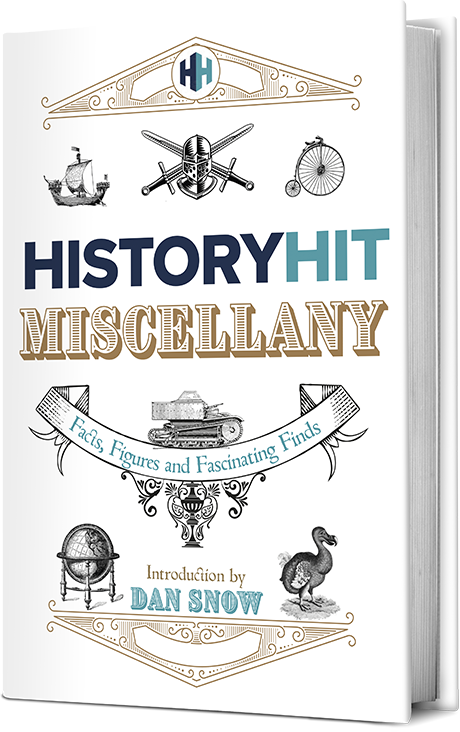
The History Hit Miscellany of Facts, Figures and Fascinating Finds
What Was It Like to Ride a Victorian Luxury Train?

Martyn Pring
28 feb 2020.
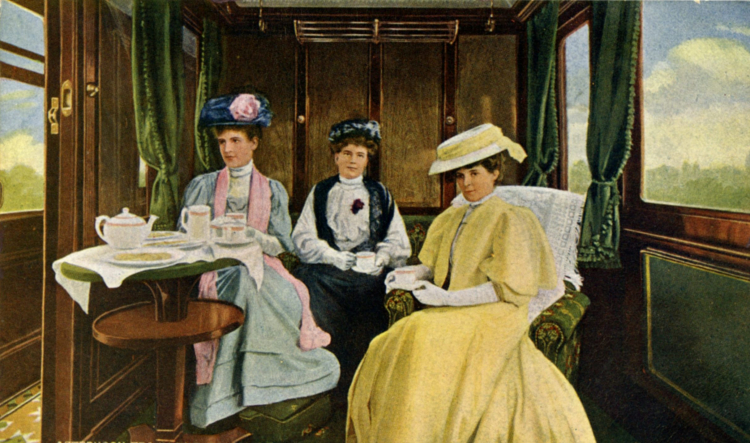
Most people believe luxury train travel was the product of the 20th century’s inter-war years.
While it is true that some of the most illustrious luxury trains were firmly entrenched in this period, the history really unfolds much earlier.
Towards the end of Victoria’s reign
Ideas surrounding luxury rail travel really began in the mid-1880s, when society was on the move and the Old World was attracting tens of thousands of new international visitors.
In Britain there had been some railway company experimentation. However the notion of civilised travel arrangements had hardly moved on from 1862, when new Anglo-Scottish expresses were made up of primitive 4 and 6-wheeled non-connecting carriages.
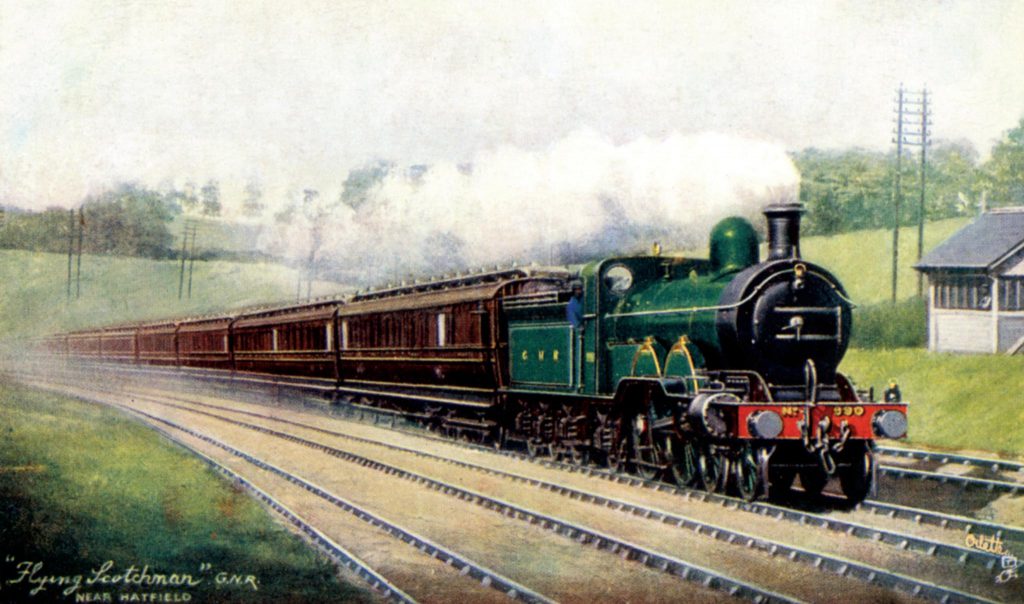
Clerestory carriage stock still dominated prestige Anglo-Scottish expresses but by 1898, the east coast route was powered by the first 4-4-2 locomotives. GNR’s No 990 entered service in May of that year (Credit: John Scott-Morgan Collection).
This was the norm before two 4-wheeled (and later 6-wheeled) bogie stock caught on. Sprung bogie construction was still some time off to enable a smoother passenger ride.
Some railway companies like the Midland were true trailblazers with “luxury 12 wheelers”. Others remained unconvinced of benefits they delivered, citing the fact that they were heavier, required more powerful locomotives, and were a prerequisite for greater investment and capital expenditure they were loath to spend on.
For travelling passengers, the advantages were self-evident; new bogie carriages provided greater comfort and freedom to move around.
The Orient Express

The first Orient Express in 1883 (Credit: Jürgen Franzke).
The launch of the Orient Express in October 1883 provided a pivotal moment in the development of the luxury train concept.
The initial service linking many European capitals ran with two sleeping car saloons and a dining carriage sandwiched between the two fourgons or luggage cars.
However it was the idea of a better travelling experience with sumptuous accommodation that caught the media’s eye.
The launch event and the celebration of cuisine delivered by a small band of chefs working in cramped conditions was universally received with journalistic plaudits and especially with British audiences, who went on to form the majority of the luxury train’s customers.
The return journey lasted 11 days, but clearly demonstrated Georges Nagelmackers’ uncanny ability to negotiate complex travel arrangements involving national institutions and myriad railway companies across the pockets of European states.
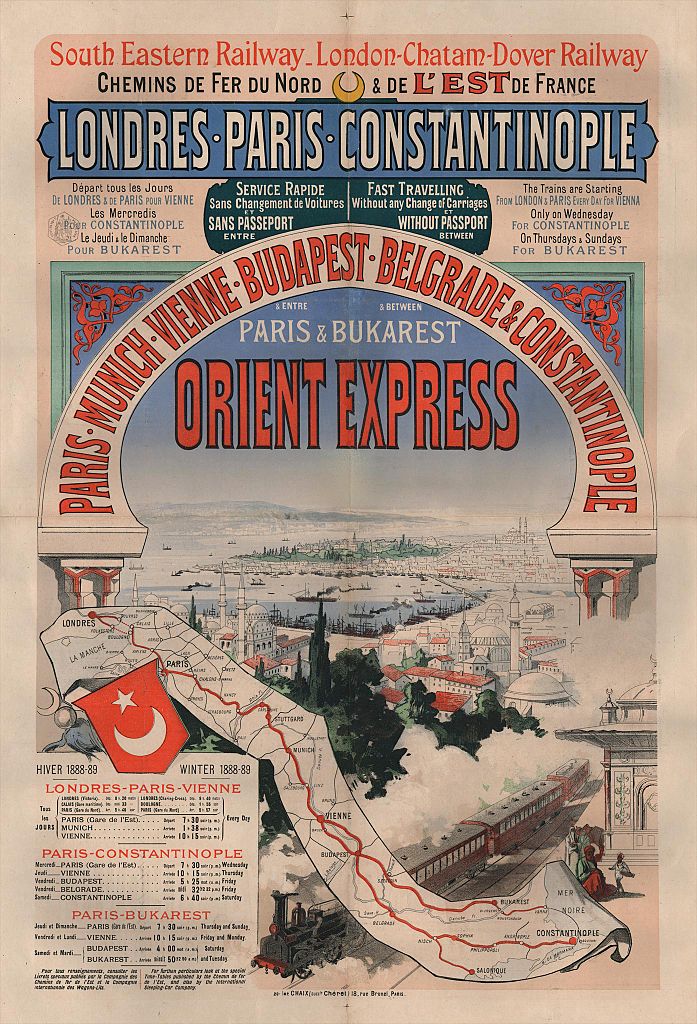
1888 poster advertising the Orient Express (Credit: Jules Chéret ).
Railway route expansion fueled the expansion of first-class trains largely driven by a combination of railway competition and increased traveller expectation.
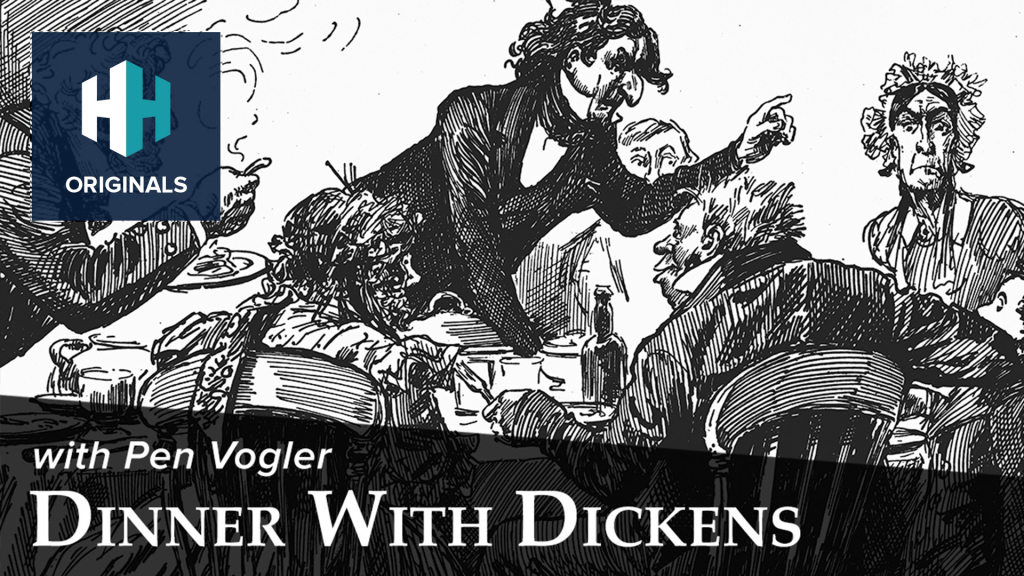
A better to way to travel
The 1890s marked a significant step-change in Britain and how railway companies saw their customers, belatedly realising passenger expectancies surrounding the quality of travel and services were clearly evolving.
It was a decade of rapid and bewildering change as science and technology transformed the country, giving rise to the modern world. The bigger railway companies were a key lever of industrial expansion altering everything around us forever.
Whilst railways possessed the infrastructure to effect change, society as a whole was knocking on their doors demanding transformation.
An educated and moneyed upper and middle-class, benefiting from the professionalisation of society (on both sides of the Atlantic), demonstrated personal ambition, self-confidence and a willingness to tap into life’s better things.
Railway companies and shipping lines were the new conduits of better ways to travel.
The age of decadence
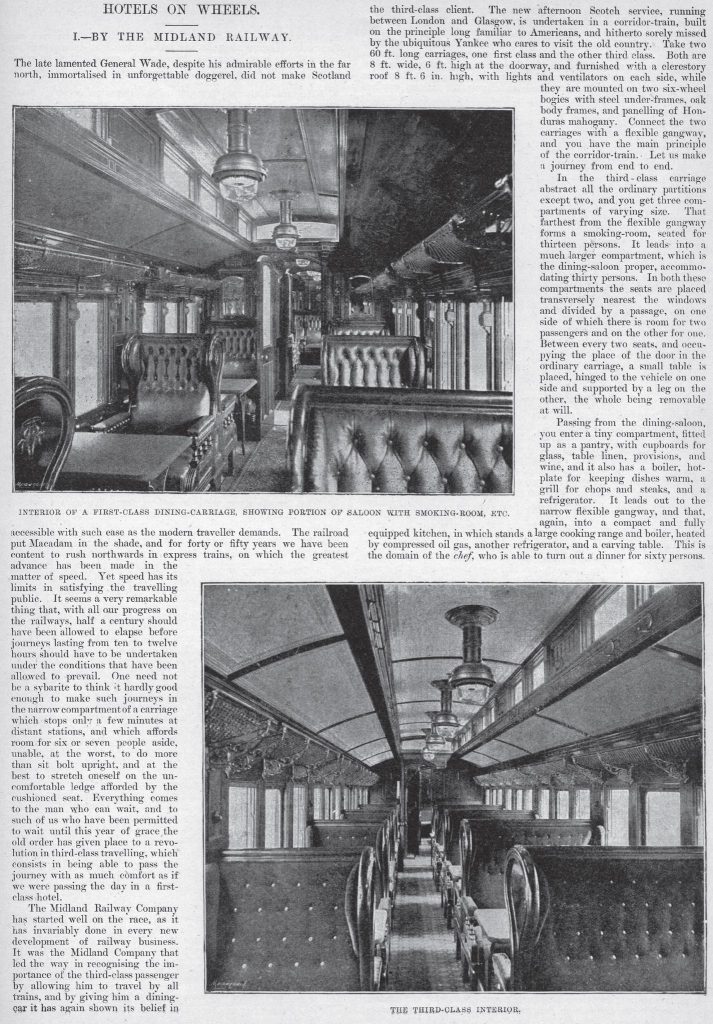
The 1890s saw significant strides in express train carriage development with improved comfort and passenger facilities ensuring longer rail journeys could be enjoyed rather than endured (Credit: Illustrated London News Ltd/Mary Evans).
The end of the Victorian age was discernable as a period of decadence and interest in arts, popular culture and the written word altering the travel landscape and demand for luxury products and services.
Frequent and short breaks were now on travel agendas – railways got you there fast. Domestic and overseas travel became cornerstones of urbane lifestyles.

Notions surrounding adventure, walking, outdoor pursuits, culture and heritage registered ever more prominently on peoples’ radars.
From the 1890s decadent places to stay, restaurants, eateries and new concepts surrounding the luxury floating palaces of trans-Atlantic liners and their accompanying boat trains were on architect and designer drawing boards – but constructed to mirror society’s accepted class segregation.
The British Pullman Company
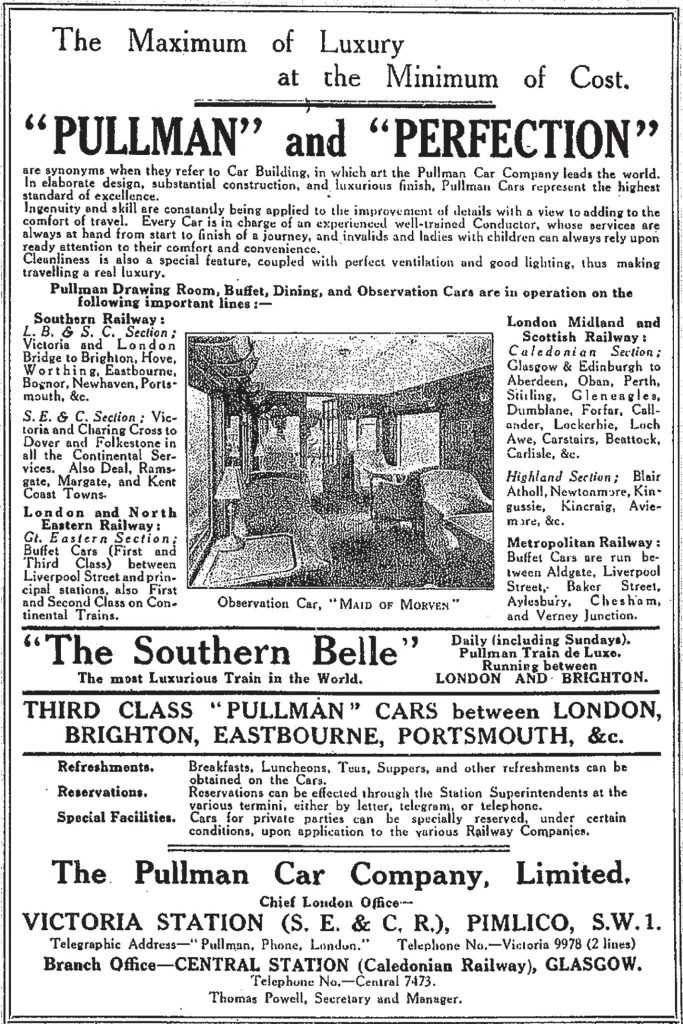
In the early days of railway grouping, the Pullman Car Company was seeking to enhance their promotional image with a tag line of ‘the maximum of luxury at the minimum of cost’ as shown in this advertisement from the 1924 ‘Railway Year Book’ (Credit: James S. Baldwin).
So how did all of these ideas transform themselves into better ways to travel by rail? Certainly increased use of longer and spacious bogie carriages provided improved passenger comfort and facilities.
Gangway/corridor connected stock with compartments and lavatories became the norm. Some railway companies invested in raised clerestory roofed coaches providing more natural light; elliptical shaped roofs became the standard from Edwardian times when aided by new electric lighting technologies.
This came about in 1894 when dynamos were attached to bogie wheels; dimly lit coaches on premier services were consigned to the past.
One of the first benefactors were the London, Brighton and South Coast Railway’s (LBSCR) Brighton Pullmans and Newhaven boat trains.
It was the beginning of ‘Pullman and Deluxe train travel’ whispered in the same breath as the British Pullman Company came under new ownership.
A golden era of train travel
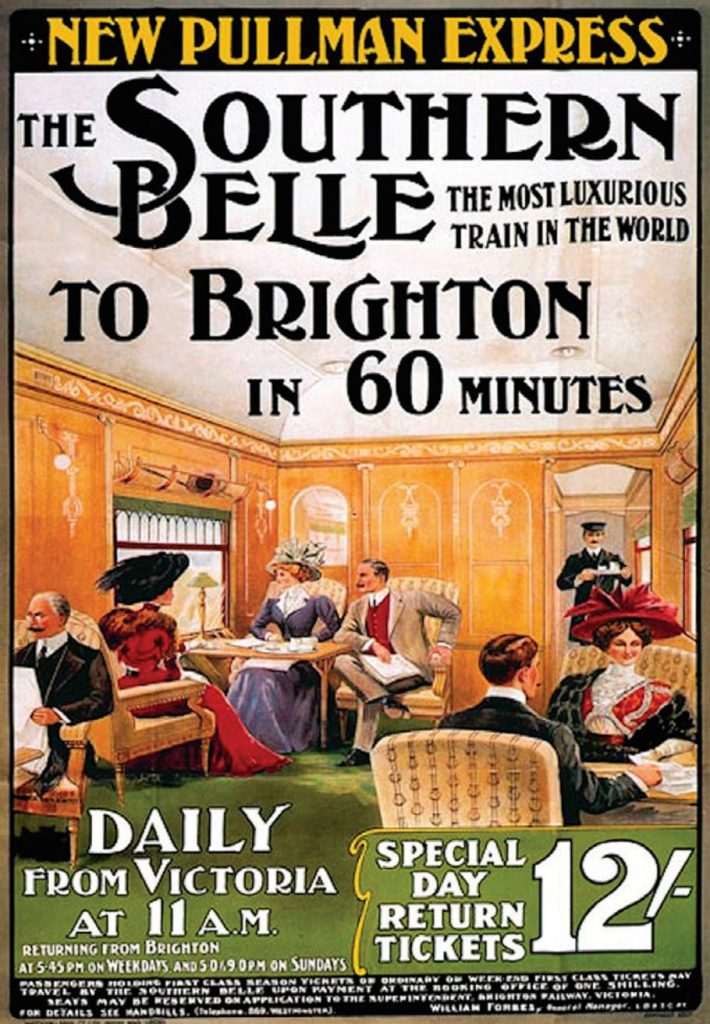
Advert for the Southern Belle (Credit: Public domain).
Improved gas technologies also provided safer environments for lighting, food preparation, cooking and the dining carriage, although in the event of collision and derailment, seeping gas was always a potential fire hazard with wooden constructed coaches.
High-quality dining cars provided sophisticated “food on the move” rail travel for both first and third-class passengers.
On the continent, it was more complex as second-class travel still existed, but British food service developments were innovative; new third-class diners were akin to first-class of other railway companies.
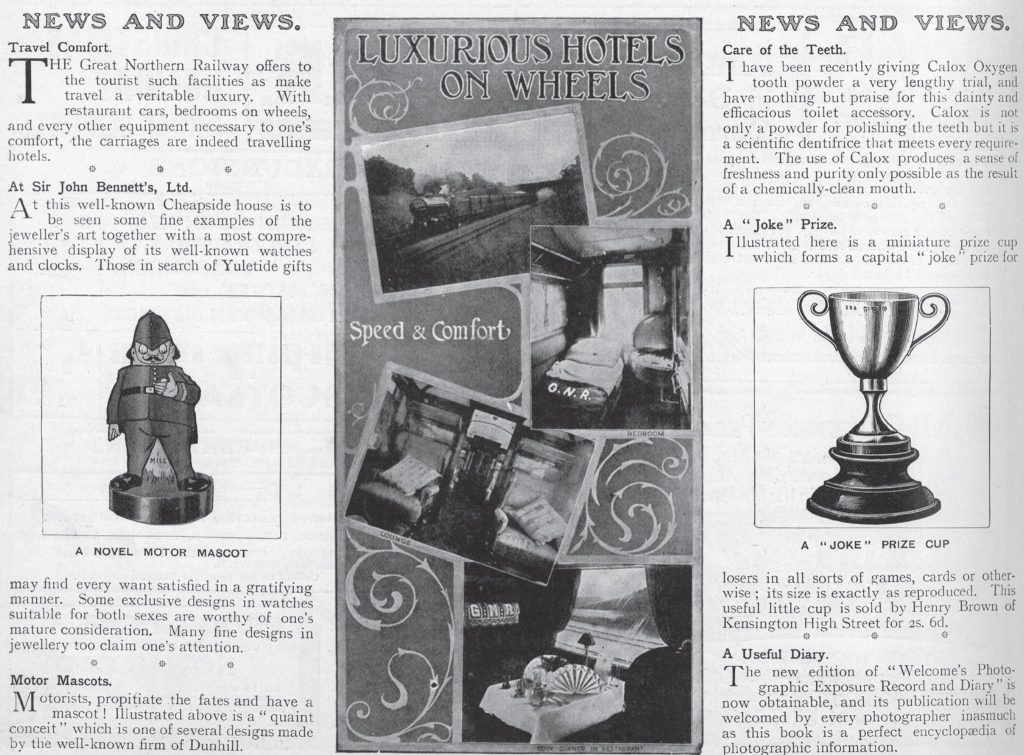
The Tatler was another key publication for railway promotion. The title’s editorial in December 1907 coincided with the GNR’s ‘Luxurious Hotels on Wheels’ initiative (Credit: Illustrated London News Ltd/Mary Evans).
Similarly, first-rate sleeping car services on long-distant runs were ever more pleasant places especially on the consortia led Anglo-Scottish expresses. Viewpoints of “hotels on wheels” entered everyday language.
After a difficult start in Britain, The Pullman Company gradually gained a foothold on LBSCR and South Eastern and Chatham Railway (SECR) services providing some of the first named luxury trains.
By Edwardian times affluent first-class passengers increased substantially; the new Southern Belle Pullman was described as “The Most Luxurious Train in the World” when launched in 1908.
Visitors from the New World
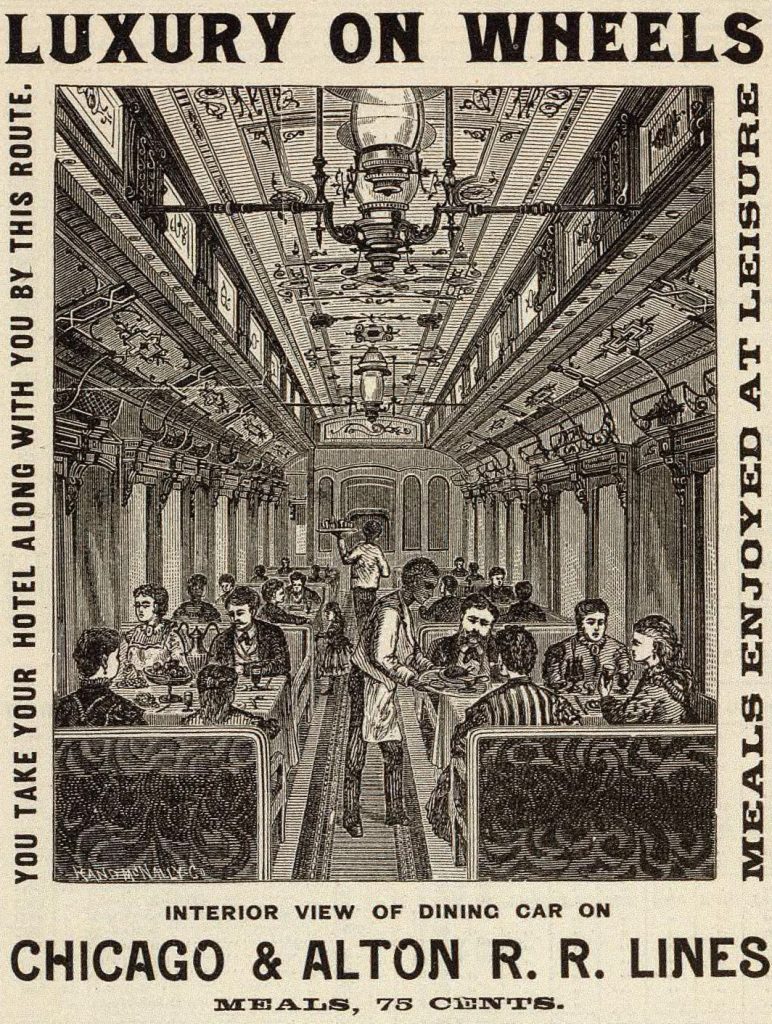
Illustration from 1885 Chicago & Alton Railroad timetable (Credit: Public domain ).
One of the major drivers to the extension of luxury facilities enjoyed by period travellers was the value and numbers of New World tourists coming to Britain.
The impact of the US source market in shaping luxury travel agendas in this country was a significant signature of the times.
New classes of trans-Atlantic liners could be found; the first-class “floating palaces” reflected the value of American visitor economy and exercising a profound influence as all involved recognised the high-spending potential.
Travel providers – railway companies, shipping lines and hoteliers – went out of their way to provide simply the best.
Martyn Pring is currently an author and independent researcher with interests in culinary tourism, destination marketing, luxury branded sectors and travel histories. He is a self-confessed railway, maritime and aviation enthusiast from a young age. He is the author of Luxury Railway Travel: A Social and Business History published by Pen and Sword .
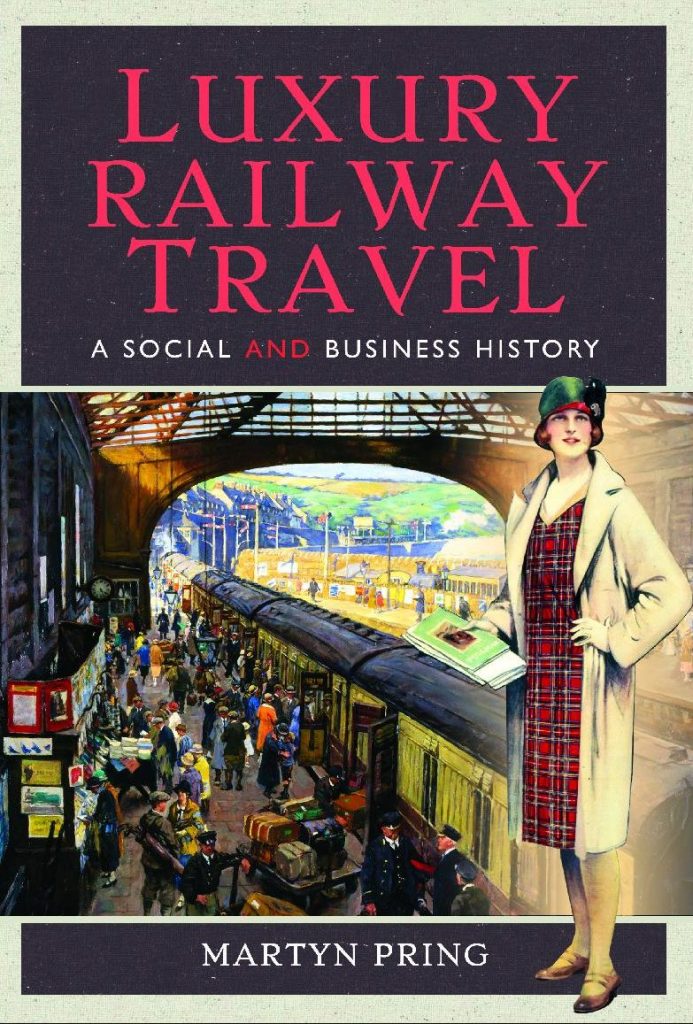
You May Also Like
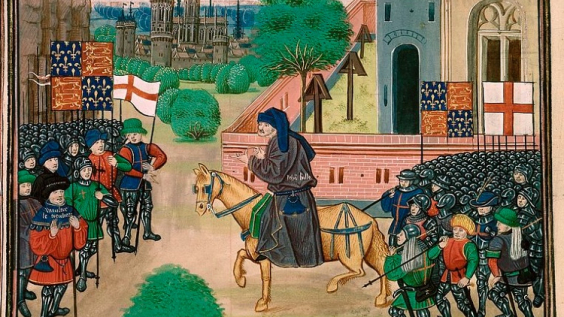
The Peasants’ Revolt: Rise of the Rebels
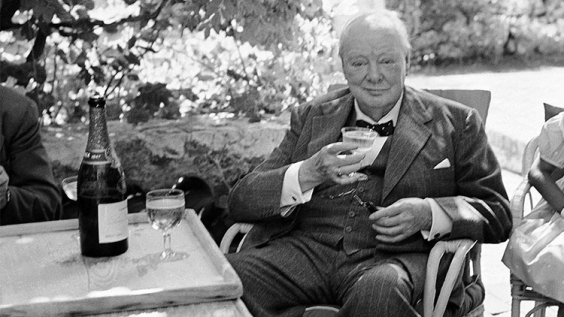
10 Myths About Winston Churchill
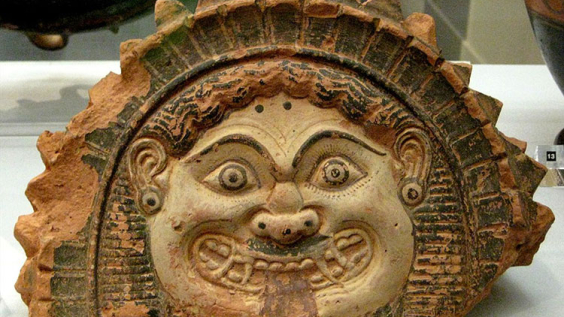
Medusa: What Was a Gorgon?
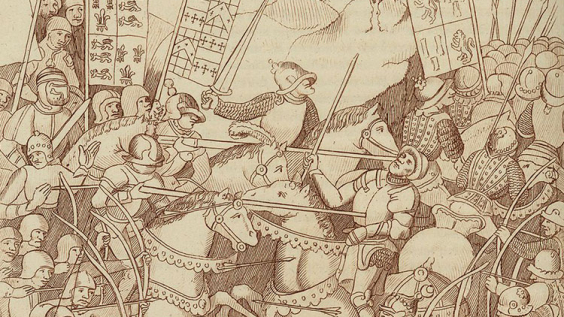
10 Facts About the Battle of Shrewsbury
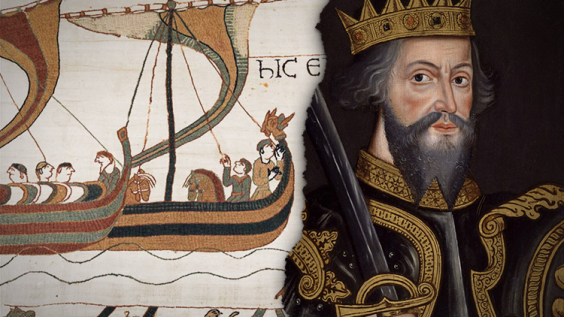
5 of Our Top Podcasts About the Norman Conquest of 1066
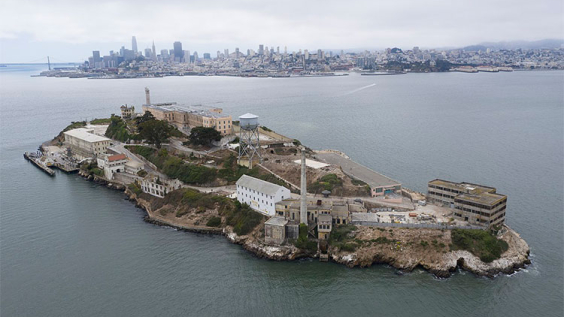
How Did 3 People Seemingly Escape From Alcatraz?
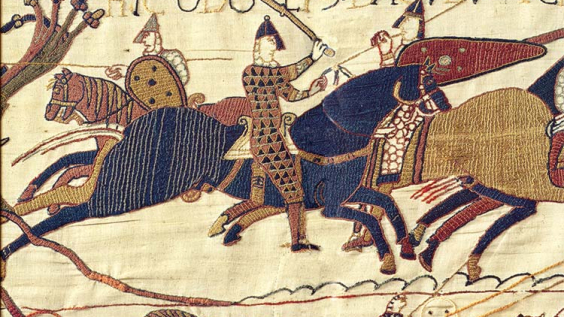
5 of Our Top Documentaries About the Norman Conquest of 1066
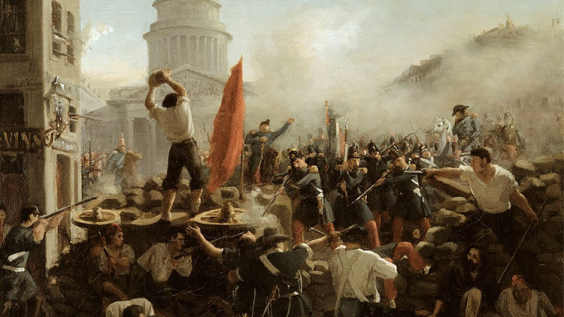
1848: The Year of Revolutions
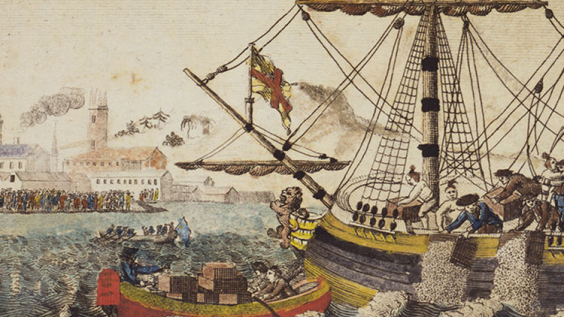

What Prompted the Boston Tea Party?
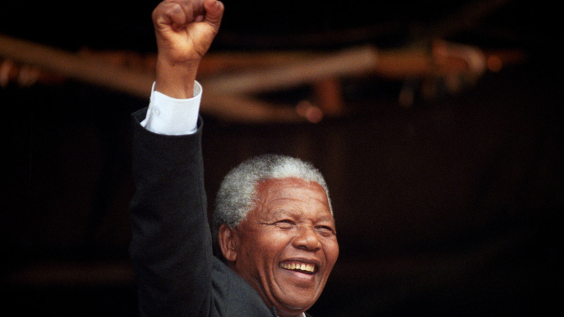
15 Quotes by Nelson Mandela
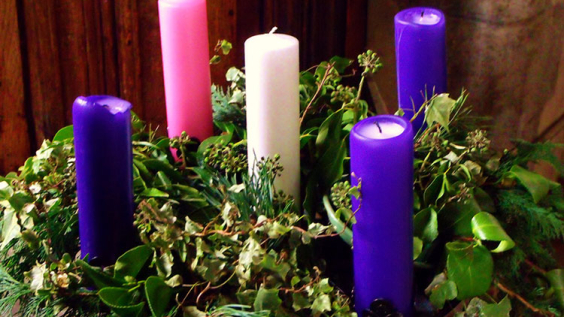
The History of Advent
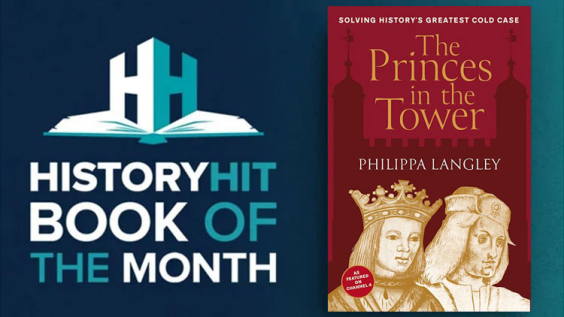
The Princes in the Tower: Solving History’s Greatest Cold Case
Nineteenth-Century Explorers and Travellers
[ Victorian Web Home —> Political History — British Empire ]

Explorers of Africa and the Middle East
- Richard Burton
- Mary Kingsley: Demystifying Africa
- David Livingstone ( gallery of images )
- John ‘Rob Roy’ MacGregor (1825-1892): Explorer, Evangelist and Philanthropist
- John Hanning Speke
- From Travel to Text: Reverends Wolff and Lansdell's missions to Bokhara (abstract)
Explorers and Travellers in the Far East
- Isabella Bird (1832-1904), Traveller, Travel Writer and Photographer, Part I

- Isabella Bird (1832-1904), Traveller, Travel Writer and Photographer, Part II
- The Travels and Travel-Writing of Maria, Lady Callcott (1785-1842)
- Christina Herringham and the Ajanta Frescoes
- Juliana Hervey, author of The Adventures of a Lady in Tartary, Thibet, China, & Kashmir (1853)
- Marianne North, Botanical Painter and Traveller (in many countries, including India, Ceylon and Japan)
- Fact or Fiction in the Forbidden Land: the questionable travels of Arnold Henry Savage Landor (in Tibet — abstract)
Explorers of Polar Regions
- Joseph René Bellot
- Sir John Franklin
- Dr. John Rae
- Robert Falcon Scott ( monument)
- Ernest H. Shackleton (monument)
British Explorers and the Visual Arts

- Monuments to Victorian British Explorers
Related Material
- Cannibals on the Northern Ice: Nationalist Ideals, the Big Lie, and the Franklin Expedition
- The Search for the North-West Passage: 1497-1845
- The Mary Slessor ("Queen of the Okoyong") window in the McManus, Dundee
- "Hitting the Road! Travel Experiences and Narratives of the Victorian and Edwardian Era" (conference announcement with select bibliogrpahy) University of Tours, France (2-3 February 2023)
Related Material on Other Sites
- Livingstone online — a digital museum and library
Bibliography
Note: See also under individual explorers.
Bridges, Roy. "Speke, John Hanning (1827-1864). Oxford Dictionary of National Biography . Online ed. Web. 5 Dec. 2011.
Hanbury-Tenison, Robin. Exploration . Oxford: Oxford University Press, 2005
Jeal, Tim. Explorers of the Nile: The Triumph and Tragedy of a Great Victorian Adventure. . London: Faber, 2011. 510pp. £25.00. ISBN 978-0-571-24975-6. [ review ]
Speke, John Hanning. Journal of the Discovery of the Source of the Nile . New York: Harper, 1864. Internet Archive . Web. 5 Dec. 2011.
Last modified 9 August 2022
Sew Historically
Live a sustainable life, victorian & edwardian travel accessories.

-> Edwardian Bicycle Costume
So Victorians and Edwardians needed many travel accessories. Some Victorians and Edwardians bought their travel accessories while some made their own. Below you’ll find a round-up of Victorian & Edwardian travel accessories with instructions on how to make your own!
Victorian Travel Bags
‘The old-fashioned carpet bag (Fig. 1) is still unsurpassed by any, where rough wear is the principal thing to be studied. Such a bag, if constructed of good Brussels carpeting and unquestionable workmanship, will last a lifetime, provided always that a substantial frame is used.’ ( Scientific American Supplement, 1888 )
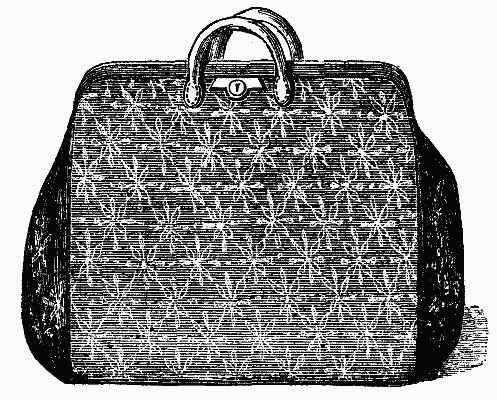
‘Carpet bags should be purchased with large gores at the sides, as when thus made, they contain many more articles, and more conveniently than when they are only two plain pieces of carpet. They should also have a brass plate.
When gentlemen travel much between two places, it is well to have the brass plate moveable, and engraved with one address on each side, so that nothing is necessary but to turn it, thereby preventing the necessity of constantly renewing the written directions: this plate is fastened at one end by a pivot, which is secured between the two locks (every bag should have two locks), at the mouth of the bag, and at the other end of the plate is a brass loop, which is fastened to the lock at either side. […]
When the party sleep several nights on the road, it is advisable to have a large carpet bag containing the night-dress of each individual packed up in night-gown bags, dressing tidies (see Plate 24), marked with the initials of the persons; by this means much trouble is saved. It is a good plan to sew a camphor bag in the night-gown to prevent the attack of fleas and bugs.’ ( The Workwoman’s Guide, 1840, p. 121 )
NIGHT-GOWN BAG
‘This is made of Holland, calico, or thick cambric, or glazed muslin, and sometimes trimmed all round with a frill, or piped with coloured calico. It is intended to contain the night-gown, cap, also the dressing-gown, and perhaps a change of linen, and the tidy or dressing-case, and may be made to any size, according to the number of things it is intended to contain.
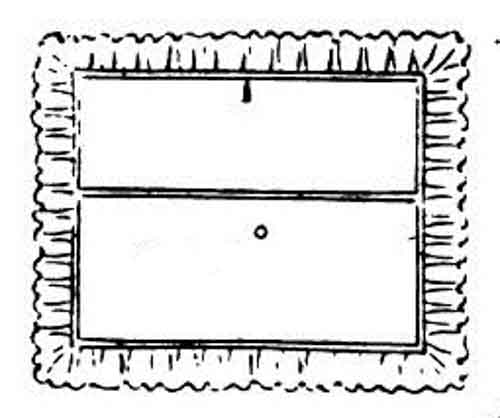
Its chief use is in travelling, especially in a large family, when the separate case, containing each individual’s night things are easily found together, and as easily put up in a large carpet bag. Each bag should bear either the name or the initials of the person to whom it belongs.’ ( The Workwoman’s Guide, 1840, p. 208 )
‘In packing for a large family it is a good plan to keep the linen separate by putting a towel between the layers of linen, letting each layer consist only of the clothes of one person, so that on unpacking, the towel containing the linen of each individual is simply lifted out, without the trouble of looking at the marks.’ ( The Workwoman’s Guide, 1840, p. 121 )
SAILOR’S CANVAS BAG
‘In commencing to make a canvas bag as used by sailors, a double seam is sewn down the side of the bag, and it is then a canvas cylinder. To get the radius of the circle for the canvas bottom, measure the width of the bag while flat on a table and add 2 in., and divide by 3.
Make a loop of twine to this size, stick a sail needle into a piece of canvas, and with pencil and twine describe a circle about 2 in. greater in diameter than the bag. Now shorten the twine 1 in. and make another circle, cut out the canvas bottom to the outer circle, turn in 1/2 in. of the edge of the bag and sew a round seam with needle and twine, keeping the doubled edge to the inner pencilled circle; turn the bag inside out, and flat-seam the bottom edge to the side; this makes a neater job, though the one seam alone will suffice.
For securing the top of the bag, sew a leather strip on the top edge of the canvas just as braid is put on cloth; then to the side seam, just below the leather, sew a strap to encircle the neck tightly and fasten with a padlock, the strap being furnished at its ends with hasp, etc., to take the padlock; the leather edging cannot be pulled under the strap.
Another plan is to sew a tabling or hem round the top edge, then sew canvas beckets about 6 in. apart round the neck, and through these pass the strap and lock as before. A piece of brass chain is sometimes used in place of the strap, the end links taking the lock. A strap with buckle can, of course, be used if a lock is not wanted.’ ( Cassell’s Cyclopaedia Of Mechanics, 1900 )
Edwardian Travel Purses
Regulation traveling bag.
‘The regulation traveling bag is one of the most serviceable of the chain purses, and it is beautifully neat as well, which counts for so much these days. Besides all that, it kills two birds with one stone, as it serves as a handbag and a purse all in one.
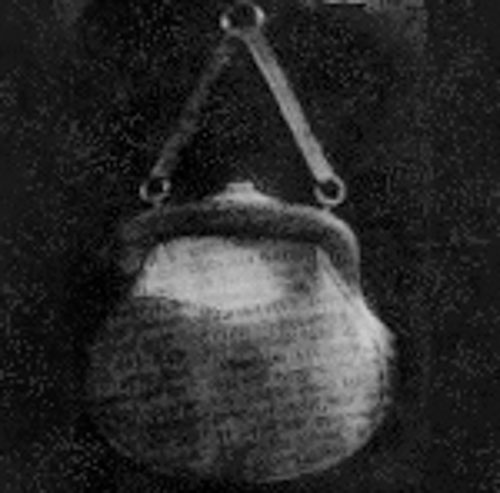
It is rather large and is generally divided into two parts, one for money and the larger one for any of the numerous little odds and ends that, one needs for a short trip. The outside pocket is a fit and fine place for tickets, as they are easily got at, and nine times out of ten when the conductor comes along everything else is in evidence but the thing most needed.
These purses, by the way, have a safety clasp. The steel piece which slips over the belt has a claw-shaped piece which can be fastened into the band, and unless the cloth is torn into strips no one can possibly get it off and it is absolutely safe, although all you have to do is to stop on any corner and listen to the private opinion of one man telling another how absurd it is for women to invite pickpockets in such a reckless fashion.’ ( San Francisco Call, 1903 )
TRAVELING PURSE
‘Woman is a strange personage and she is very apt to carry her valuables in a peculiar place, to say the least. It is no once-a-year sight to see a woman moving about in a mysterious fashion, and if you are one of the initiated you know that her little horde is securely fastened with a huge pin at the top of her hosiery. Unless she is careful you might see a powder puff and an extra handkerchief, for that is the one place where everything and anything may be carried with all possible safety.
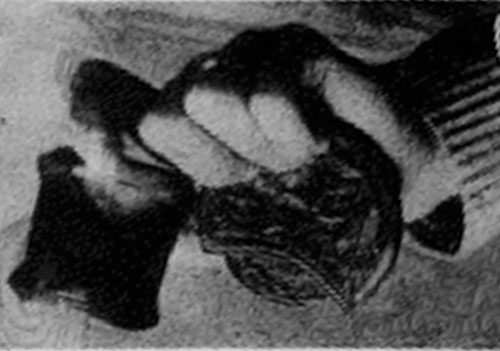
Or again, she may carry a chamois skin fastened to the top of her corset, another secure place, but one that is rather difficult to get at in a crowded shop. Trouble, trouble! There has always been plenty of it and there always will be just as long as women try to shop or travel with something that lies in the palm of their hands and that may be put down and forgotten.’ ( San Francisco Call, 1903 )
Victorian & Edwardian Toiletry Bags
Toiletry bag.
‘Every one has among the unmade odds and ends in the attic or store room for which a use is expected to be found some day a number of pieces of cotton goods which have been left over from summer dresses or the curtaining and upholstering of summer parlors or bedrooms.
They are not so valuable as the pieces of silk and velvet from which sofa pillows , hand bags and numerous dainty costume accessories may be made, nor is it of much use to keep them to mend the gown or curtain of which they have been a part, because cotton things are not expected to last many seasons in the first place, and in the second because making them over with new goods to help out is usually impossible as the difference caused by fading is too apparent. Still, the pieces accumulate, and the patterns are so pretty and the coloring so fetching that one treasures them long after the costumes which they match have gone into the rag bag.
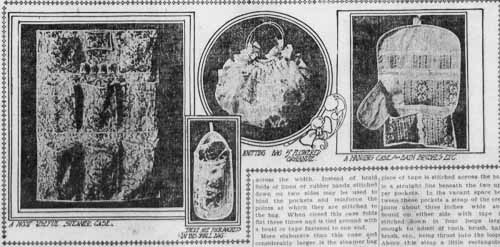
It is possible, if one has time to sew, to make the most attractive toilet bags and cases of these pieces. One can create one’s entire outlay of Christmas gifts from them with a very small expenditure of money. For many purposes they are far more appropriate than silk. In this season of flowered organdies and embroidered batistes for gowns and flowered chintzes and cretonnes for bedroom furnishings the pieces of cotton goods available in most houses are particularly suited. […]
‘One of the most useful articles of this nature, which will be greatly appreciated as a gift or will be of much use in your own boudoir or trunk, is a case which may be used either at home or in traveling for holding sponges , wet brushes , cloths, etc. It is made of striped Dresden chintz of quite a heavy quality and is lined throughout with rubber, so that the toilet articles may be put in directly after using while one is traveling.’ ( Los Angeles Herald, 1905 )
A TRAVELING DRESSING-CASE OR TIDY
‘These are most useful things, and no one who has once used them will travel without them, unless they can conveniently carry a dressing-case with them. They are made of Russia duck, ticking, or stamped cloth, or any other firm material. In making up, the greatest exactness is required to make the parts fit truly. The back, which is all in one piece, is lined with strong calico, and the various pockets are then laid on, the bottom of one being sewed a little below where the top of the next will come, so that the whole has a neat appearance: the sizes of the pockets, given in the Plate, allow for this wrapping over.
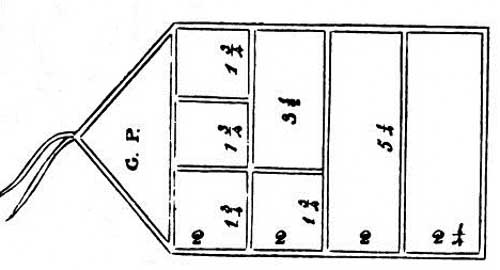
The top of each pocket is bound with purple or other coloured galloon, and the divisions for the smaller ones are formed by stitching a piece of narrow galloon neatly down upon them. The whole is then bound round with galloon, and strings of the same colour fastened to the pointed end, so as to tie round the dressing-case when it is full. As purple galloon will wash well, it is best for this purpose, as most other colours fade.
On each pocket is written with marking ink, the name of the article to be contained in it; these of course differ according to the fancy of the owner, but the most usual are curl papers in the triangular pocket at the top, H for hair-pins, W for thread, tapes, buttons, &c., S for soap, P for tooth-powder, T for tooth-brush, which ought also to be enclosed in an oil silk bag; C for comb, and B for hair brush.’ ( The Workwoman’s Guide, 1840, p. 208f. )
‘A collapsible dressing bag that is well adapted for travelling is made of six half yard strips of wide taffeta ribbon joined with cable cording and shirred to a circular cardboard bottom. A satin lining is tacked to the seams of the ribbon panels and the sections thus formed make convenient pockets. Each receptacle has its individual baby ribbon drawstring, and a wider ribbon at the top of the bag pulls it together.’ ( Los Angeles Herald, 1909 )
RAZOR CASE & GENTLEMAN’S TRAVELING DRESSING CASE
‘In making razor cases use soft leather, which may be purchased in skins of any color. Use a strip about 10 by 14 inches. Make a lining of double-faced outing flannel a trifle longer to allow for the turning in of the raw edges. Featherstitch to this in pocket form, pockets to be an inch wide, a strip 7 by 14 inches. Then stitch the lining to the leather along all the edges. An initial can be embroidered on the case, the color to match the feather stitching. The sides double over as in a spoon case, to protect the razors.’ ( Sacramento Union, 1909 )

‘Gentleman’s travelling dressing case. This is made of leather of any length, according to the number of things put in. It should be the width of the longest of the articles to be put in (say the razors). A row of divisions of the proper sizes are made by a strap of leather carried all along the case in which the razor strop, boot hooks, razors, scissors, knife, tweezers, pencil, tooth brush case, shaving brush, and soap case are put. The flaps fold over, and the whole wraps up and ties round. The articles should be bought before the case is made, as the divisions can then be formed exactly to fit.’ ( The Workwoman’s Guide, 1840, p. 215f. )
HATPIN CASE
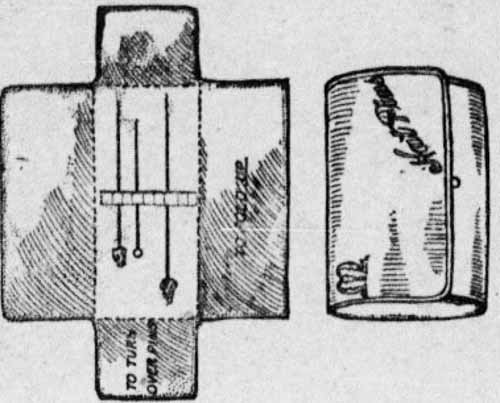
‘A hatpin case is a useful present for the woman who travels, as it keeps the pins together and prevents their loss – a great consideration in these days of elaborate and expensive hatpins. The case may be carried out in any material you like. Its measurement is that of the ordinary hatpin, allowing an inch for the reception of any extra long ones.
The design in the cut shows the case open and closed, and as it may contain as many pins as you like your own discretion must be the guide as to its width. A ribbon strip inserted down the middle and divided into sections serves as a receptacle for the pins, which are prevented from slipping out by the flaps on the ends. The top comes down over the case when folded and is fastened with a small button and loop. The edges are bound with ribbon, silk cord or braid, according to the material used for the case. The initials of the owner and the word “Hatpins” embroidered on the front give a pretty finishing touch to a charming little gift.’ ( Marin Journal, 1906 )
Victorian Shoe, Shawl & Nursery Bags
‘Shoe cases. These are meant to hold shoes in travelling, and to take the place of wrapping-paper. As each case holds but one pair of shoes, it is well to make two of them, or more, as a present. Cut out of brown linen a case or bag which will easily hold a pair of shoes. Bind the edges with braid, and fasten strings about the mouth to tie it with; or make the end long enough to fold over, shaping it like an envelope, and fastening it with a button and buttonhole.’ ( The American Girl’s Home Book of Work And Play, 1890 )
‘Slipper bags are made of six half yard strips of satin, taffeta or ribbon, with gracefully rounded points that project over the shirring casing at the top. These points are lace edged or herringbone embroidered and faced with plain silk or with all-over muslin embroidery. Small pockets set on the outer side of each panel are for handkerchiefs, talcum powder, vanity mirror and manicure tools.’ ( Los Angeles Herald, 1909 )

‘Shoe or brush and comb bag. These are very convenient in travelling, as they save much paper, and take up little room, they are made of different materials, according to the shoe to be put in. If for walking shoes, a coarse brown canvas called earn, is the most suitable. For house shoes, calico or Holland, and for satin slippers, old silk.
The bags are made to draw up at one end in the usual way, and should be just wide enough to contain the shoes, but as they are useful to put in one’s muff, or to carry in the hand when going out to dine or spend the day, it is as well to leave sufficient space at the top for a pair of stockings above the shoe. The name of the owner, and the quality of the shoe, should be put outside. […]
Boot bags. These are very useful for gentlemen whose boots take much room when wrapped in paper, which they often burst, and soil the clean linen; a boot when packed is generally rolled up from the top about half the leg, the bag should be made to fit it when thus rolled, and is on an average, about the following size: The width at the top of the case, about three nails. The width at the bottom, about five nails. The length of the case when doubled, about four nails in front, sloped down at the top to three nails and a quarter.’ ( The Workwoman’s Guide, 1840, p. 209f. )
‘Probably most of the girls who read this book know what shawl-bags are like, and also know their usefulness. They are not only capital things to protect shawls from dust and cinders in travelling, but may be used as another hand-bag, to carry small articles in case of need.
Stout brown Holland is the best material. Cut two round end-pieces eight inches across, and a piece half a yard wide by twenty-four inches long. Sew the sides of the piece around the two end-pieces, making a cylinder with a long slit, which is to be the mouth of the bag. Face the edges of the slit, and bind them and the seams at the ends with worsted braid. Close the opening with five buttons and buttonholes, and sew on a stout strip of doubled linen by way of handle, like that of a shawl-strap. The bag may be ornamented on one side with the initials of its owner.’ ( The American Girl’s Home Book of Work And Play, 1890 )
NURSERY BAG
‘This is used by nurses while travelling, and is very convenient for the purpose of carrying infants’ soiled linen. The bag should be of dark coloured silk, or washing material, made in two divisions, and lined throughout with oiled silk, or Indian rubber cloth, so as to be waterproof . They should be six nails wide, and five or six nails deep. The oil silk bag should be made to draw out of the silk or outer bag. The one pocket or division holds the soiled linen, and the other pocket contains a damp sponge.’ ( The Workwoman’s Guide, 1840, p. 210 )
Victorian Portable Travel Desks
Travelling porte folio.
‘This is convenient for travelling, when there is not sufficient room for a desk; it is made of card or book board, and covered with black silk or paper. Under the part marked A, is a porte folio for paper, the two parts being connected together by means of a wide ribbon all round. The four flaps lay over and tie across with ribbon. On the part, A, are places for sealing wax, pencil, pens, knife and paper knife, all in one, and at the corner a piece of ribbon sewed on in a circle, and made to draw up like a bag, to contain wafers.’ ( The Workwoman’s Guide, 1840, p. 215 )

SEAMAN’S OR TRAVELLER’S CASE
‘This sort of case is very useful for men in all classes when travelling, and for school boys, and is usually made of Russia duck, or of leather; it is one yard long, and about one nail and a half or two nails wide. The pockets and thread-case must all be prepared before sewing them to the back. A is divided, according to the Plate, for the thread case as in a housewife , it is about four nails long, and has two flaps, C and B, at the ends, to keep the thread neat. The flap, C, is finished inside, as seen in Fig. 43, with boot-hooks, &c., &c. The thread should be strong white, strong black, whity brown, carpet thread, pack thread, and other kinds, also white and black silk.

D is a square pincushion with divisions for scissors, tweezers, stiletto, &c. Inside this pocket should slip a needle book and sticking plaister case, both in one; the flaps of E F G H, all hook and eye down to their respective pockets, which contain fish-hooks, buttons, hooks and eyes, &c., &c.’ ( The Workwoman’s Guide, 1840, p. 215 )
LADIES’ TRAVELING BAG
‘A travelling bag is very useful for ladies, when taking long journeys, especially when they are fond of working or sketching while in the carriage. The Fig. represents both sides of the bag complete, excepting that it requires the sides to be sewed up. It is thus laid open, or unsewed, in order to explain the plan more clearly.
The bag should be made of rich strong silk, and on one side pockets are made to contain as follows: A. Needle book or housewife. B. Scissors. C. Work and cotton. D. Pocket for money. E. Ditto for watch, or gold, &c. On the other side, the pockets are as follows: F. For a note book, or journal. G. For two pencils. H. Sketch book. I. Rules. J. Knife.

A piece of Indian rubber is fastened to a bit of galloon and confined to one end of the bag. The pockets should be put in rather lower from the top than is represented in the Plate, else the bag will not close neatly, when the strings are drawn.’ ( The Workwoman’s Guide, 1840, p. 214 )
Victorian Accessories For The Trunk
Scent case for trunks.

‘ Scent-cases for trunks. These are useful gifts for a friend who travels often. Clothing packed away in trunks is apt to contract a smell of leather; and a large case of silk or muslin, scented with delicate powder, and made to fit the top of the trunk, will be sure to be appreciated.’ ( The American Girl’s Home Book of Work And Play, 1890 )
‘It is a good plan to sew a camphor bag in the night-gown to prevent the attack of fleas and bugs.’ ( The Workwoman’s Guide, 1840, p. 121 )
‘This is made of coarse sacking or earn, and is most useful for covering large trunks, and is composed simply of two lengths of the stuff, laid one across the other, and stitched firmly together, exactly where they fall upon each other, forming an oblong or square of back-stitching, as in the plate, of the size of the bottom of the trunk. Four holes should be made in one of the sides, on which the direction card may be more easily fastened (see A). The ends are turned down with a broad hem, and buttonholes made on the hems of the two ends, B and C, and at two or more nails from the hem at the opposite sides.

In packing up the trunk, it is simply laid upon the back-stitched square of the sacking, and the sides being turned up, two at a time, they are laced up with cord, without the trouble of getting a packing needle and sewing it up every time.’ ( The Workwoman’s Guide, 1840, p. 211 )
-> More about Victorian & Edwardian Traveling Dresses, Sea Voyages & How To Pack The Trunk
Related posts:
20 thoughts on “ victorian & edwardian travel accessories ”.
So nice to see your article on traveling accessories of the Victorian and Edwardian era! Happily pinning to my Road Trip! Plane Trip! and Period Dress boards for our readers.
Thank you, Barb 🙂
Thanks for stopping by and pinning, Barbara! 🙂
I love history and this was a delight to read. Thank you for sharing, Kippi
Thanks, Kippi!
My goodness everything was a lot of trouble… and separating everyone’s nightclothes? I did like the idea of the scented bag in the nightgown to prevent an attack of fleas and bugs. They were made of stout stuff, that’s for sure! Brenda
Thanks, Brenda! 😀
I thought packing was difficult now. Love learning about new things. Found you on Blogger’s Pit Stop link Party
Thanks for stopping by, Candy! 🙂
Absolutely loving this great historical traveling info. So helpful for those of us who write about days gone by.
Thanks, Barb! So glad you found it helpful!
What struck me about this post is that many of the same items are still available today, the only thing that’s changed is the materials. I guess a backpack has replaced the carpet bag, but I have seen similar shaped bags (great for weekends.) My husband has packed a ditty bag for prolonged trips. They hold a surprising amount of things when packed correctly. Lots of fun! Thanks for sharing with us at Creatively Crafty #ccbg 🙂
Thanks for stopping by, Lydia! 😀
How interesting! I agree with Lydia that a lot of the items do seem to be the same as many people take with them today! Thanks for sharing with us at the Blogger’s Pit Stop! Roseann from This Autoimmune Life
Thanks, Roseann!
I like the Edwardian Travel bag but I didn’t know they had so many other different ones, like the nightgown bag. That’s interesting! Those were the days:) #MMBC
Thanks so much, Michelle! 😀
Such a cool post, I never knew about some of the travel accessories. So glad I saw this!
Thanks, Christine! 🙂
I always look forward to your posts. You offer a unique perspective and I love all things vintage. Thanks for sharing at Reader Tip Tuesday. We can’t wait to see what you have to share at this week’s party. xo
Thanks for stopping by!
Leave a Reply Cancel reply
Your email address will not be published. Required fields are marked *
- History Classics
- Your Profile
- Find History on Facebook (Opens in a new window)
- Find History on Twitter (Opens in a new window)
- Find History on YouTube (Opens in a new window)
- Find History on Instagram (Opens in a new window)
- Find History on TikTok (Opens in a new window)
- This Day In History
- History Podcasts
- History Vault
Victorian Era Timeline
By: History.com Editors
Updated: August 11, 2023 | Original: March 15, 2019

The Victorian Era was a time of vast political reform and social change, the Industrial Revolution , authors Charles Dickens and Charles Darwin , a railway and shipping boom, profound scientific discovery and the first telephone and telegraph. But the Victorian Era—the 63-year period from 1837-1901 that marked the reign of Queen Victoria —also saw a demise of rural life as cities and slums rapidly grew, long and regimented factory hours for many laborers, the bloody Jack the Ripper and even bloodier Crimean War .
Queen Victoria, who was born in 1819 and ascended the throne at age 18, was Britain’s second-longest reigning monarch (surpassed only by Queen Elizabeth II ). Her rule during one of Britain’s greatest eras saw the country create the world’s biggest empire, with one-fourth of the global population owing allegiance to the queen.
Here’s a timeline of innovations and events that helped define the Victorian Era.
May 24, 1819 : Alexandrina Victoria is born in Kensington Palace . As a royal princess, she is recognized as a potential heir to the throne of Great Britain.
Aug. 1, 1834 : The British empire abolishes slavery , and more than 800,000 formerly enslaved people in the British Caribbean are eventually set free. The government provides compensation to slave owners, but nothing to formerly enslaved people.
June 20, 1837 : Queen Victoria takes the crown at the age of 18. The granddaughter of King George III , her father died when she was just 8 months old, and her three uncles also died, putting her first in line as heir to the throne. An estimated 400,000 people thronged the streets of London for her coronation in Westminster Abbey .
July 25, 1837 : The first electric telegraph is sent between English inventor William Fothergill Cooke and scientist Charles Wheatstone, who went on to found The Electric Telegraph Company.
May 8, 1838 : The People’s Charter , the result of the Chartism protest movement, calls for a more democratic system including six points: the right to vote for men age 21 and older; no property qualification to run for Parliament ; annual elections; equal representation; payment for members of Parliament; and vote by secret ballot.
Sept. 17, 1838 : The first modern railroad line, the London-Birmingham Railway , opens, starting the steam-powered railway boom and revolutionizing travel.
Feb. 10, 1840 : Queen Victoria marries German Prince Albert of Saxe-Coburg-Gotha, her first cousin. As queen, she was the one to propose. During their 21 years of marriage (until Albert died of typhoid in 1861) the couple had nine children. They also introduced many typically German Christmas traditions to Britain, such as decorated Christmas trees .
May 1, 1840 : The Penny Black, the world’s first postage stamp sold for one penny, is released in Britain, featuring a profile portrait of Queen Victoria. More than 70 million letters are sent within the next year, a number that tripled in two years. It’s soon copied in other countries, and the stamp is used for 40 years.

Dec. 19, 1843 : Charles Dickens, one of the era’s greatest writers, publishes A Christmas Carol . Other works from the author during this period—many featuring protests against class and economic inequality—include Oliver Twist , Great Expectations , David Copperfield and Nicholas Nickleby .
September 1845 : Ireland’s potato crop begins to fail from a widespread mold infestation, causing the Irish Potato Famine , also known as the Great Hunger, that leads to 1 million deaths and caused 1 to 2 million people to emigrate from the country, landing in various cities throughout North America and Great Britain.
May 1, 1851 : The brainchild of Prince Albert, the Great Exhibition opens in London’s Crystal Palace, with 10,000-plus exhibitors displaying the world’s technological wonders—from false teeth to farm machinery to telescopes. Six million visitors attend what would become the first world’s fair before it closes in October.
April 7, 1853 : Queen Victoria uses chloroform as an anesthetic during the delivery of her eighth child, Leopold. Though controversial at the time, Victoria’s embrace of anesthesia quickly popularized the medical advancement.
Dec. 24, 1853 : The Vaccination Act makes it mandatory for children born after Aug. 1, 1853, to be vaccinated against smallpox . Parents failing to comply are fined or imprisoned.
March 28, 1854 : France and Britain declare war on Russia, launching the Crimean War, which largely surrounds the protection of the rights of minority Christians in the Ottoman Empire. History’s most famous nurse, Florence Nightingale , helps reduce the death count by two-thirds by improving unsanitary conditions. An estimated 367,000 soldiers died in the two-year conflict.

Nov. 24, 1859 : The controversial On the Origin of Species by Charles Darwin is published, presenting his theory of natural selection and challenging the theory of creation.
January 9, 1863 : The world’s first underground railway, the London Underground, opens. About 9.5 million people would ride the steam trains during their first year of operation.
Dec. 9, 1868 : Liberal William Gladstone defeats Conservative Benjamin Disraeli to become prime minister, a position he held for four non-consecutive terms. His legacy includes reform for Ireland, establishing an elementary education program and instituting secret ballot voting.
March 7, 1876 : Scotsman Alexander Graham Bell is awarded a patent on his invention of the telephone, and, three days later, famously makes the first phone call to Thomas Watson, his assistant.
May 1, 1876 : Under the direction of Prime Minister Benjamin Disraeli, India , which has been under British rule since 1858, declares Queen Victoria Empress of India.
August 2, 1880 : The Elementary Education Act of 1880 makes school attendance mandatory for children from ages five to 10, effectively reducing the hours children can be forced to spend working in fields, mills, mines and factories.
Aug.-Nov. 1888 : An unknown killer named Jack the Ripper murders and mutilates five prostitutes in London, striking terror into the heart of the city.
May 26, 1897: The Irish novelist Bram Stoker publishes Dracula , the story of a now-legendary vampire of aristocratic bearing, inspired in part by his visit to ghostly ruins in the seaside Yorkshire town of Whitby.
Jan. 22, 1901 : Queen Victoria dies on the Isle of Wight at age 81, ending the Victorian Era. She is succeeded by Edward VII, her eldest son, who reigned until his death in 1910. At the time of her death, the British Empire extended over roughly one-fifth of the earth’s land surface, giving rise to the claim, “The sun never sets on the British Empire.”
India from Queen Victoria’s time to independence. The History Press . Past Prime Ministers: William Ewart Gladstone. Gov.uk . Benjamin Disraeli, the Earl of Beaconsfield. Gov.uk . An Introduction to Victorian England (1837-1901). English Heritage . What happened during the Victorian era? Royal Museums Greenwich . Queen Victoria uses chloroform in childbirth, 1853. Financial Times .

HISTORY Vault: Profiles: Queen Elizabeth II
Chart the unexpected rise and record-breaking reign of Queen Elizabeth II, which unfolded in the turbulent modern history of the English monarchy.

Sign up for Inside History
Get HISTORY’s most fascinating stories delivered to your inbox three times a week.
By submitting your information, you agree to receive emails from HISTORY and A+E Networks. You can opt out at any time. You must be 16 years or older and a resident of the United States.
More details : Privacy Notice | Terms of Use | Contact Us

You are here
Mcconnell mansion museum, mcconnell house.
- Location: Moscow Idaho Regional Essays: Idaho Latah County Architect: William McConnell Types: single-family dwellings boardinghouses historic house museums (buildings) bay windows brackets (structural elements) Styles: Italianate (North American architecture styles) Eastlake Materials: clapboard siding millwork aluminum (metal)
What's Nearby
Wendy R. McClure, " McConnell Mansion Museum ", [ Moscow , Idaho ], SAH Archipedia, eds. Gabrielle Esperdy and Karen Kingsley, Charlottesville: UVaP, 2012—, http://sah-archipedia.org/buildings/ID-01-057-0001-01 . Last accessed: April 7, 2024.
Permissions and Terms of Use
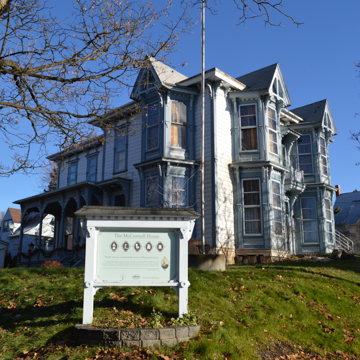
In 1886, entrepreneur William E. McConnell began building a two-story house, sunken garden, small carriage house, and barn for his family on an entire block in the Fort Russell neighborhood. Like other early Fort Russell residents, McConnell sited the house on the block’s most prominent corner, the intersection of Second and Adams streets, to showcase its eyecatching design and position his family at the center of Moscow’s social life.
The house reflects an eclectic blend of Victorian-era architectural styles including Eastlake, Italianate, and Gothic Revival. Rather than engage an architect, McConnell likely used plans from a pattern book and worked with a carpenter to integrate elements and detailing from the three styles. The resulting cohesive design made a unique statement in the fledgling city.
On the exterior, characteristically vertical proportions are expressed in several ways. Three two-story bays capped with slender gable roofs define its signature massing; windows and doors on each facade are correspondingly tall and narrow. As viewed from intersecting sidewalks and streets, verticality is further amplified by the site itself, which slopes steeply upward toward the house. Exterior ornamentation is extensive: decorative brackets support window bays and roof overhangs, and gable ends feature highly articulated wood ornamentation. Although the original clapboard siding has been replaced with metal siding, gable ends continue to display cedar shingles with sawtooth imbrication.
Both the spatial organization and interior detailing reflect a combination of Victorian-era influences. The original ground-floor plan featured front and rear parlors separated by wood sliding doors, a dining room, kitchen, pantry, and servant’s quarters. Four bedrooms and children’s playrooms were housed on the second floor. High ceiling heights prevail throughout the house. Windows feature interior wooden shutters (made in San Francisco) that serve to further accent vertical proportions in each room.
Consistent with the later Victorian era, appearance rather than quality weighed heavily McConnell’s decisions regarding finishes. Interior detailing was largely crafted from Moscow’s limited pallet of available materials. Locally prevalent fir and pine were used for interior millwork and flooring; the inexpensive wood was then painted with graining to create the appearance of more costly hardwoods. Similarly, the steel-backed fireplace in the back parlor was embellished with a thin veneer of Vermont marble bordered by gold leaf and black onyx trim.
The family fell into financial hard times following McConnell’s two-term governorship and the financial panic of 1893, during which he was forced to declare bankruptcy and close his downtown department store. To avoid losing the property, McConnell’s wife declared it an official homestead. The bank took ownership of the house in 1897 and it remained vacant until 1901, when it was purchased by William Adair, one of the community’s first physicians. Since the house was larger than his family required, Adair rented rooms to local entrepreneurs and university faculty. Frederic Church, a European history professor who, at one time, rented a room in the house, later purchased the building as his own single-family residence. The barn was sold and converted to a single-family residence in 1926. Church bequeathed the house to the Latah County Historical Society upon his death in 1966.
Since 1968 the house has served as both headquarters and museum for the Latah County Historical Society (LCHS). It provides one of the best remaining examples of Italianate and Eastlake architecture in the state of Idaho. Though compromised by some unfortunate decisions surrounding its ongoing maintenance, such as use of metal replacement siding, the McConnell House continues to communicate a significant architectural presence while serving in its adapted role as a museum.
Doyon, Annie, and Kathryn Burke-Hise, “Fort Russell Neighborhood Historic District,” Latah County, Idaho. National Register of Historic Places District Boundary Increase and Additional Documentation, 2015. National Park Service, U.S. Department of the Interior, Washington D.C.
Monroe, J. Moscow: Living and Learning on the Palouse . Charleston, SC: Arcadia Publishing, 2003.
Otness, L. A Great Good Country: A Guide to Historic Moscow and Latah County, Idaho . Moscow, ID: Local History Paper # 8, Latah County Historical Society, 1983.
Renk, Nancy. “W.E. McConnell House,” Latah County, Idaho. National Register of Historic Places Registration Form, 1974. National Park Service, U.S. Department of the Interior, Washington D.C.
Writing Credits
- Location: Moscow, Idaho Regional Overviews: Latah County Architect: William McConnell Types: single-family dwellings boardinghouses historic house museums (buildings) bay windows brackets (structural elements) Styles: Italianate (North American architecture styles) Eastlake Materials: clapboard siding millwork aluminum (metal)
If SAH Archipedia has been useful to you, please consider supporting it.
SAH Archipedia tells the story of the United States through its buildings, landscapes, and cities. This freely available resource empowers the public with authoritative knowledge that deepens their understanding and appreciation of the built environment. But the Society of Architectural Historians, which created SAH Archipedia with University of Virginia Press, needs your support to maintain the high-caliber research, writing, photography, cartography, editing, design, and programming that make SAH Archipedia a trusted online resource available to all who value the history of place, heritage tourism, and learning.
- About Our Authors
- SRAS: Study Abroad or Online
- GeoHistory: Geopolitics, History, News
- PopKult: Popular Culture
- Museum Studies: Museum Science, High Culture, City Planning
- Students Abroad: Travel Guides

Popular articles

View of the Kremlin and surrounding area from 1825. From The Album of Ancient Views of the Moscow Kremlin , by Ivan Zabelin. Available online from the Yeltsin Library .
The Kremlin: Moscow’s Historical Heart Through the Ages
Published: December 3, 2021
The Moscow Kremlin has long been the main symbol of Moscow and Russia – and for good reason. It was with the Kremlin that city of Moscow officially began and from which it grew. The Prince of Moscow, ruling from the Kremlin and drawing on the growing power of his city, united and conquered the cities and lands around him to create Russia.
While the Kremlin can be seen as something of a constant in Russian history, the Kremlin itself has seen major changes within its walls and to its own status. It has lost and gained buildings. It has changed from the seat of government to an ancillary structure, back to the governmental seat, and finally to a museum complex.
The resource below unites the work of multiple SRAS students writing on Home and Abroad , Challenge Grants , and Online Research Internships to bring you an overarching view of this iconic complex.
The Kremlin Walls
By Hudson Dobbs
The Kremlin was first established in 1156 by Prince Yuri Dolgorukiy. This post-dates the first mention of Moscow, which dates back to 1147, when Prince Dolgorukiy invited Prince Sviatoslav of Chernigov to Moscow to celebrate their alliance.
The actual site of this stronghold has likely been occupied since the second millennium BCE. It likely had fortifications built there as early as the 10th century, by the then-resident Vyatichi, a tribe of Slavic peoples.
Eventually, Prince Dolgorukiy ordered the construction of what would become the Kremlin walls. These first walls were tall and expansive and built out of wood. Although this structure was built for protection, it also served as a symbol for the power and strength of the new city of Moscow.
While the first walls did their job well, they were eventually burnt down by Tatar-Mongol forces and later upgraded to more fire-resistant oak in 1339. As the city grew, the Kremlin also further developed, and with it the popularity of building fortresses in town centers. Cities such as Smolensk, Kazan, Novgorod, and Pskov all constructed a Kremlin of their own. In fact, the word “kremlin” simply means “a fortress within a city.”
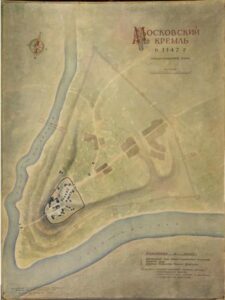
By the 13th century, the Kremlin housed the political and spiritual power of the state, with residences, workshops, churches, and state buildings all residing within its walls. In the 1360’s, Prince Dmitry Donskoy rebuilt the walls in limestone and a gleaming white Kremlin soon became the iconic image of Moscow. These walls were credited in helping the city defend itself from sieges by Grand Duke Algirdas of Lithuania in the late 1360’s.
The walls and towers that exist today are still another iteration, and were built on the order of Grand Prince Ivan III, also known as Ivan the Great, from 1485 to 1495. Ivan wanted to build something grander and more worthy of being his residence – something that would be comparable to Constantinople in terms of size and importance.
Wanting what would be specifically a “Third Rome,” Ivan invited Italian architects such as Aristotele Fioravanti and Pietro Antonio Solari. Their involvement is why the current fortress closely resembles castles of Northern Italy. Its red brick made the Kremlin unique for the time, as it was the first structure in Russia built from such material.
These brick walls have stood, with minor adjustments, since that time. One noticeable change came in the late 1600s, when Tsar Fyodor Alekseevich ordered the red brick to be whitewashed in limestone, returning it to gleaming white the city had been hitherto known for. Eventually, the whitewash stopped being maintained and was allowed to wear off, a process that was complete by the 1900s.
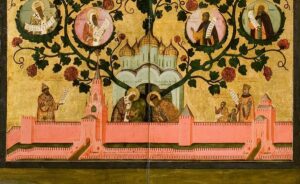
Grand Kremlin Palace Tour
By Jack Fisher
Formerly the Moscow residence of the Russian tsars, the Grand Kremlin Palace (not to be confused with the State Kremlin Palace) is a complex inside the Kremlin. It now hosts diplomatic meetings and official state ceremonies including presidential inaugurations. It is also designated as a residence of the President of the Russian Federation, but is rarely used for that purpose.
When SRAS gave me the opportunity to take an exclusive tour of this complex, which is an exclusive tour that is normally off-limits to the general public, I had to take it.
This particular tour is different from those that cover the more public areas inside the Kremlin and requires signing up early and submitting your documents for a security check.
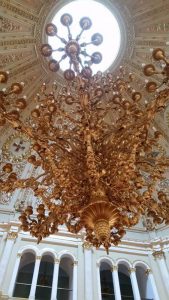
I met the tour group on a Friday afternoon in Aleksandrovski Sad, which borders the Kremlin walls. From there, we made our way towards the Kremlin grounds entrance. There was a huge line to get into the grounds through a first security checkpoint, but we were able to skip straight to the front of it since we had registered for our tour ahead of time. Once we were through the gate, the crowd thinned out significantly.
As we walked through the Kremlin grounds, we saw other tour groups taking photos of the landscaping, palace, and other historical buildings. Unlike us, they didn’t have the permission of the Russian government to enter the actual palace. When we got to the palace, we walked through the front doors, crossed a second security checkpoint, met our guide, and started the tour.
Our tour guide inside the building was a woman that worked in preservation. She only spoke Russian, so everything was translated for us by an SRAS-hired guide to English. We began on the first floor of the newer section of the palace and saw several ornate living rooms and guest rooms, followed by the empress’s and emperor’s chambers. Unfortunately, we weren’t allowed to see the emperor’s office and bathroom as President Putin had decided to use them as his personal study for the remainder of his time in office.
After the first floor, we headed upstairs to the second. From the outside the palace appeared to have three floors, but in reality the second floor just had massive, vaulted ceilings and two levels of windows. From what I saw, the second floor seemed to be where the fun happened. The first major room we walked into was the Hall of the Order of St. George, built to house major military meetings and balls and today used as a large conference room. There were names of famous military officers and soldiers inscribed on the walls, and the hall looked like it could hold hundreds of guests. Then it was on to the Hall of the Order of St. Vladimir, which was way less cool. It did, however, have the largest chandelier in the palace, for what that’s worth.
Next, we moved into the oldest section of the palace. It was built in the late 1400s and the newer sections of the palace were built out to connect with it. Our guide told us that by the time of the last czars, the older section was used strictly for ceremonial purposes. The walls were covered with paintings of historical rulers and religious figures. It was definitely my favorite room as there seemed to be an aura of timelessness hanging about the place.
Then we went back through the Hall of the Order of St. Vladimir and through another hall to the older bedchamber of the czar and an older, smaller meeting room for the czar and his nobles. This section was markedly different as there was none of the opulence of the newer palace. It had a utilitarian feel due to its practical layout with comfortable but plain looking chairs, reasonably sized paintings, low ceilings and large traditional Russian stoves.
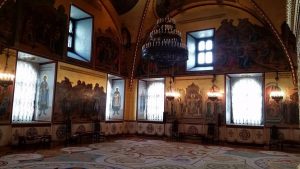
Finally, we visited the throne room. It was massive, just like the Hall of the Order of St. George, and had polished stone and gilding everywhere. Unfortunately, it was a reconstruction. Our guide let us know that the soviets had torn it apart when they came to power, creating what looked like a massive classroom to house the first meetings of the Soviet Congress. The Russian government had restored it completely within the past decade. She also let us know that the current heir to the Russian throne is Prince Harry of England, which is an interesting fact I’ve been surprising Brits with lately.
On our way out, we exited through a portrait hall. Most of the portraits were typical Enlightenment and Victorian era paintings with stuffy looking people. However, one painting caught my eye: the portrait of Knyaz Sbyatoclav. The man looked absolutely hardcore (and you can see him below in a photo I took).
In my opinion, it was definitely worth $75. While I wouldn’t go twice, the fact of the matter is that you get to see the inside of a beautiful building and stand in rooms that very powerful people meet in and have met in for hundreds of years – which is an opportunity that few regular people are given. Don’t think that it’s too expensive, because you’ll have the experience and memory with you for the rest of your life.
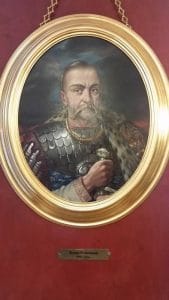
The Kremlin Without a Capital (1712-1918)
By Lee Sullivan
The Kremlin has always been a symbol of Russian power and authority. It is often used interchangeably with the Russian state in journalism and academic literature. This is not surprising considering the Kremlin is situated in the heart of Moscow and has typically housed Russian rulers and their offices – and continues to contain an official residence and office for Russian president Vladimir Putin. However, not all of Russia’s leaders have always called the Moscow fortress home. This article covers the nearly 200 years of Kremlin history when Moscow was not the capital.
Peter the Great moved Russia’s capital from Moscow to St. Petersburg in 1712. Despite the continued crowning of tsars in the Annunciation Cathedral and symbols of power in the Kremlin vaults, Moscow’s role in state life was minimal compared to that of the new capital. This changed when a new stage of construction began under Catherine the Great. Even though St. Petersburg was the new capital, she was crowned in Moscow following ancient tradition. A commission to replace the code of laws from Tsar Alexey Mikhailovich’s time was called in Moscow and its session was held in the Kremlin’s Faceted Palace. This was a sign that under Catherine the Great the state would be ruled from both St. Petersburg and Moscow. Additionally, the Senate was divided into departments under Catherine. Four were in St. Petersburg and two were in the newly commissioned Senate Building, which still stands in the Moscow Kremlin.
Catherine additionally planned a grand reconstruction of the Kremlin interior, one that would have seen most of its buildings demolished, save for the historic cluster of churches, and replaced with modern imperial architecture built with long, straight roads, much like St. Petersburg itself. Demolition was started, including to parts of the original Kremlin walls, when cracks began to appear in one of the cathedral walls due to the resulting disruption of the soil. Because of this, and because of the project’s already enormous cost, it was cancelled, and the original walls re-built.
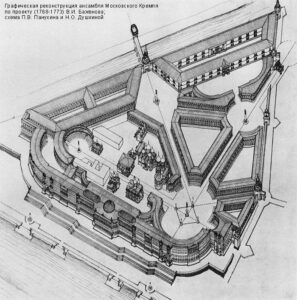
In September of 1812, French troops occupied Moscow. Napoleon, who led them, planned to occupy the Kremlin as his residence. It is widely thought that in defense against the French, the Moscow mayor ordered fires be set across the city. They raged for days so and were so intense that Napoleon was forced to leave the Kremlin due to the smoke. Upon returning he declared an intention to remain in the Kremlin for winter and ordered additional fortification of the Kremlin walls. However, the French army was weakening due to battle loss and poor supply.
Napoleon ordered his troops to retreat and blow up the Kremlin in the process. Mines were laid but their effectiveness was reduced by rain and prompt Muscovite response. Still, considerable damage was done, including to the Vodozvodnaya Tower, which was completely destroyed.
The Kremlin quickly underwent restoration under Tsar Alexander I and Nicolas I. Despite the war’s considerable drain on state funding, Tsar Alexander I prioritized restoring many parts of the Kremlin including towers, walls, palaces, and cathedrals. He often traveled to Moscow to observe the restoration progress. Many of Russia’s best architects were included in the restoration efforts. Order was progressively restored to the Kremlin and new gardens, now called the Alexander Gardens, were laid out along its exterior. Buildings like the Senate were brought back to their original appearance.
Restoration was completed under Nicholas I, who gave special attention to the restoration of ancient Kremlin churches and other old buildings. He also commissioned the construction of new buildings like the Great Kremlin Palace, after having the old one demolished. The entire imperial family attended the palace blessing during an official ceremony in April 1849. It was constructed and designed with techniques that were ahead of their time – vaulted construction for walls and ceilings, inlaid stone floors, and iron rafters.
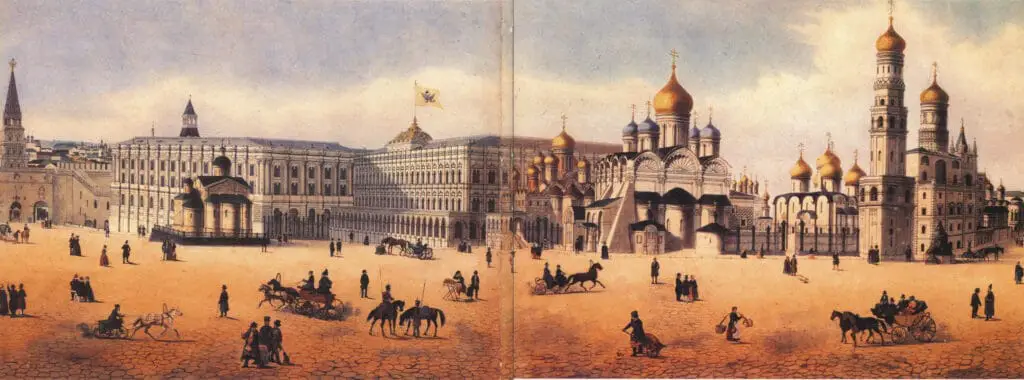
Shortly after the revolution, the Communists restored Moscow as the official capital in 1918 when Moscow was reinstated as Russia’s capital. Construction and restoration were completed by the mid-19 th century. During the Soviet years, the Kremlin housed Soviet leaders and saw the development and then dissolution of the Soviet state. Today the Kremlin stands in Russia’s capital as a unique architectural ensemble.
The Kremlin Under the Soviets
The new Bolshevik government made sweeping changes to the historic Kremlin complex to, as they saw it, better represent the character of the new socialist state.
During the revolution of November 1917, the Kremlin was ransacked, leaving it with broken glass, destroyed icons, and parts of the complex in disrepair. Restoration of the walls and towers began in 1918, but further restoration stalled for lack of funding and because the communists had not yet decided on a plan for their changes to their seat of government.
The first targets were churches and royal symbols. Nuns and monks who had long lived in the Kremlin were removed. Churches had valuables removed and transferred to the new Commissariat of Finances to fund state projects. Many royal treasures and even crown jewels were similarly transferred. The double-headed eagles on the top of the buildings were promptly removed.
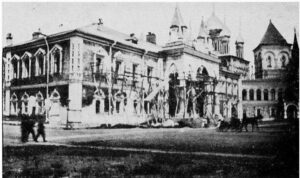
Many buildings were repurposed. Initially, many were converted to housing for Communist functionaries as the revolution and war had depleted Moscow’s housing stock while driving immigration from the countryside to the city. At one point, over two thousand people lived inside the Kremlin. By 1939, however, Kremlin residents consisted of only about three dozen high ranking officials.
Other notable repurposings included turning the Palace of Facets into a canteen with its kitchen inside the Tsarina’s Golden Chamber. The Ivan the Great Bell Tower was turned into a workshop, the Small Nicholas Palace became a worker’s club, and a gym was placed in the Church of St. Catherine. In 1932, the Andrew and Alexander Halls within the palace were gutted to make room for a party congress.
Many of the buildings and statues within the complex were destroyed, often to make way for new construction; only 26 of the original 54 buildings survived the Soviet period. The Chudov Monastery and Ascension Convent were both destroyed to make way for a military academy and eventually the Kremlin Presidium was built on the ground to house the Supreme Soviet, the supreme legislative body of the USSR.
In 1929, the Maly Nikolaevsky Palace, a former royal residence, was replaced by a new administrative building.
In the 1920s, the Russian royals buried in the Archangel Cathedral on the Kremlin’s Cathedral Square were exhumed and autopsied. They and the items in their sarcophagi were turned over to the Kremlin museum. Some valuable artifacts were requisitioned to the state treasury.
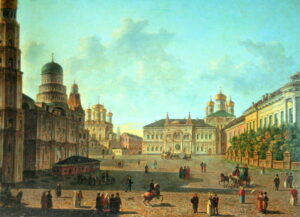
In 1935, five stars of rubied glass replaced the double-headed eagles that once topped the Kremlin gate towers.
Throughout WWII, the Kremlin was disguised under mock construction and painted roofs. Despite this, several bombs still fell on the Kremlin grounds, but did not cause major damage.
In 1947, Stalin painted the Kremlin walls red in an unmistakable ode to socialism, a drastic change from the traditional white that the walls had carried for centuries.
In 1955, the Kremlin opened to the public as an open air museum. In that same year, a ban on living in the Kremlin was introduced, lessening any security risk opening it to the public might create.
The last wave of demolitions came in 1958-1961, when the Palace of Congresses, built to house the congresses of Communist Party and cultural events, replaced the Old Amoury and part of the Patriarch’s Palace.
In part due to the outcry from this massive renovation, greater care of the Kremlin grounds began. The official Kremlin museum system was established in 1966, and Elena Gagarin, daughter of Yuri Gagarin, was hired as museum director. Today, that system includes the large armoury, several churches, and items outside of the Kremlin, such as St. Basil’s Cathedral.
The changes made during the Soviet period have left the Kremlin with a striking architectural contrast between traditional, tsarist-era architecture with Soviet-style buildings and the iconic, ancient red walls and remaining cathedrals. Despite the destruction and changes that were carried out, the compound still offers an unforgettable look into Russian and Soviet history that is impossible to get from anywhere else.
The Kremlin Stars
Translated by Caroline Barrow
The following was originally posted to the the Russian 7 website . It has been translated here by SRAS Home and Abroad Translation Scholar Caroline Barrow. Additional edits and updates were applied in 2021.
On October 24, 1935, two long-standing symbols of the Russian monarchy—the two-headed eagles which stood on top of the Kremlin towers, were ordered to be brought down and replaced with five-pointed stars.
Why a five-pointed star became the symbol of the Soviet regime is unknown, but what is known is that Lev Trotsky supported this symbol. Greatly fascinated by the esoteric, he knew that stars and pentagrams have a strong energetic potential and are one of the strongest symbols. The swastika could have easily become the symbol of the new government, since it had a strong following in Russia at the beginning of the twentieth century. Swastikas were displayed on the currency of the temporary government led by Alexander Kerensky, and swastikas were painted on the walls of Empress Alexandra Fedrovna’s Ipatiev House before the royal family was executed there. This swastika trend was stopped almost solely by Trotsky and the Bolsheviks, who opted for the five-pointed star. The history of the twentieth century even showed that stars are stronger than swastikas… Stars shone over the Kremlin, in the place of two-headed eagle.
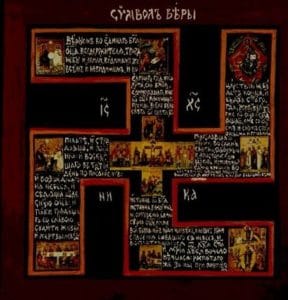
Erecting the thousand-kilogram stars on the Kremlin towers was not a simple thing to do. The problem was that the needed technology did not exist in 1935. The smallest of the Kremlin Towers, Borovitskaya, rose to 52 meters, and the tallest tower, Troitskaya, reached a height of 72 meters. Throughout the country, there were no tower cranes capable of reaching these heights. However, for Russian engineers, the word “no” did not exist, only the phrase “we must.” Engineers designed and built special cranes that could be installed on the upper deck for each tower. A metal base, called the console, was mounted at the base of each turret window, and on each console the engineers mounted a lifting crane. Thus, the process occurred in several stages: first the two-headed eagles were dismantled, and second, the stars erected.
Each star weighs about one ton. Given the height at which the stars would be placed and the fact that each star has a surface area of 6.3 square meters (potentially excellent for catching the wind), there was a danger that the stars might be blown away along with the top of the towers. So, it was decided to stress test the towers and, it turns out, with good reason: the upper part of each tower and its console was completely destroyed in the process. So, builders reinforced the masonry at the upper levels of the towers, and for the Spasskaya, Troitskaya, and Borovitskaya Tower, metal bracing was added to the base of the tower. The console on Nikolskaya Tower was so damaged that it had to be completely rebuilt.
All the stars were not made identical; four stars differ from one another in their artistic forms. On the Spasskaya Tower star, rays go out from the center. However, on Troitskaya Tower’s star, the rays look like spikes. The star on Borovitskaya Tower is made up of two contours, one inscribed in the other, and, finally, the rays on Nikolskaya Tower’s star have no pattern. In terms of length, the Spasskaya and Nikolskaya Towers were similar, with the distance between the ends of the rays being about 4.5 meters. On Troitskaya and Borovitskaya Towers, the star rays were shorter, and the distance between the ends of the rays was less, measuring 4 and 3.4 meters, respectively.
A star is good, but a spinning star is twice as nice. Moscow is large, its people many, and all must see the Kremlin stars. For the base of each star, special bearings were produced by the First Bearing Plant. These special bearings allow the stars to rotate with the wind even despite their significant weight. Consequently, it is possible to know the direction of the wind given the position of the stars.
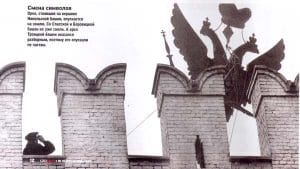
Installation of the Kremlin Stars was a true celebration for Muscovites. The stars were not carried under the cover of night to Red Square. The day before the stars were placed on the towers they were put on display in Gorky Park. District and City Secretaries of the Communist Party came together with the ordinary mortals below to see the stars. The stars were lit from the outside to make the Ural stones shine and the rays sparkle. The eagles, taken off the towers, were also displayed to visually demonstrate the dilapidation of the “old” world and the beauty of the “new” world.
The Kremlin stars were not always ruby glass. The first stars, installed in October, 1935, were made from high-alloy stainless steel and red copper. In the center of each star, on both sides, the stars were embedded with precious stones outlining the hammer and sickle emblem. Over the course of a year, the glitter of the gems dimmed. The stars were also found to be too big, not fitting well with the architectural ensemble. In May, 1937, it was decided to install new, illuminated glass ruby stars. Also, they added a star to a fifth tower, the Vodovzvodnaya Tower. The ruby glass was produced at a factory in the city of Konstantinov, according to the method of the Moscovite glassmaker, N. I. Kurochkina. It was necessary to prepare 500 square meters of ruby glass, and for that, a new type was invented—selenium ruby glass. Before that, gold was used to color the glass; selenium was cheaper and produced a deeper color.
The Kremlin stars don’t only rotate, they also light up. In order not to overheat and cause damage, about 600 cubic meters of air is blown through the stars per hour. The stars are not affected by power outages, because they have their own, independent generators.
For the original lighting, the Moscow Electrical Lamp Plant produced the lights for the stars. The stars on Spasskaya, Troitskaya, and Nikolskaya Towers all had 5000-watt bulbs, and the other two operated at 3700 watts. In each star, two parallel filaments were installed. That way, if one burned out, the other filament still shone and a control panel is was notified of the burnout.
To change a bulb, one need not need to climb up to the star. Rather, the bulb comes down on a special rod that runs straight through the bearing. The whole process takes 30-35 minutes. In the stars’ history, the stars stopped shining only twice—once during the war, and another time for the filming of the now-classic movie The Barber of Siberia .
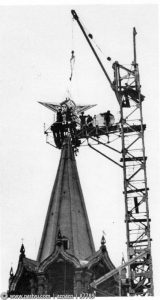
Editorial Note: Update 2021. Starting in 2015, the lighting of the Kremlin stars was updated with one star’s lighting system replaced each year. The old incandescent lamps were replaced with modern metal halide lamps. These lamps are approximately four times more energy efficient than the old bulbs and provide a more intense, higher-quality light. Metal halide lamps are often used for sports stadiums and other places where strong, high-quality light is needed.
In preparation for this switch, Employees of the Central Scientific and Restoration Design Workshops (TsNRPM) measured the illumination of each arm of each star separately to make sure that each would still be lit evenly and brightly. They also created models of the stars lit with various methods including LED matrices and optical fiber. In the end, metal halide was determined to be the closest in historical appearance to the existing incandescent lamps.
Within this update, each star was also given its first compressive maintenance since 1946. Damaged panes were replaced, the stars were cleaned inside and out, and the lubricants within the rotation system were replaced with modern fluids.
The State Kremlin Palace
By Benjamin Bradley Mulick
Finished in 1961 after three years of work, the Palace of Congresses, later renamed as the State Kremlin Palace (not to be confused with the Grand Kremlin Palace), opened its doors for the first time for the 22nd Congress of the Communist Party of the Soviet Union, welcoming thousands of party delegates as well as communist leaders from around the world. Today, it is still the Kremlin’s newest building and a multipurpose facility, housing large conventions, cultural displays from around the world and even its own ballet troupe. With these functions giving it continued purpose, the Kremlin’s most modern and out of place building is also one of its most significant.
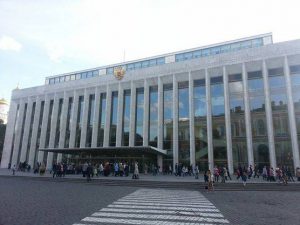
The Kremlin State Palace stands out from the gilded, pastel buildings around it with its hulking angular lines, and large windows divided by tall marble columns. It’s crowned by a glass banquet hall, which was the brainchild of Khrushchev himself.
It features three main halls: The Great Hall, the Small Hall, and the Diplomatic Hall. The Great Hall is the largest, featuring the palace’s main stage and hosting its most important events. With a seating capacity of six thousand, it is where party congresses were held, and where some of Russia’s most prominent cultural programs take place today. The Small Hall hosts smaller musical performances, and by virtue of having removable seating, also hosts dance events, such as the World Cup of Latin American Dance, as held in June of 2021. The Diplomatic Hall provides a smaller and more intimate setting in which to enjoy performances. Last but not least, the Diplomatic Hall often hosts lesser-known artists, often performing genres that do best in closer settings, such as jazz and folk.
The facility also holds many smaller meeting rooms, intended as breakout rooms for conventions, but also used for various purposes today.
The construction of the State Kremlin Palace came with considerable controversy. Not only is it stylistically wildly inconsistent with the rest of the Kremlin’s buildings, one of Russia’s most oldest and most important historical ensembles, but it also resulted in the destruction of several older buildings to make ways for the Palace’s massive presence.
The demolished buildings included the Old Kremlin Armory Building, originally built in 1851 to house the Kremlin’s ceremonial guard and a collection of state documents and treasure. The northern wing of the Patriarchal Chambers was torn down, formerly part of the private quarters of the head of the Russian Orthodox Church.
Because these were officially designated historic buildings, the legality of razing them was questionable and likely would not have taken place had not the decision been made from the office of Khrushchev himself.
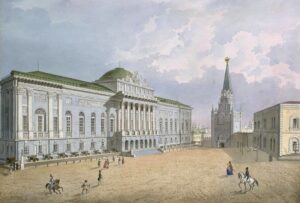
Perhaps the real loss, however, came from underground. The original plans for the palace, before the Second World War, envisioned it as truly massive facility built where Christ the Savior Cathedral now stands. In the Khrushchev era, it was planned to build a smaller but still very large building near MGU, along the river, in what were then the still-developing outskirts of the city. When Khrushchev decided to place it inside the Kremlin, its footprint was again shrunk and it faced restrictions on its height so that the view of the Dormition Cathedral would not be entirely lost.
To make up for this, the bottom part of the building was sunk sixteen meters into the valuable archeological depths of the Kremlin’s soil. The buildings torn down to make room for the Palace were themselves built over much older foundations.
Archeologists were given a short window to explore the former Palace of Natalya Narishkina, the mother of Tsar Peter I, as well the former sites of churches, royal kitchens, workshops, and studios in what was once an economic center based within the historic Kremlin.
Teams of archaeologists were assigned to the area, who, in addition to expected finds, also found a number of secret tunnels. Unfortunately, while the archaeologists did their best to learn and preserve what they could, the limited timeframe allowed by the construction of the State Kremlin Palace meant that the archaeological potential of the site was, in large part, wasted. The tunnels were filled in, the old foundations built over, and the ruins lost to history.
Today, the Palace is perhaps best known as the home of The Kremlin Ballet, which was specifically formed in 1990 under esteemed Russian artist and choreographer Andrey Petrov with the purpose of performing there after the Bolshoi Ballet stopped performing at the palace and returned to the Bolshoi, then under renovations.
While the Kremlin Ballet was created with a strong basis in the classics, they have made more recent contributions to the ballet world with a number of their own classically-inspired modern works, including a ballet adaptation of Mark Twain’s The Adventures of Tom Sawyer .
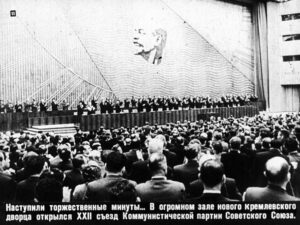
The State Kremlin Palace also hosts the Moscow Classical Ballet, which has been dancing in Moscow since 1966. Demonstrations of this tradition in the upcoming year will include the Moscow Classical Ballet’s dancing reinvention of Romeo and Juliet (which was considered scandalous when it was first performed in 1972), and a performance of Swan Lake , one of Russia’s most important contributions to dance, as performed by the Kremlin Ballet.
Built to hold important political events, the State Kremlin Palace is more a cultural building than a political one. The stage’s relatively short history promises to be subsumed by its promising future. Whatever the next big musical or cultural phenomenon in Russia is, the State Kremlin Palace will be a part of it.
- Read a review of The Snow Maidan as performed at the State Kremlin Palace on this site.
A Tour of the Moscow Kremlin Today
Tour as reviewed by Helen McHenry, 2019
As part of our SRAS cultural program, we were given the opportunity to take a tour of the Kremlin, a historic complex and symbol of the Russian government. We met our guide outside of Red Square before walking along the Kremlin walls to the visitors’ entrance. She pointed out the swallowtail merlons bordering the wall, a design popular in 15th century Italian-style architecture, before we mounted the battlement. To travel behind the Kremlin walls, we crossed a bridge that used to span the Neglinnaya River but today acts as an archway covering part of the footpath.
Inside the Kremlin is an intriguing mix of old and new – from the 15th century walls to the 20th century block of modernism known as the State Kremlin Palace. Our guide informed us of the controversy over the palace’s design, which stands in such contrast to the more traditional styles surrounding it. The building, built under Khrushchev’s leadership primarily as a government meeting hall, has almost as many floors underground as it does above ground. Although many cried out against the building when it was built, it still stands today, where it is now used mainly to host concerts.
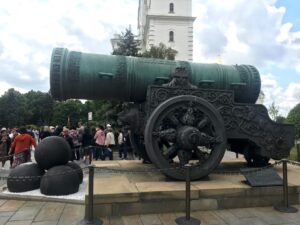
A brief walk along a path lined with cannons from the state artillery collection brought us to what appeared to be the mother of all cannons. Indeed, the Tsar Cannon is the largest bombard by caliber ever manufactured and has never been used due to its vast size. Just around the corner lay a similarly large but unused item – the Tsar Bell. Commissioned during the time of Empress Anna, niece of Peter the Great, an almost life-size image of her adorns the bell’s surface.
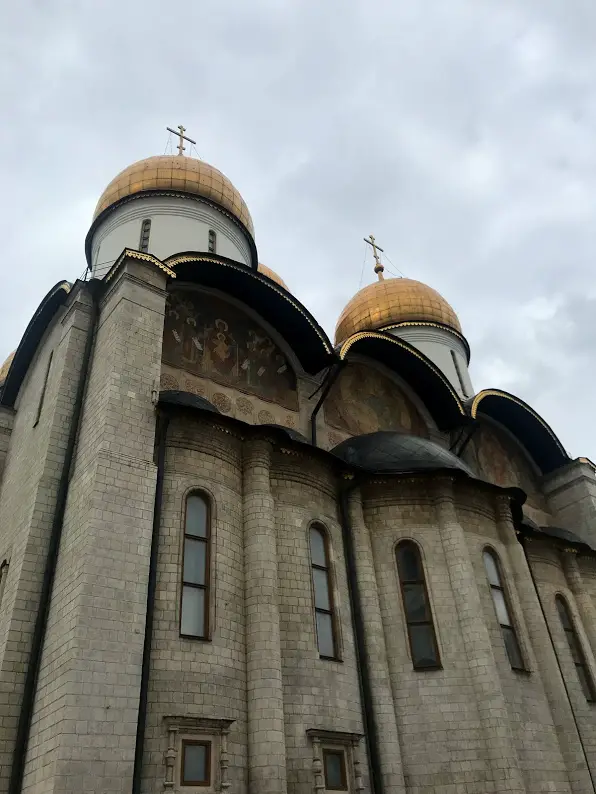
We then traveled to Cathedral Square, which, as its name suggests, features a number of beautiful cathedrals. The overcast day did nothing to accentuate the gold domes that capped their many towers, but no amount of gloom could dim their impressive stature – so immense that photographing them from my vantage point proved a challenge. Each cathedral was adorned with more stunning iconography than the last, overwhelming to the point of monotony as we shuffled through the throngs of tourists.
Our next visit was to the State Armoury, a neoclassical building resplendent with the wealth of the tsars. We traipsed through room after room of riches, from icons, dishware, and diplomatic gifts to clothing, carriages, and thrones. What stood out to me the most was the two distinct – and sometimes warring – natures of Russian identity on display at the Armoury, East and West. The contrast was particularly obvious amongst the collections of clothing, weaponry, and thrones. The older pieces hearkened back to the time before the Western pivot of Peter the Great. While these remained just as ornately decorated as their modern counterparts, they were, on the whole, a lot less outlandish than those done in the styles of the West.
The Armoury marked our last stop within the Kremlin, so we traveled across the city center to the Cathedral of Christ the Savior. Although the cathedral is the world’s largest Orthodox church, the current building is not the original. Christ the Saviour was demolished under the reign of Stalin and was only rebuilt in the late 1990s. Since then, the cathedral has gained fame as the site of Pussy Riot’s 2012 performance, which landed three members in jail for “hooliganism.”
Our guide let us explore the church on our own, as the church requires groups to be led by its own guides. Looking forward to lunch, we opted for a quick pass through the cathedral. Had I not been so hungry, I could have spent hours inside, as every surface held intricately-painted religious imagery intermixed with adornments heavily gilded with gold. Photographs were not allowed within the cathedral, reserving this spectacle to be seen first-hand.
The Kremlin in its entirety is a spot I recommend to all visiting Moscow, as four hours within its walls was not enough for our group to even scratch the surface of the wonders within.
Tour as Reviewed by Joseph Ozment, 2016
As part of SRAS’s Russian as a Second Language (RSL) program at Moscow State University, I had the opportunity to attend a guided walking tour of the Kremlin and its museums. We had a professional tour guide provided by SRAS who was very well informed about all aspects of the Kremlin’s sites and always willing to answer questions.
The tour, as offered by SRAS each session, can differ slightly based on availability and timing. We began our day’s tour not at the Kremlin, but at the nearby Cathedral of Christ the Savior, Russia’s largest Orthodox cathedral and one of the largest Christian structures in the world. Note that there are wardrobe requirements for entering the church (men and women both must have their shoulders covered, while men cannot wear shorts and women must wear skirts at least beneath the knee).
Before going inside, we were taken around the massive structure, and given a brief yet informative overview of its history. We learned that, despite the classical style of the building, it is actually only about 20 years old, having been constructed to resemble the church that once stood on the same ground.

During Communist times, the ground on which the Church now stands was a massive swimming pool, having been filled with water after the original Church was destroyed. The plans that the Communists originally had for the site were to construct the headquarters of the Communist Party of the Soviet Union, which would be one of the tallest structures in the world and house the office of the Soviet Union’s premier inside the head of a giant Vladimir Lenin statue adorning the top.
The Cathedral is a truly stunning structure. Comparable only to St. Peter’s Basilica in Rome in my mind, the sheer amount of open air is amazing when one considers how still and tranquil it is on the inside.
We then continued onwards to the Kremlin itself, which was teeming with guided tours from all over the world, just like ours. Seeing other groups from America, but also some from France, Italy, China, and several other European and Asian countries was very interesting, as people tend not to think of Russia as a popular tourist destination. However, tourism here has grown rapidly in recent years, particularly since the ruble lost about half its value on world markets, making Russia a much more affordable location.
Anna informed us of the purposes of all of the first structures we encountered within the Kremlin walls. First of all, though, she made sure that we were aware that the word “Kremlin” does not refer just the center of government in Moscow, but is a general word that means fortress. Most Russian cities and towns of reasonable size and with a medieval history possess a Kremlin.
We saw one of the offices in which President Putin occasionally works, as well as the large, semi-controversial event and concert hall that resides just inside the main entrance to the Kremlin. Despite its modern style that clashes somewhat with the comparatively ancient structures around it, the fact that the building is covered in glass at least ensures that it reflects the beauty and history that abounds within the Kremlin.
After seeing the aptly named Tsar Cannon and Tsar Bell, both of which are two of the largest objects of their kind in the world, and neither of which have been used for their structural purpose in their existence, we moved on to see several of the many churches that stand within the walls of the Kremlin.
Inside the Church of the Annunciation, we were informed of some of the basic components of any Russian Orthodox Church. For starters, every inch of wall is covered in some image or another, from icons of Saints to giant murals that depict judgment day and the people of earth being sent either to heaven or hell. We also learned that the altar in an Orthodox church is given its own room, to which only the priests are allowed entry. The mysticism that is native to Orthodoxy and inherent to its liturgy was embodied in all aspects of these churches.
After our tour of the Kremlin’s outside squares, we were taken on a tour of the Armory Museum, which houses outfits, household items, carriages, armor, weapons, and various sundry items that belonged to the Tsars and Tsarinas of Russia. Anna knowledgeably led us through the various styles worn by different Russian rulers, and explained the significance(s) behind the appearance of what they wore and the carriages in which they rode.
We were in awe of the beautiful jewels that encrusted everything the royals wore and every vessel out of which they drank or off of which they ate, not to mention of the thrones on which they sat. We saw gifts from foreign dignitaries and rulers, and even the museum’s collection of Faberge creations.
All in all, it was a day rich with history and made even more enjoyable by our friendly and incredibly knowledgeable tour guide, Anna. There is hardly a more essential Russian experience to have during your time in Moscow than a guided tour of the Kremlin.
Incidentally, Anna, a guide that SRAS has worked with for years, helps run a guiding collective in Moscow called Bridge to Moscow . They run many private tours and are available for custom tours and travel as well.
Latest Updates
By Josh Wilson
In addition to the changes to how the Kremlin stars are lit and renovations to the Kremlin bells in Spasskaya Tower , for instance, several recent events are of interest.
In the mid-2000s, the Russian Orthodox Church lobbied for the restoration of the Chudov Monetary and the Ascension Convent within the Kremlin walls. The idea was seriously considered and even discussed on television by President Vladimir Putin, although only in the sense of rebuilding them as cultural monuments and part of the museum complex, rather than as working religious institutions. In the end, however, the Kremlin Presidium was simply torn down in 2016 and the area left mostly open with fragments of the old foundations left under glass for viewing. The result is a Kremlin even more dominated by open space and gardens.
Wind has damaged the Kremlin walls on a few occasions. In June 1998, several of the iconic sparrow tail structures on the wall were damaged by strong winds. In April 2018, strong wind damaged the Senate Palace roof. In October 2021, scaffolding being used to restore a section of the inner wall was blown over the top of the wall, also damaging several of the iconic sparrow tail structures. In all cases, the damage was quickly repaired.
You Might Also Like
The Moscow Kremlin has long been the main symbol of Moscow and Russia – and for good reason. It was with the Kremlin that city of Moscow officially began and from which it grew. The Prince of Moscow, ruling from the Kremlin and drawing on the growing power of his city, united and conquered the […]
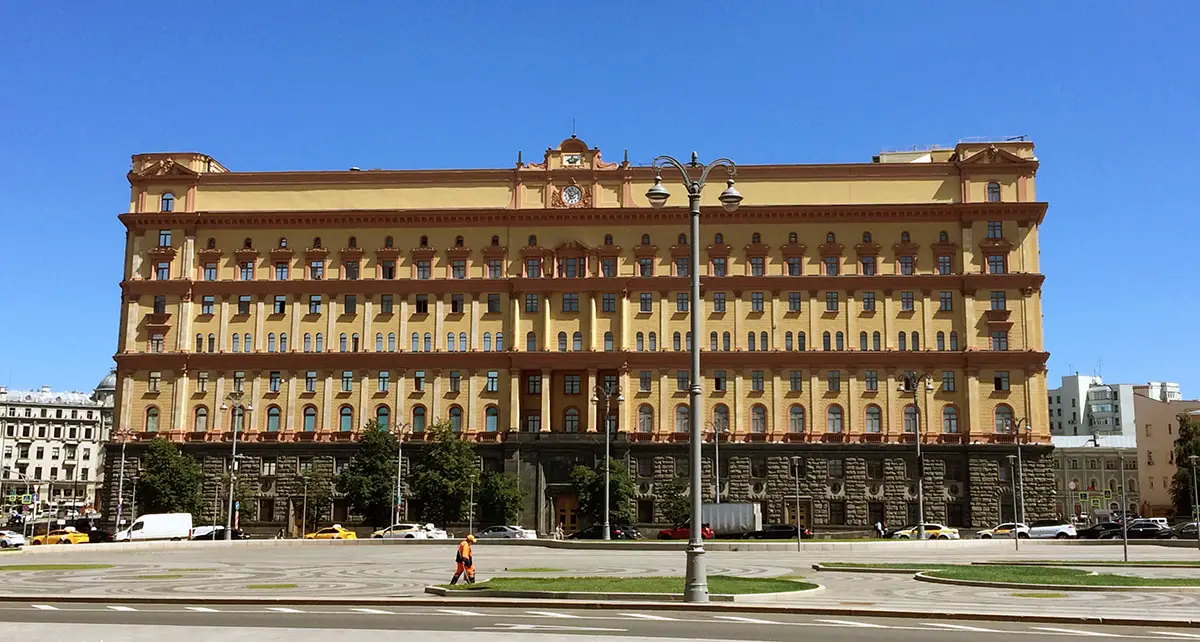
Lubyanka: Inside the Story of Moscow’s Infamous Building and District
There is always history surrounding us. In a city like Moscow, this can seem overwhelmingly apparent. Moscow has many imposing buildings from many eras – some are immediately recognizable and others only invite wonder as to what stories lay behind their beauty or grime. Lubyanka is the name commonly used to refer to the building […]
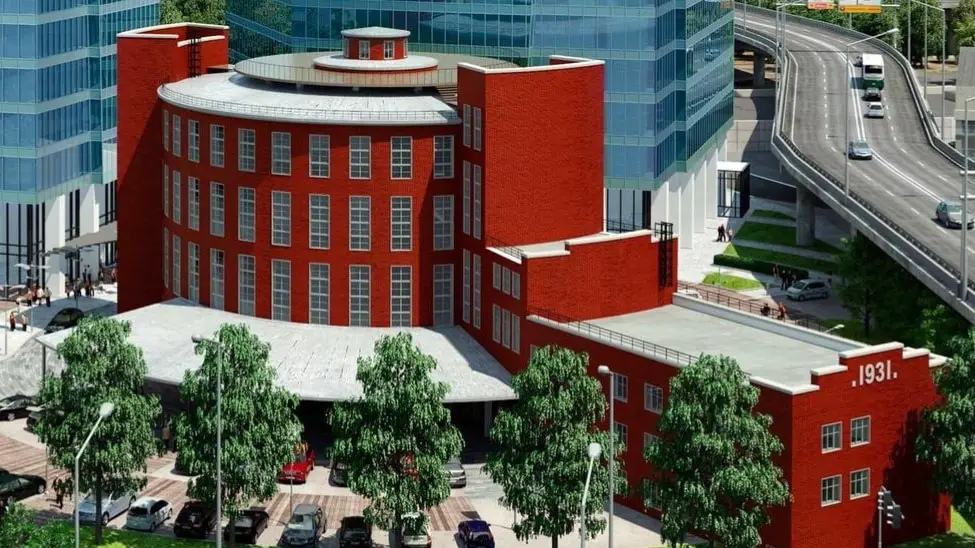
Supermetal: The Latest in Moscow’s Urban Redevelopment
By the end of 2020, the founders of Khlebozavod9 and The Brusov Ship will open a new public space near Baumanskaya metro station in Moscow. A former industrial zone will host the Supermetal Cultural and Business Complex. The team’s plans call for two architectural monuments, laboratories with panoramic windows, three courtyards, and some small manufacturing […]
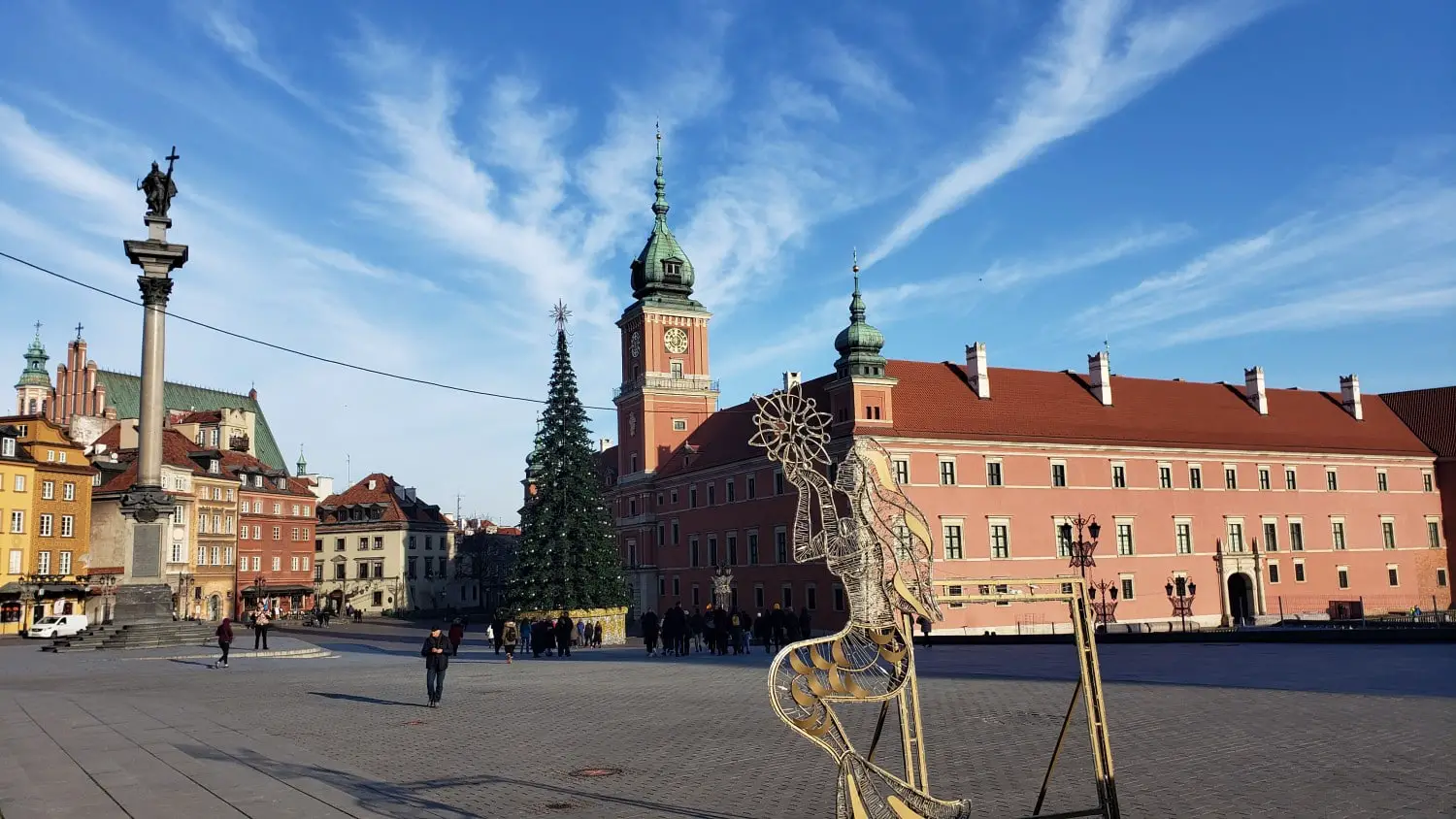
Warsaw’s Old Town District
While I was on study abroad in Warsaw, Poland, the place I visited most behind the Palace of Culture and Science, where I had classes every day, was Old Town. Why? Simply put, a trip to Old Town in Warsaw is like taking a journey back in time. It is the gem of the city […]

A Day in Tashkent’s Old City: Travel from Bishkek with SRAS
As part of SRAS’s Central Asian Studies program, students had the opportunity to travel to Uzbekistan for a full week. The first day of this week-long expedition began with a half-day tour of Tashkent’s old part of town. We were accompanied by our guide, Donat, or “Don” for short. He had outstanding English, and even […]

About the authors

Serena Keenan
At the time she wrote for this site, Serena Keenan was a rising junior at Smith College in Northampton, MA. She was majoring in Russian, East European, and Eurasian Studies with a minor in Government and a concentration in Translation Studies. She hoped to study abroad in Moscow during the spring 2022 semester. After college, she hoped to go on to work in nuclear nonproliferation. In her free time, she likes to read and crochet.
Program attended: Online Interships
View all posts by: Serena Keenan

Caroline Barrow
Caroline Barrow is a graduate of Texas A&M University with a degree in International Studies and Russian. She loves traveling and hearing people’s stories. Out of the places she’s been able to visit, her favorite was Kiev, Ukraine for its beauty, history, and friendly people. She received a Fulbright English Teaching Assistantship and, at the time she wrote for this site, was spending year teaching English in Kostanay, Kazakhstan. Additionally, she was been named SRAS’s Home and Abroad Translation Scholar for the 2013-2014 cycle. Her contributions included mostly translations of articles and blog posts that will be of interest to students.
Program attended: Home and Abroad Scholar
View all posts by: Caroline Barrow

Lee Sullivan
Lee Sullivan is an undergraduate student at Stetson University. She is currently pursuing a BS in cybersecurity and a BA in Russian, East European, and Eurasian studies. Next semester Lee will be in Vladivostok, Russia – studying the Russian language and participating in the Home and Abroad internship with SRAS. She aspires to pursue a master’s degree upon graduating.
View all posts by: Lee Sullivan
Benjamin Mulick
Ben Mulick, at the time he wrote for this site, was a fourth year Global Studies major at the University of Wisconsin–Milwaukee.
View all posts by: Benjamin Mulick

Jack Fischer
Jack Fischer, at the time he wrote for this site, was majoring in Physics with Russian and Economics minors at Iowa State University of Science and Technology in Ames, Iowa. He is studied Russian as a Second Language with SRAS over the summer of 2016 to improve his command of the Russian language. In the future, he’d like to work for himself and run a business, preferably abroad.
Program attended: Challenge Grants
View all posts by: Jack Fischer
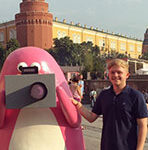
Joseph Ozment
Joseph Ozment is a fourth-year International Studies and Russian Studies major at Rhodes College in Memphis, TN. He is minoring in music minor and has spent a lot of free time on music projects. He is studying Russian as a Second Language and also working an internship with The Moscow Times. He hopes to increase his Russian skills and cultural awareness so as to use his knowledge of the country and language in a professional setting in the future.
View all posts by: Joseph Ozment
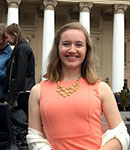
Helen McHenry
Helen McHenry, at the time she wrote for this site, was a double major in international relations and Russian at the Ohio State University, with minors in Spanish and public policy. She studied with Russian as a Second Language with SRAS at the Higher School of Economics in Moscow in order to advance her proficiency in Russian and appreciation for Russian culture. She hoped to use the knowledge gained during her time abroad to advocate for foreign policy that strengthens relations between East and West in her future career.
View all posts by: Helen McHenry

Julia Brock
Julie Brock, at the time she wrote for this site, had returned to University of Kentucky to pursue a Global Studies Certificate, with an emphasis on Russia and the travel industry. She earned prior BA and MA degrees in psychology. A few years ago, she traveled to Russia, Estonia, and Finland, and loves the culture and history of these areas. She works at the campus library, and enjoys reading, running 5Ks, and spending time with her dogs. She lived for five years in Minnesota and loved the snow, winter sports, and Museum of Russian Art.
View all posts by: Julia Brock

Hudson Dobbs
Hudson received his BA in Russian Studies with a minor in Corporate Communications from Baylor University. At the time he wrote for this site, he was serving as a Home and Abroad Scholar as part of a Spring, 2022 session of SRAS’s Language and Society program St. Petersburg. While abroad, Hudson will be researching the Russian coffee culture, as well as the evolution of specialty coffee in Russia. His goal is to open his own coffee shop in the US - taking his experiences abroad and applying them to his future business.
View all posts by: Hudson Dobbs
- Bahasa Indonesia
- Slovenščina
- Science & Tech
- Russian Kitchen
7 Russian cities with original historical centers (PHOTOS)

Inside the Kolomna kremlin
1. St. Petersburg

While Moscow was rebuilt many times and still keeps changing, the northern capital’s center is a gem that has stayed more or less since tsarist times. The city’s many palaces were built in the 18th and 19th centuries, while the main street, Nevsky Prospekt, still looks almost the way it did back in the early 1900s. The rivers and canal embankments evidenced history and even the “airy iron-casted fences” praised by Alexander Pushkin in The Bronze Horseman poem are still the same.
2. Suzdal, Vladimir Region
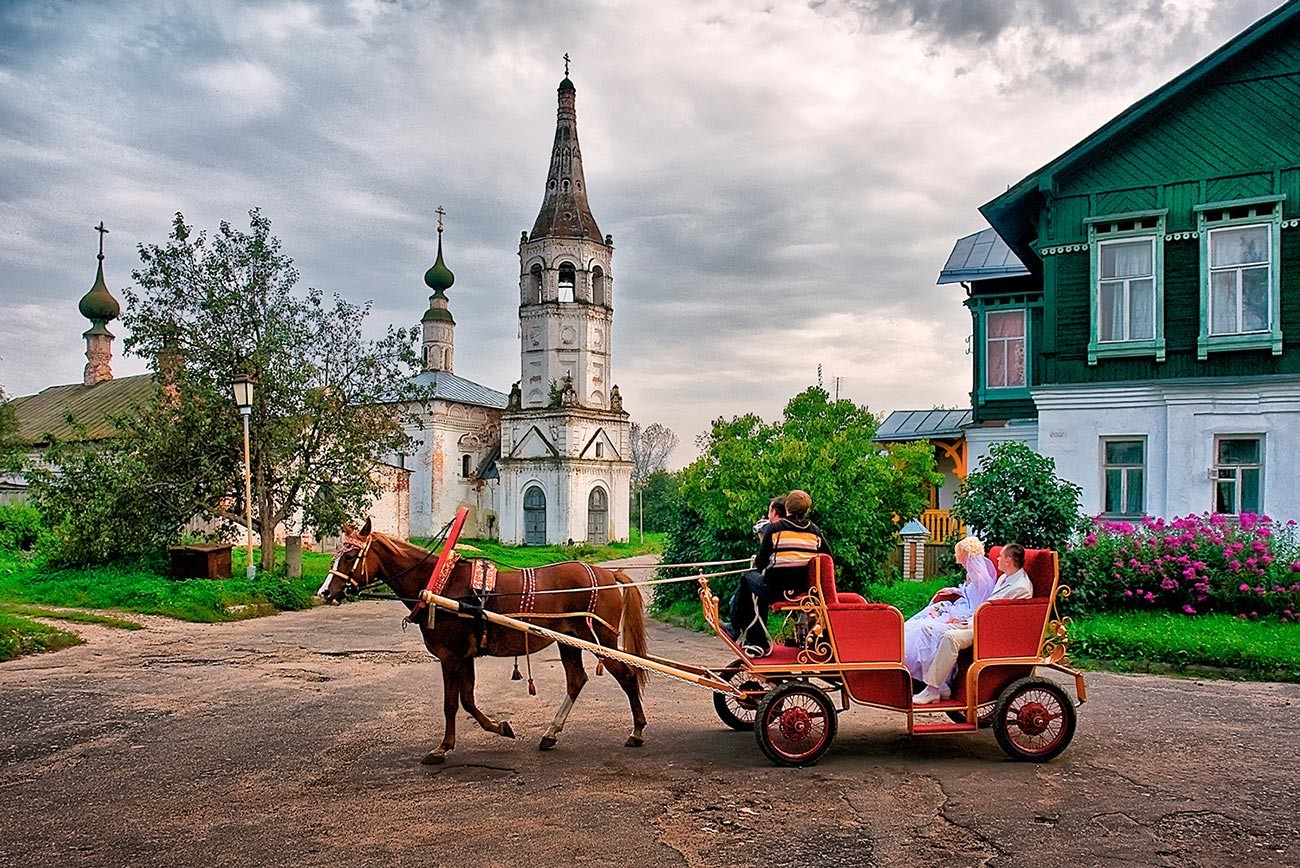
One of the most popular tourist destinations, this city is a pearl of the Golden Ring route. Actually, the whole route consists of ancient cities with old centers. Suzsal is a very cozy city with a true Russian spirit, small wooden houses, churches, monasteries and restaurants serving traditional cuisine (often with a little modern spin). Probably the most weird looking thing in this city is a Soviet-era square and the monument to Vladimir Lenin that had to be erected everywhere in the USSR in the turbulent 20th century.
3. Yaroslavl

This is a rather big ancient city along the Golden Route that evidenced lots of historical events and, in 2010, marked one thousand years since its founding. The whole historical center of Yaroslavl is a UNESCO heritage site as an example of Catherine the Great’s urban planning. The center structure resembles a fan, with a semi-circular square and the Church of Elijah the Prophet in the middle, and several long straight streets that diverge like rays from the square.
4. Yelets, Lipetsk Region
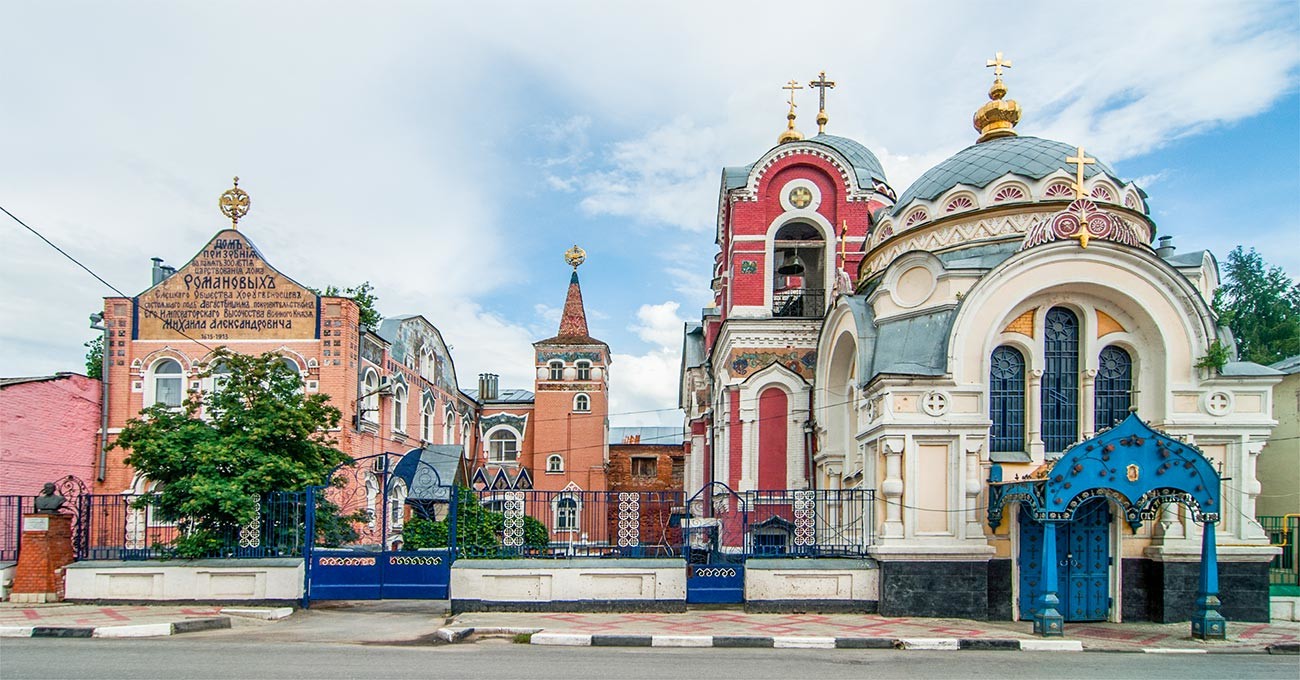
Alexei Zadonsky (CC BY-SA 4.0)
The city in Lipetsk Region was founded in 1146, a year before Moscow. It used to be a rich merchant city with lots of old red brick buildings. This small fairy tale city isn’t an important economical hub now, but it’s still famous for its lace production and beautifully decorated nalichniki , the window surrounds of wooden houses.
5. Tobolsk, Tyumen Region

In the 16th and 17th century, the city used to be the eastern-most Russia’s citadel. Built as a stronghold for developing Siberia, it was considered to be Siberian capital and was an important trade point between Asia and Moscow. The main city’s attraction is the historical center and its kremlin. Built in the 17th century, it’s the only stone kremlin in Siberia. Next to it is a prison where many people were exiled to in the 19th century.
6. Kolomna, Moscow Region
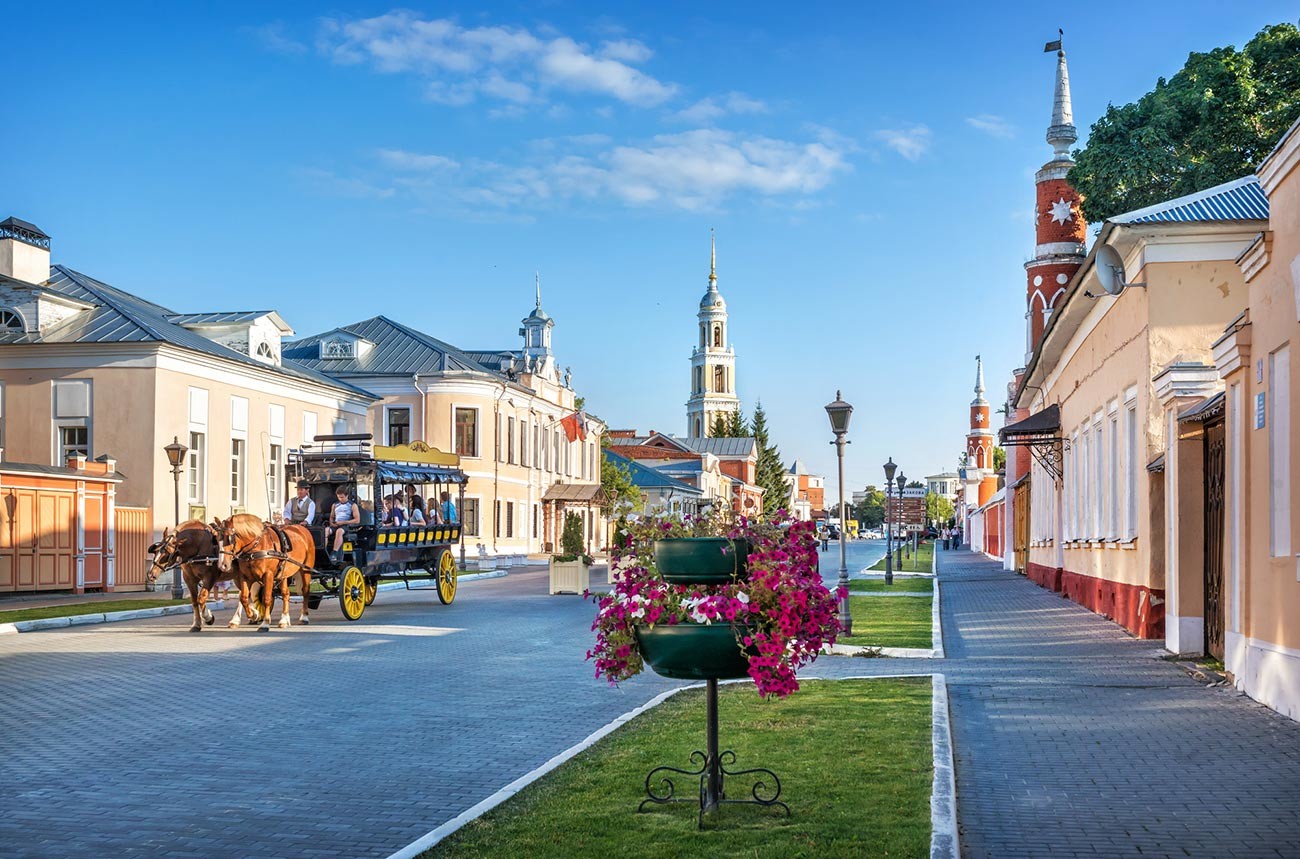
This cozy ancient city not far from Moscow has lots of monasteries and churches, just like many other Russian cities. But, the true pearl of Kolomna is its splendid red brick kremlin with massive walls. It is not a quiet museum, but is full of life, just like it used to be in tsarist-era merchant times. And there is still an operating store with ancient Russian street food - kalachi .
7. Kazan, the Republic of Tatarstan
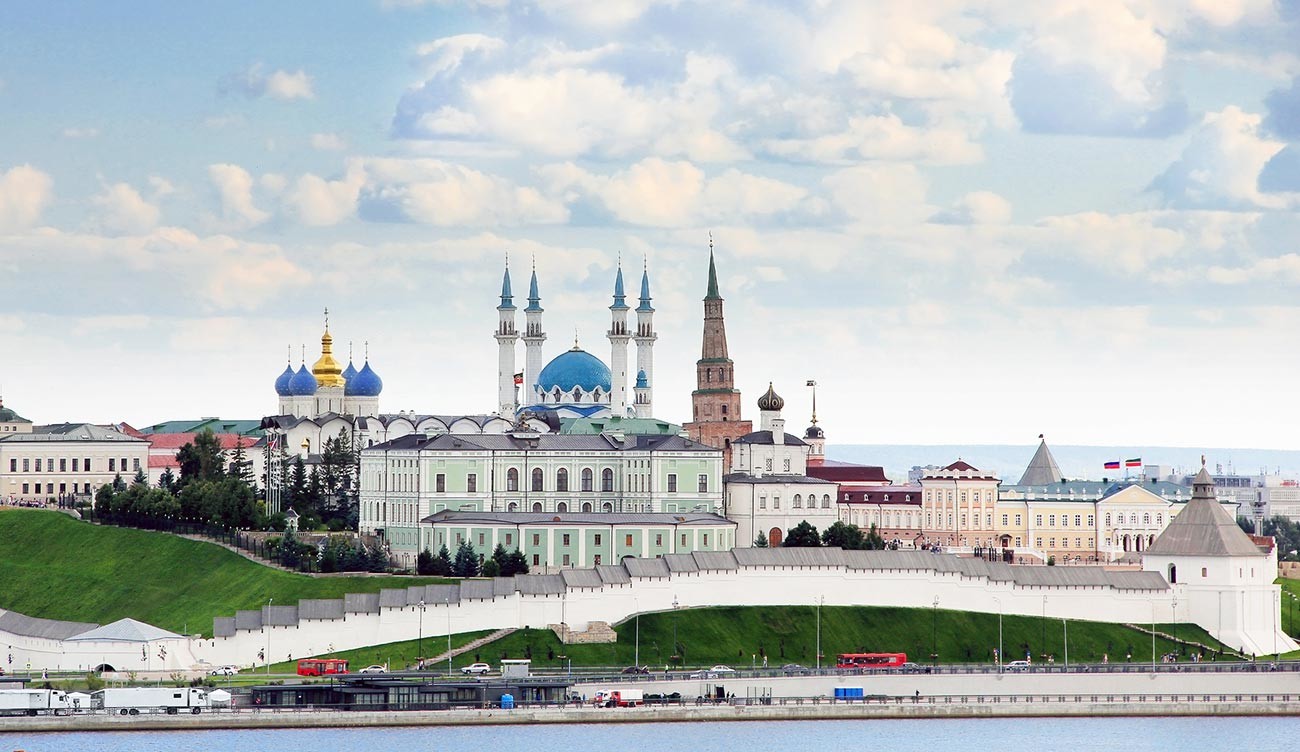
The current capital of Russia’s republic of Tatarstan was once conquered by the Russian tsar Ivan the Terrible. It is a unique city, which blends the artefacts of the Russian Middle Ages with those from the Muslim world. Inside the Kazan Kremlin, the Orthodox Annunciation Cathedral neighbors a beautiful Kul Sharif Mosque, which was newly built , but it “reincarnates” the legendary mosque that was destroyed by Russians in the 16th century.
If using any of Russia Beyond's content, partly or in full, always provide an active hyperlink to the original material.
to our newsletter!
Get the week's best stories straight to your inbox
- 10 things you must do in Kazan
- Yaroslavl: What to see in the Golden Ring 'capital'
- Suzdal: What to see in the 'most Russian' city in the world
This website uses cookies. Click here to find out more.

Galveston Steampunk Festival leans into island's natural Victorian-era vibes
S teampunk enthusiasts hide in plain sight. Enthralled by Victorian-era aesthetics and machinery, their numbers are legion: Steampunk Tendencies , a Facebook group affiliated with the eponymous website, counts upwards of 666,000 members. And last spring, about 1,500 of them descended on the Galveston Steampunk Festival , a number organizer Johnny Steverson expects to better this weekend when the second-year event returns to the Galveston Railroad Museum .
“We do surprisingly have a large steampunk presence in Houston,” he said. “There are no other steampunk events out here, so no one has really had an opportunity to gather to express their love for steampunk. I think that's one of the things that also made this event very popular and well-attended: people were hungry for a steampunk festival, something dedicated and committed to steampunk.”
For the uninitiated, steampunk is a retro-futurist subgenre of science fiction that “imagines how different the past might have been had the future come earlier,” in the words of Canadian author Douglas Fetherling. The word itself was coined by Fetherling’s peer K.W. Jeter in a 1987 letter to Locus magazine discussing his 1979 novel Morlock Night .
“Personally, I think Victorian fantasies are going to be the next big thing, as long as we can come up with a fitting collective term…,” Jeter wrote. “Something based on the appropriate technology of that era; like ‘steampunks,’ perhaps…”
For his part, Steverson imagines steampunk as “what the world would be like if everything was powered by steam instead of gasoline or petroleum.” And yet, in a part of the world still dominated by the petrochemical industry, he believes Galveston’s Victorian architecture and unique brand of retro-futurism make it an ideal location for steampunks to gather as well.
"Galveston was built [by] Victorian industrialists who used steam-powered machines and new fabrication methods to drive the development out here,” he said. “So for those that kind of think about it, it's a natural fit.”
There is some precedent for the festival’s success: steampunks have had a significant presence at Dickens on the Strand for many, many years. An events planner, PR whisperer, filmmaker, and entrepreneur (he has quite the LinkedIn bio ), Steverson says he had the idea of throwing a steampunk festival a few years before moving to the island in 2019. After a gaming convention he coordinated with the city went well, he turned his attention to steampunk. His instincts paid off.
“We had a line around the front of the Railroad Museum and down the side of the Railroad Museum,” Steverson said of last year’s event. “For me as an organizer and putting [in] blood, sweat and tears and all that stuff, it makes me very happy to see that it was so well-received.”
Steverson has expanded this year’s festival to include a Friday-night steampunk pub crawl and numerous Sunday events at the Kempner-League Mansion, a historic Victorian home—one of the last of Galveston’s so-called “Broadway Beauties”—now undergoing extensive renovations.
He’s also planning to devote even more space to last year’s surprise hit: teapot races , in which a remote-controlled car outfitted with a teapot on a plate must navigate an obstacle course while cheering onlookers cough up cash for the “bribe jar” (which actually goes to charity).
“I didn't expect that to be so popular, but that pulled the crowd,” Steverson said. “My God, was everybody hooting and hollering and excited."
Other activities include a steampunk bazaar with more than 50 vendors; author panels; professional photo sessions; “Tea on the Train” experiences; brief rides on the Harborside Express; Model T golf-cart tours; aerial silks and fire performances; and live music by steampunk favorites Frenchy and the Punk, a Brooklyn duo that suggests Siouxsie & the Banshees cross-bred with Squirrel Nut Zippers.
For all the nocturnal steampunks, the festival is also partnering with local ghost-tour outfit Spooky Galveston to offer midnight vampire tours . And it should go without saying there will be a costume contest; first prize is an aerial tour of the island via biplane operated by Scallywag Air . Costumes are actually not mandatory, but Steverson expects 90 percent of the crowd to come decked out anyway.
“We're talking about elaborate, Comic-Con-style costumes,” he said. "These guys really get into it. There was a guy with steam coming out of his top hat, and people with these huge mechanical steampunk wings. It was quite the spectacle.”
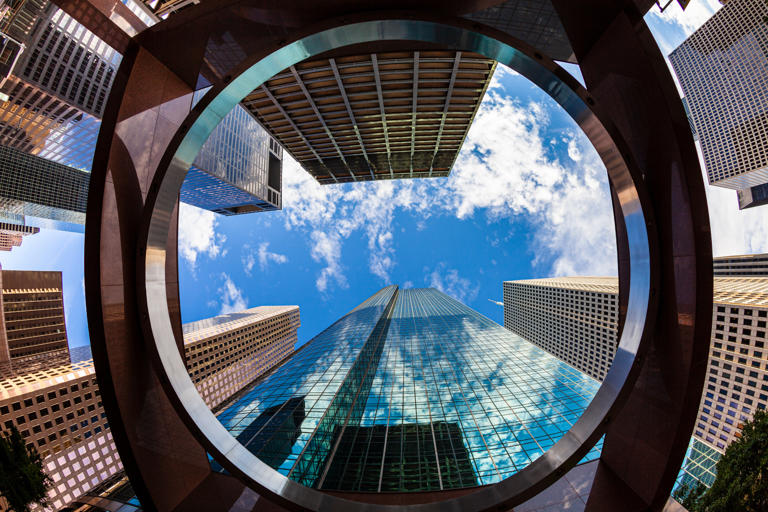
- Share full article
Advertisement
Supported by
Chance Perdomo, Star of ‘Chilling Adventures of Sabrina,’ Dies at 27
Mr. Perdomo, who died in a motorcycle accident on Friday, played the pansexual warlock Ambrose Spellman in the Netflix series.

By Aimee Ortiz
Chance Perdomo, the British actor known for his roles in the series “Gen V” and “Chilling Adventures of Sabrina,” died on Friday. He was 27.
Mr. Perdomo died in a motorcycle accident, Larissa Saenz, his representative, confirmed in a statement on Saturday. The statement did not say where the accident occurred but said nobody else was involved.
Mr. Perdomo played the pansexual warlock Ambrose Spellman in the Netflix series “Chilling Adventures of Sabrina” and Andre Anderson , a superhuman with magnetic manipulation abilities, in “The Boys” spinoff series “Gen V.”
He was born on Oct. 20, 1996, according to his representative, in Los Angeles and raised in Southampton, England. Details on survivors were not immediately available.
Mr. Perdomo had described himself as “a Black child raised by a Latino mother in a white society with two nationalities.”
He landed a small part on an episode of “Hetty Feather,” a British children’s drama set in the Victorian era, after graduating from Peter Symonds College in Winchester, where one of his majors was theater.
He told The New York Times in 2020 that although the role was “one or two lines,” it was enough “to take that leap of faith” and pursue acting full time.
Amazon MGM Studios and Sony Pictures Television said in a statement posted to a “Gen V” social media account that they were “devastated” by the news of Mr. Perdomo’s death.
Variety reported that production on the second season of “Gen V” had been “delayed indefinitely” after the news of Mr. Perdomo’s death.
In Britain, Mr. Perdomo was known for starring in “ Killed by My Debt ,” a television movie based on the true story of a young courier who dies by suicide after two traffic tickets grow into a crushing debt.
In an interview posted on social media , he recalled a conversation he had with his mother when he was about 2 years old. He told her he had two things he aspired to.
“She said, ‘What do you want to be?’” he said. “I said I want to be the first Black president of the United States, and I want to be on ‘Barney.’”
Of his recent work, Mr. Perdomo said: “It’s been quite a year. Quite a couple of years.”
“Visual mediums are great tools to be able to get messages and get thoughts across,” he added.
He said that connecting with someone emotionally could help lead a person to think differently and “that can change perspectives and hopefully lead to more of a permanent change.”
Aimee Ortiz covers breaking news and other topics. More about Aimee Ortiz

IMAGES
VIDEO
COMMENTS
The late Victorian period of imperial expansion saw a particularly close relationship between travel writing and the successful colonial adventure stories of writers such as Henry Rider Haggard (b. 1856-d. 1925), Rudyard Kipling (b. 1865-d. 1936), and Robert Louis Stevenson (b. 1850-d. 1894). Individual travelers such as the adventurer ...
During the 19th century, England was part of the British Empire. Travel was not only for pleasure, but also for conquest or exploration. Colonial travel was reserved for men, who had a more active ...
There are some fascinating exhibits relating to the Victorian era, the expansion of the railways in Britain and how the passenger experience changed. ... Despite the sub-standard accommodation, railway travel was hugely popular. According to the Railway Times, in the first six months of 1839, the London to Birmingham railway carried 267,527 ...
Travelling generally around the world boomed during the early to late Victorian era. According to Stowe (1994), "many nineteenth-century Americans traveled, and many more participated vicariously in the experience of travel by reading travel letters, sketches, and narratives in newspapers, magazines, and published volumes" (p. 3).
But even people and animals could travel in it. Victorian era Bicycles. By the late 1800s, bicycles were popular and widely used for commuting. As it was a personal transport, women could wear clothing suited the cycling activity. Phaeton was an open carriage drawn by horses. It was light and had four-wheels.
Like all aspects of Victorian life, tourism was a product of the Industrial Revolution, allowing entrepreneurs and service providers to make money by exploiting an ever-growing desire for travel. The world, once so vast, seemed to shrink, with access to every known place in a period when exploration was revealing new territories.
International travel was becoming easier but wasn't accessible to all, so the Victorians chose to spend this newfound "free" time in the UK. This gave way to the creation of hot new holiday ...
10. Shanghai. When the First Opium War ended in 1842, Shanghai became a boomtown. Situated at the mouth of the Yangtze, it was perfectly placed as the gateway for the West, and especially imperial ...
The Victorian era marked, in a very real sense, the dawn of "tourism." Prior to that period, travel for any distance was difficult and uncomfortable, and often expensive. The average person did not travel for fun or entertainment; one undertook a journey only if it was absolutely necessary. But the 19th century brought a host of improvements to ...
Victorian era, the period between about 1820 and 1914, corresponding roughly to the period of Queen Victoria's reign (1837-1901) and characterized by a class-based society, a growing number of people able to vote, a growing state and economy, and Britain's status as the most powerful empire in the world.
Travel during the Victorian era was expensive and extremely time-consuming. Typically only upper class people had the wealth and leisure time to travel abroad. Starting in the mid-1800s, wealthy and elite Britons began to consider North America as a travel destination since popular destinations in Europe had become more accessible to middle ...
After four months exploring the lakes at the foot of Mount Kilimanjaro, this flamboyant Victorian-era traveler returned to publish a narrative of her travels in East Africa from "sultan to sultan" illustrating the effectiveness of what she deemed a "womanly" form of (less violent) colonial conquest. Shepherd is reader supported.
During Queen Victoria's reign (1837-1901), London's population grew at an astonishing rate. London's centre became increasingly congested. Read more about public transport in Victorian London - on the surface. At the start of the nineteenth century there were no buses or railways in London. The city was compact, and its narrow streets crowded.
The travel writings of the 19th century are known to be full of exaggeration, specifically about the violent tendencies of the native peoples. Victorian women often painted a picture in which African peoples were savages waiting to be tamed and trained to live better lives (Stevenson 10). Marie Postans, an English traveler, represents many of ...
Martyn Pring. 28 Feb 2020. 1890s saw significant strides in express train carriage development with improved comfort and passenger facilities ensuring longer rail journeys could be enjoyed rather than endured. Most people believe luxury train travel was the product of the 20th century's inter-war years. While it is true that some of the most ...
Read more about public transport in Victorian London - underground. London's population was about 1.7 million when Queen Victoria was crowned in 1837. Mainline railways in the 1840s and 1850s brought even more people into the Capital. ... It could take an hour and a half to travel five miles from Paddington to Bank by horse-drawn omnibus.
"Hitting the Road! Travel Experiences and Narratives of the Victorian and Edwardian Era" (conference announcement with select bibliogrpahy) University of Tours, France (2-3 February 2023) Related Material on Other Sites. Livingstone online — a digital museum and library; Bibliography. Note: See also under individual explorers. Bridges, Roy.
The advent of the railroad and steamships in the Victorian era made traveling much easier. In the Victorian era, there were already unchaperoned traveling women, such as Ida Pfeiffer - the travel blogger of the Victorian era! 😉 While Edwardian women and men sometimes preferred trips by bicycle.-> Edwardian Bicycle Costume
The Victorian Era was a time of vast political reform and social change, the Industrial Revolution, ... starting the steam-powered railway boom and revolutionizing travel. Feb. 10, ...
v. t. e. In the history of the United Kingdom and the British Empire, the Victorian era was the reign of Queen Victoria, from 20 June 1837 until her death on 22 January 1901. Slightly different definitions are sometimes used. The era followed the Georgian era and preceded the Edwardian era, and its later half overlaps with the first part of the ...
The house reflects an eclectic blend of Victorian-era architectural styles including Eastlake, Italianate, and Gothic Revival. Rather than engage an architect, McConnell likely used plans from a pattern book and worked with a carpenter to integrate elements and detailing from the three styles. The resulting cohesive design made a unique ...
This early image of Moscow's modern Kremlin walls was created by icon painter Simon Ushakov in 1668. The walls are built of red brick and have layers of forification. This painting by P. Balabin from 1766 shows the walls after they were whitewashed. By 1884, most of the whitewash had flaked away.
1. St. Petersburg. Legion Media. While Moscow was rebuilt many times and still keeps changing, the northern capital's center is a gem that has stayed more or less since tsarist times. The city ...
Steampunk enthusiasts hide in plain sight. Enthralled by Victorian-era aesthetics and machinery, their numbers are legion: Steampunk Tendencies, a Facebook group affiliated with the eponymous ...
Chance Perdomo, the British actor known for his roles in the series "Gen V" and "Chilling Adventures of Sabrina," died on Friday. He was 27.